This document provides a formative and outcome evaluation report of the El Sistema Mitchell Music Program pilot conducted from October 2013 to April 2014. The program was a partnership between the University of Michigan schools of Music, Social Work, and Education with Ann Arbor Public Schools to provide string instrument instruction to 22 fifth-grade students at Mitchell Elementary. Data collected through surveys, interviews, videos, and academic records found that students significantly improved in feelings of acceptance and school engagement. Students also exceeded academic growth benchmarks in reading and math. Challenges included attendance, balancing individual/group instruction, and expanding opportunities to all students. The program provided benefits to both students and University instructors.
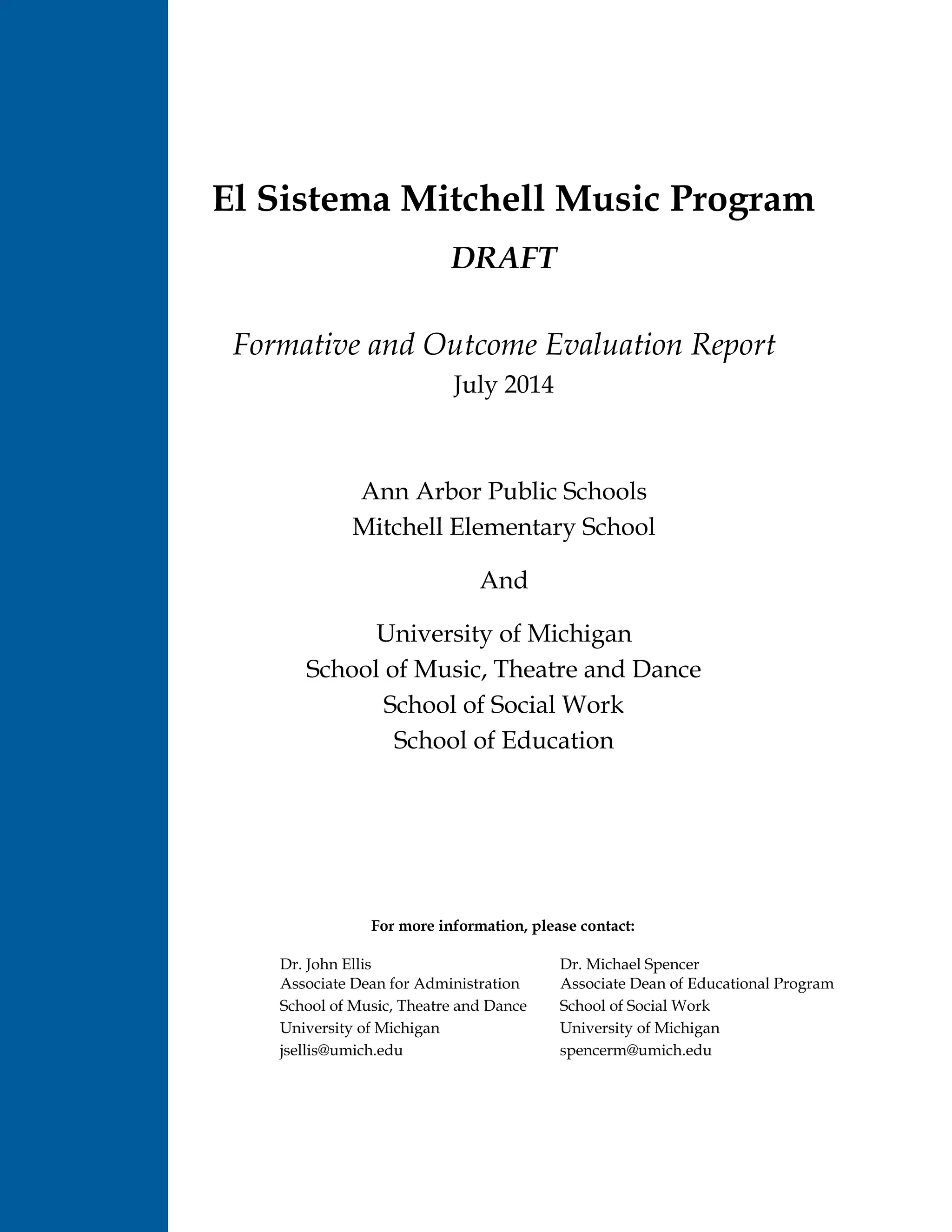
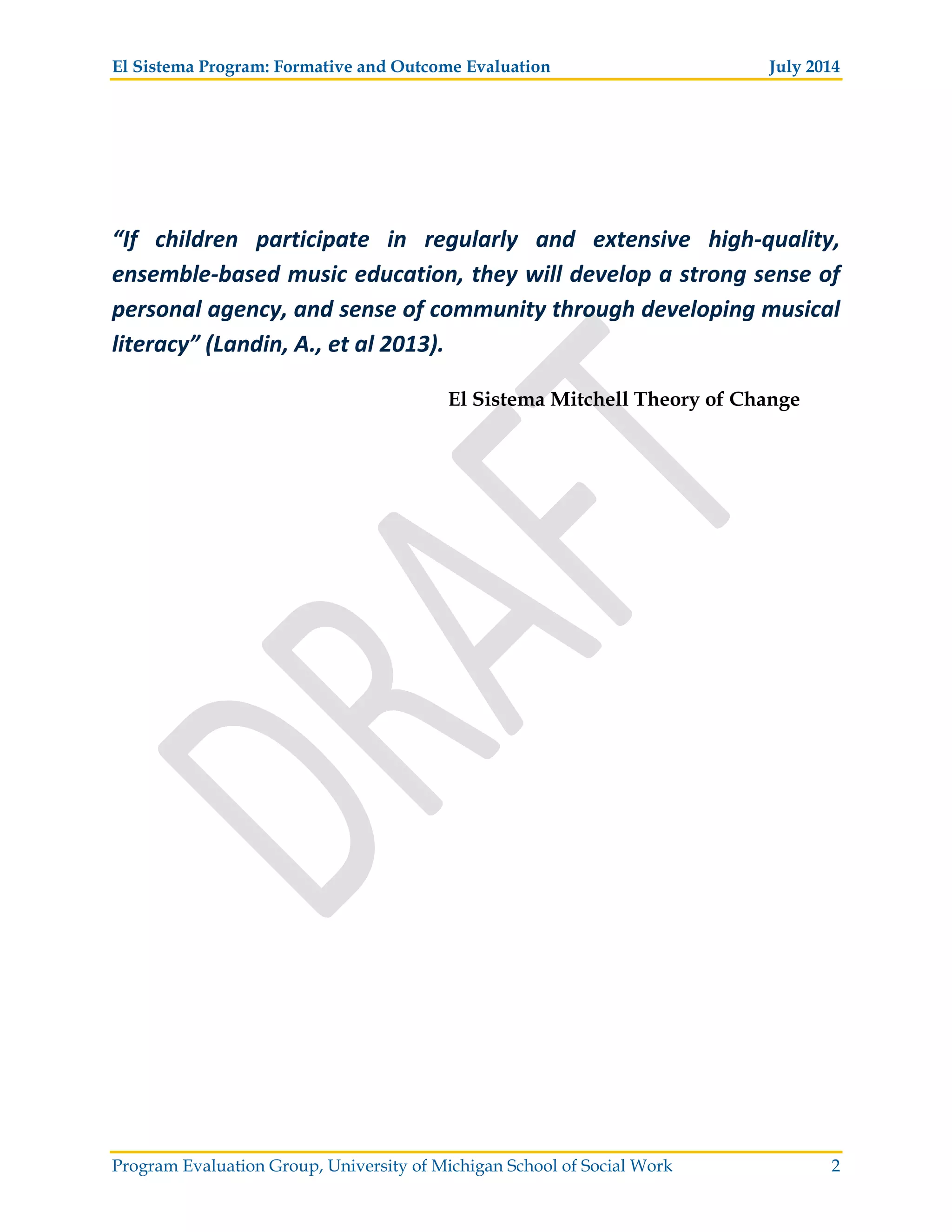
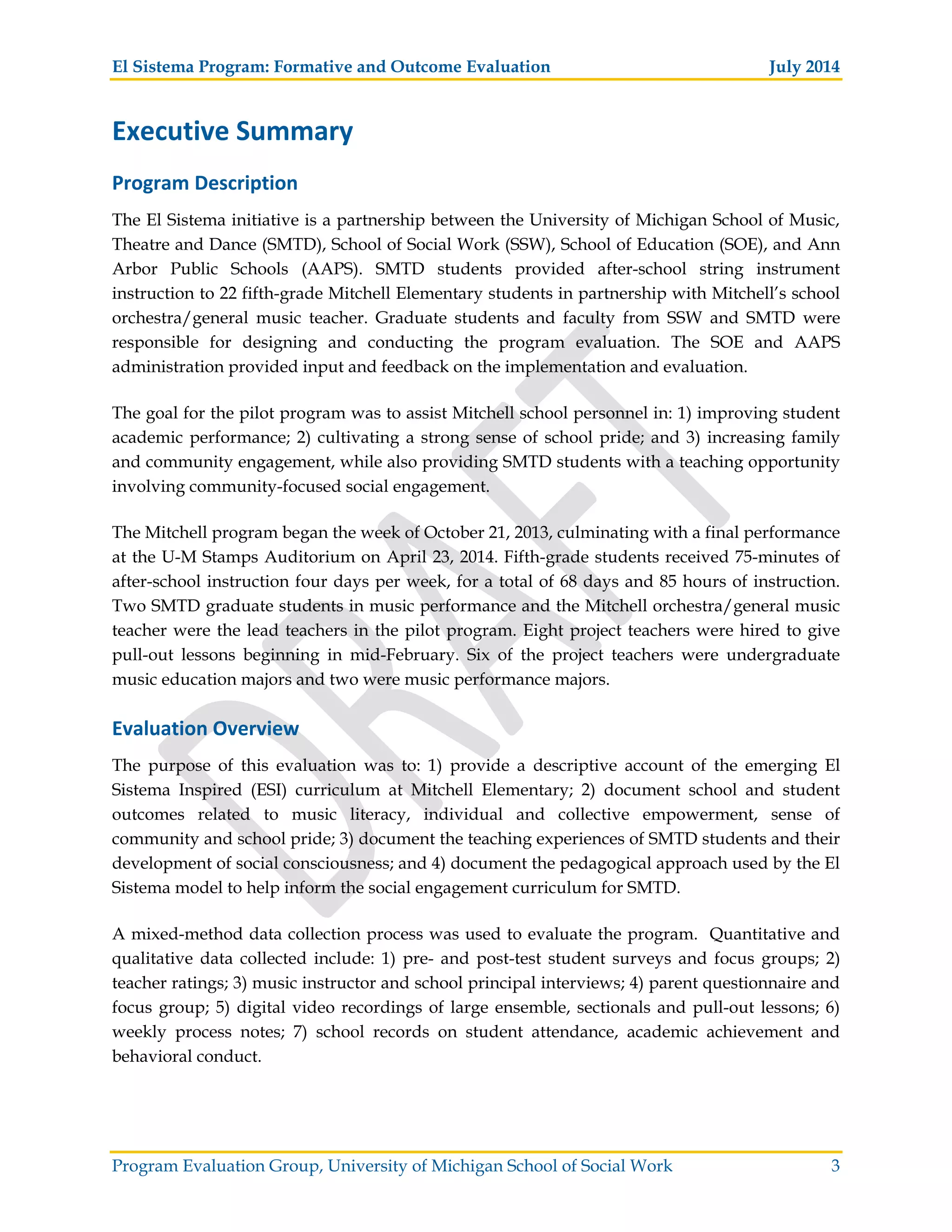
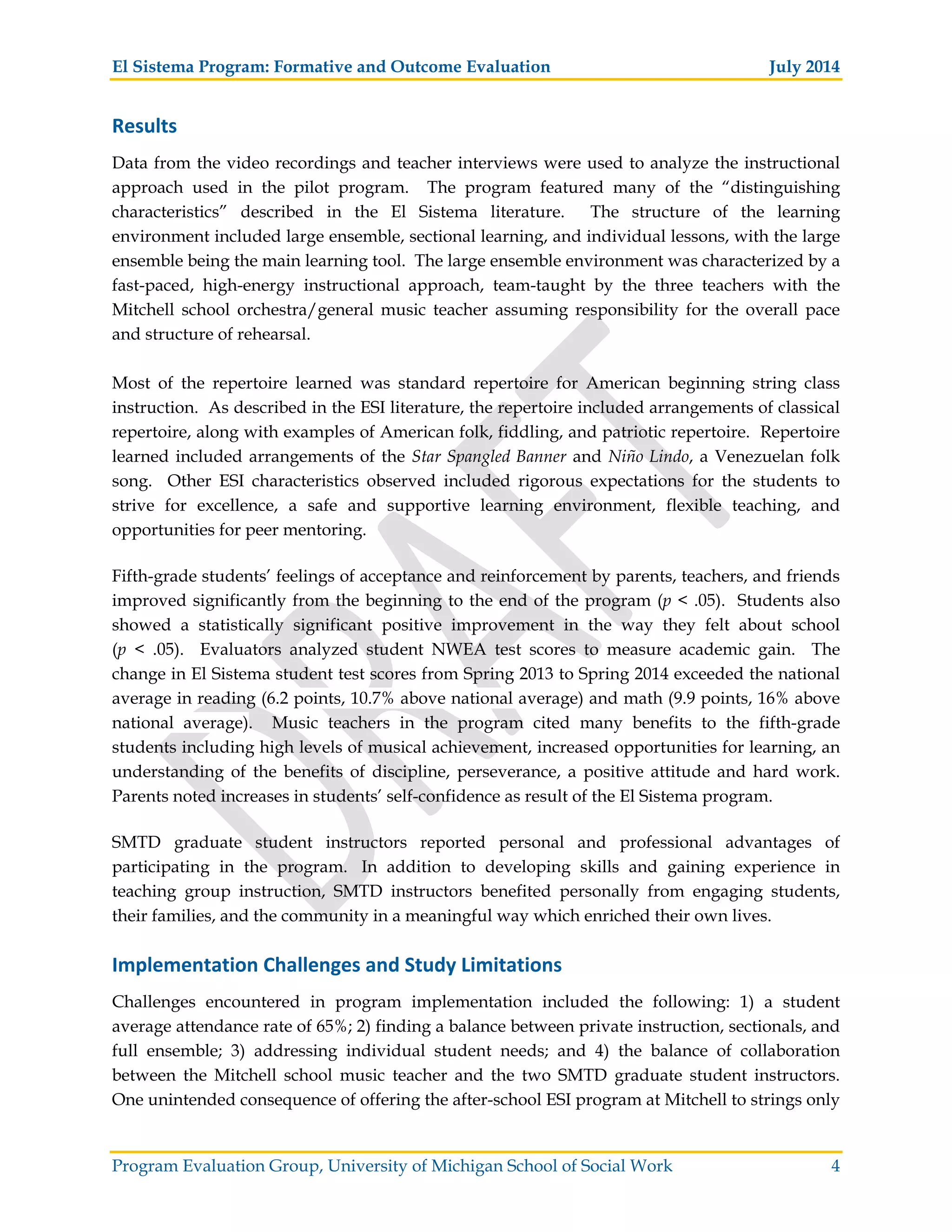

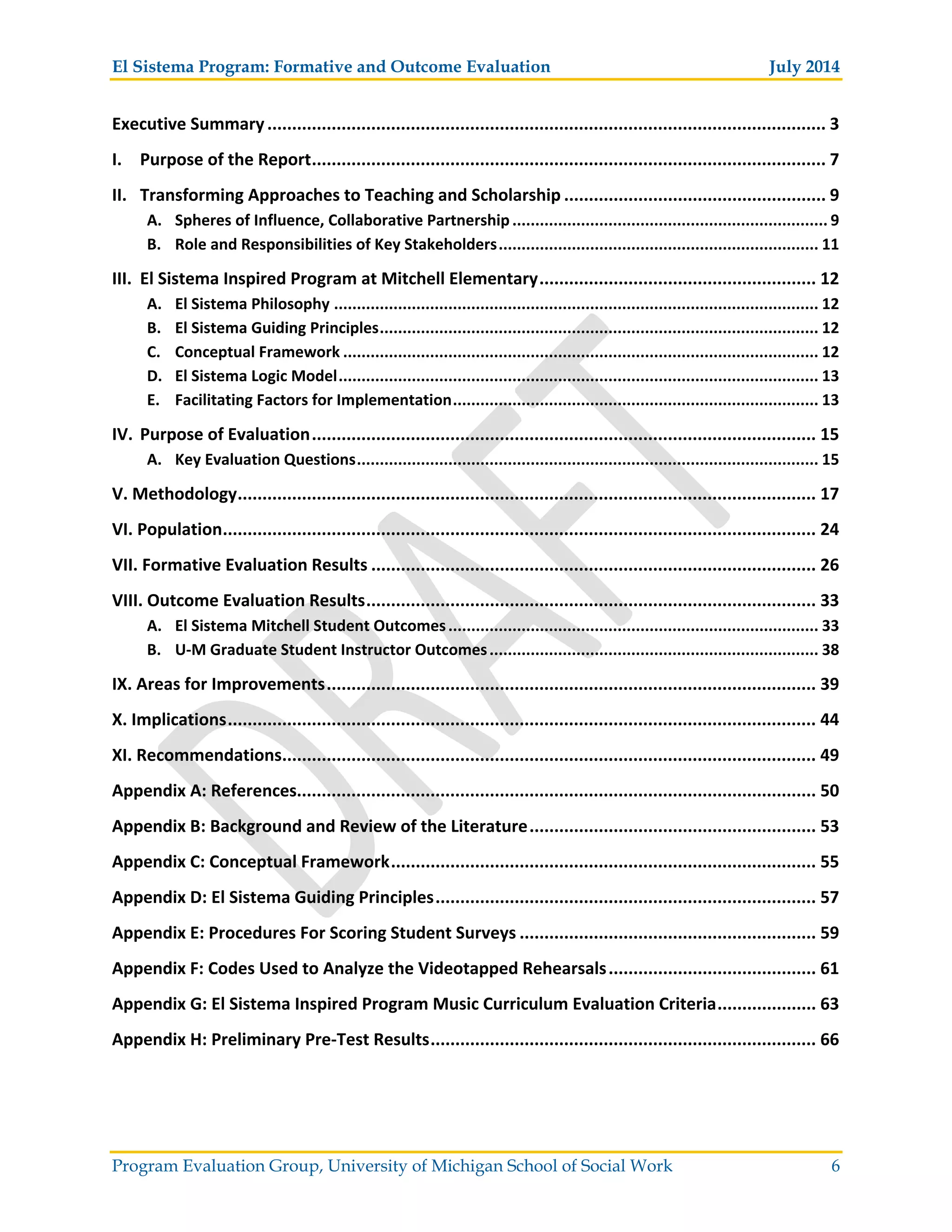
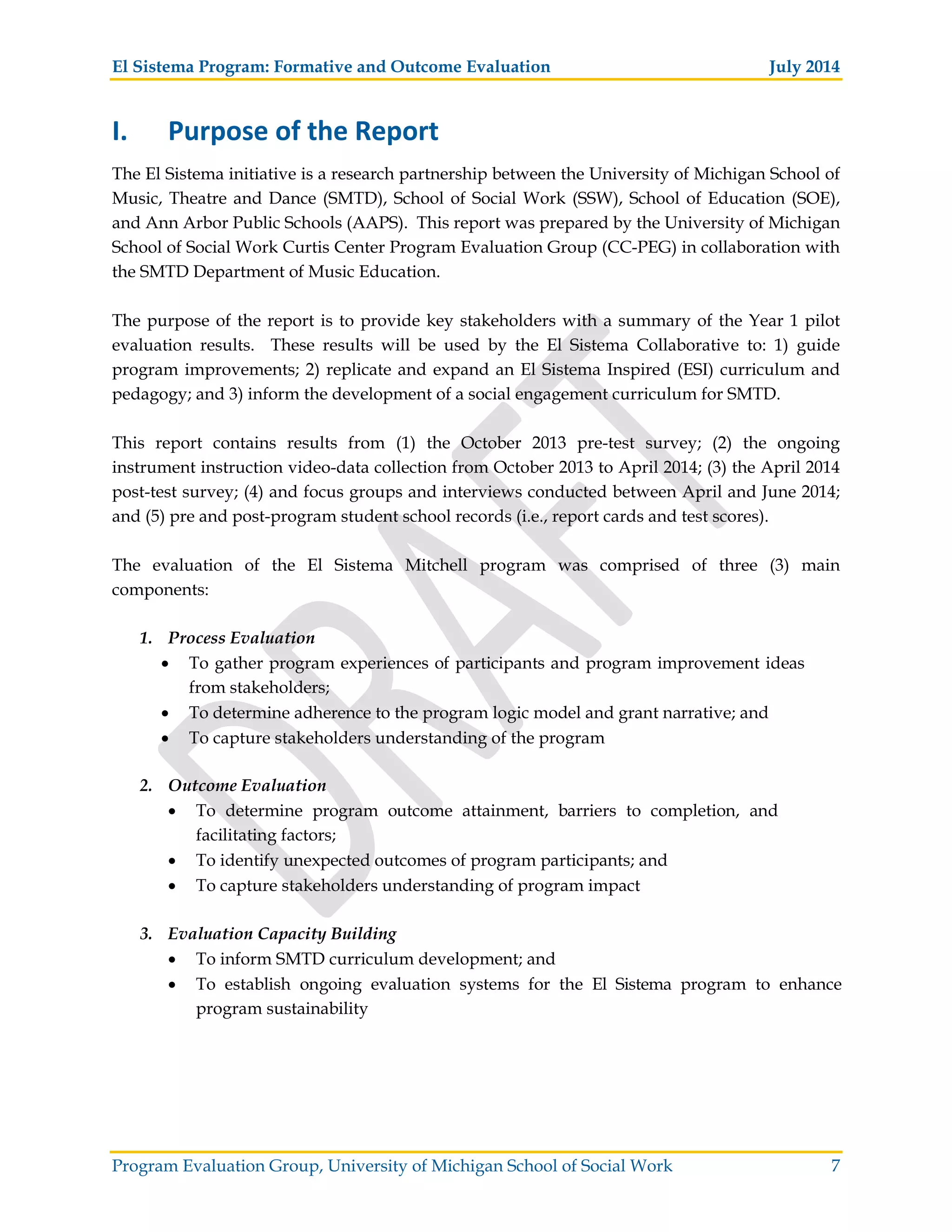


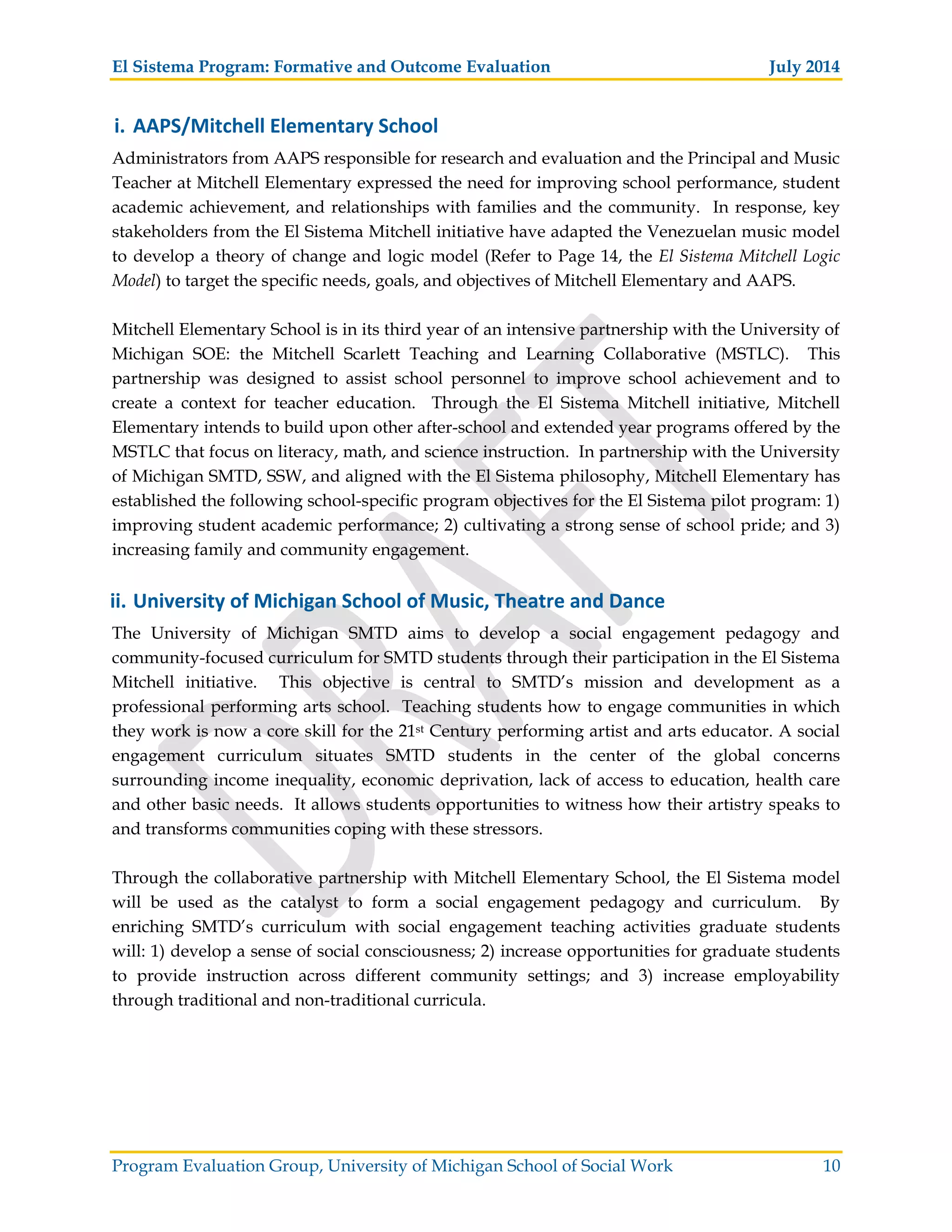
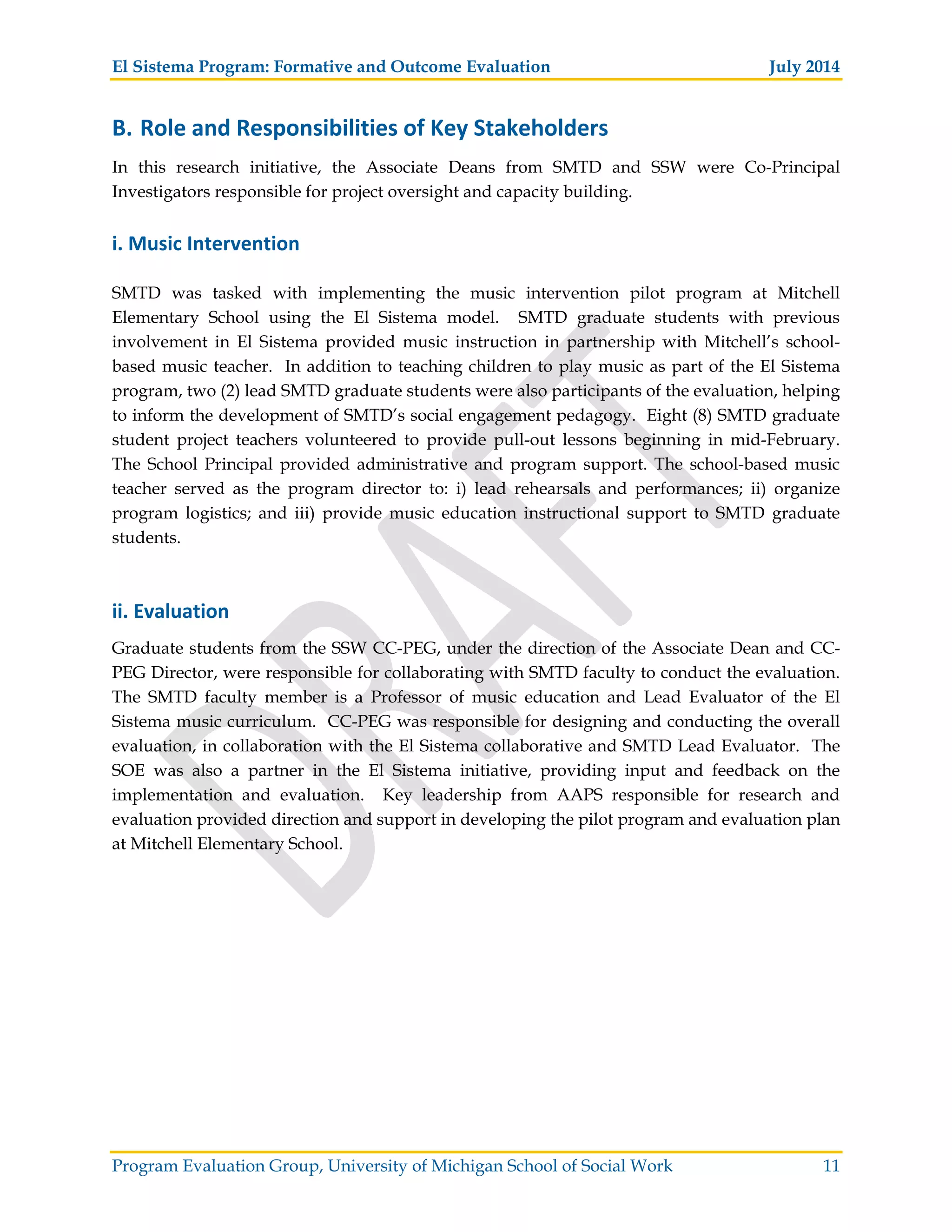
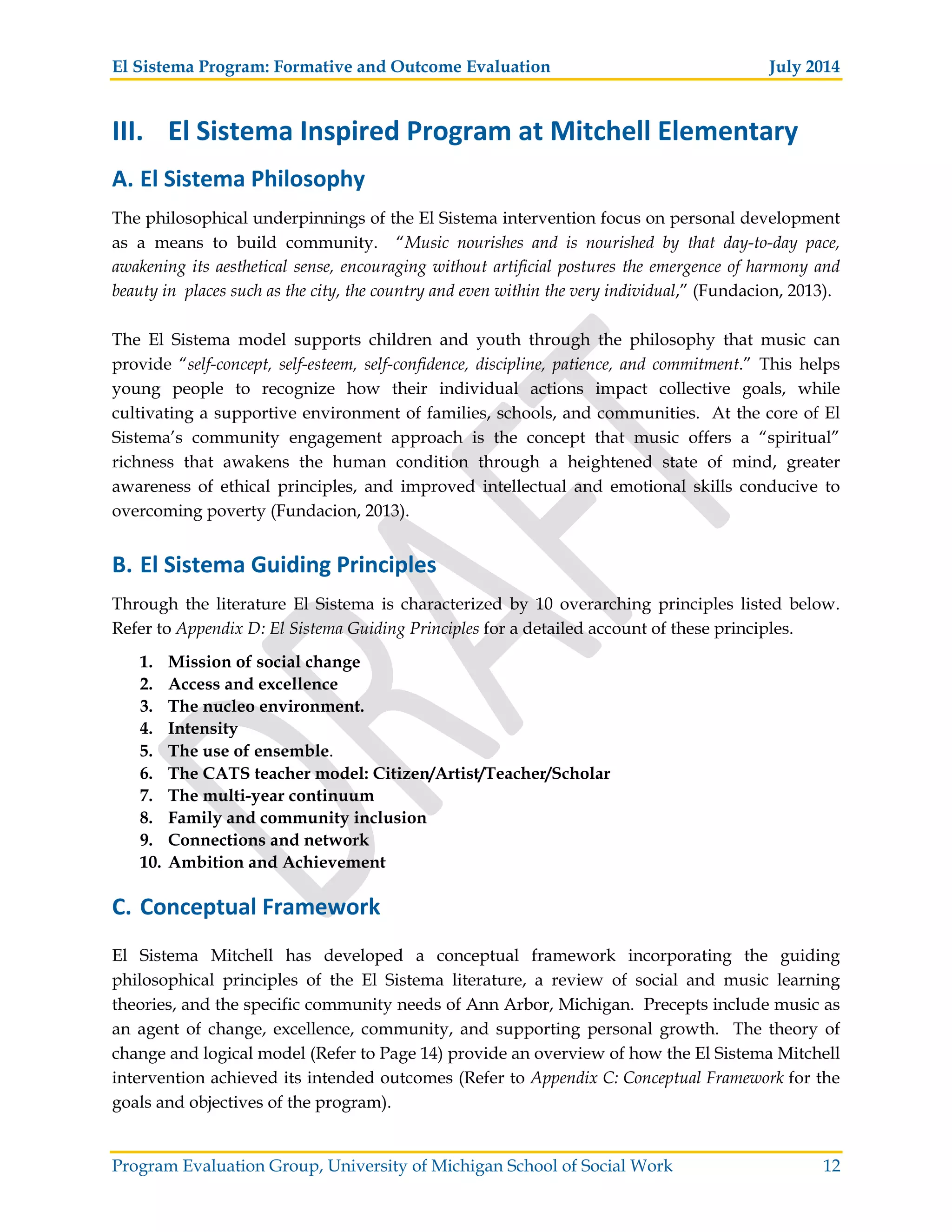
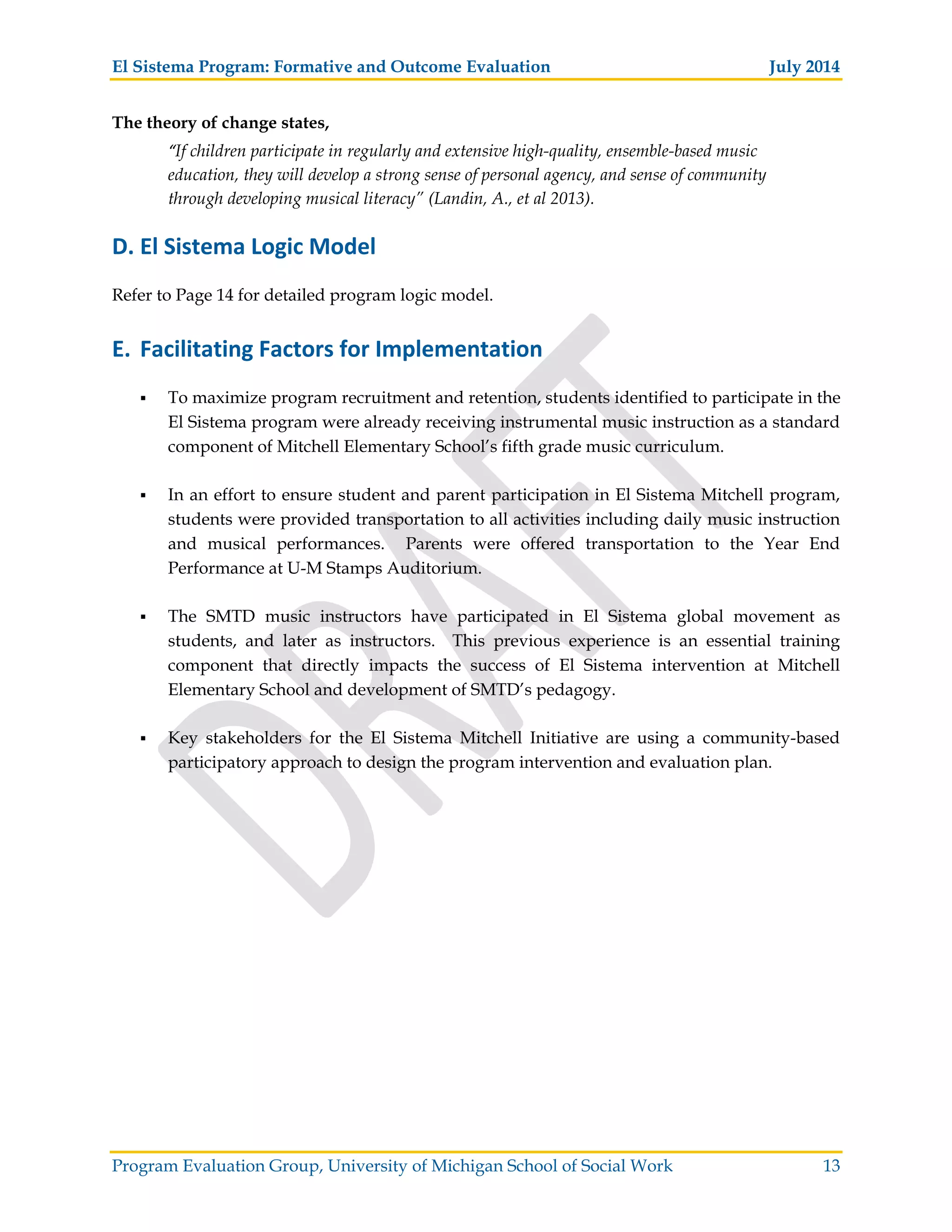

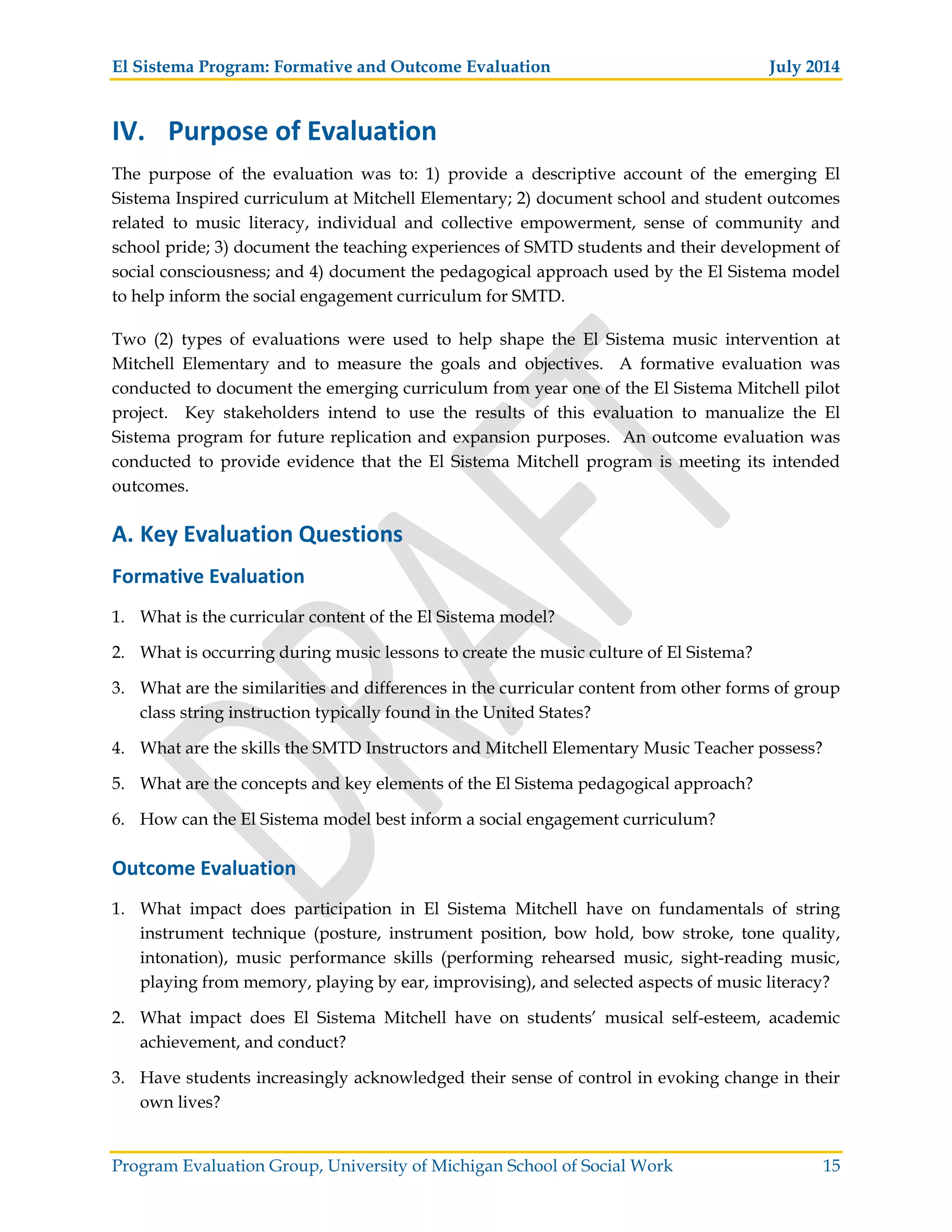
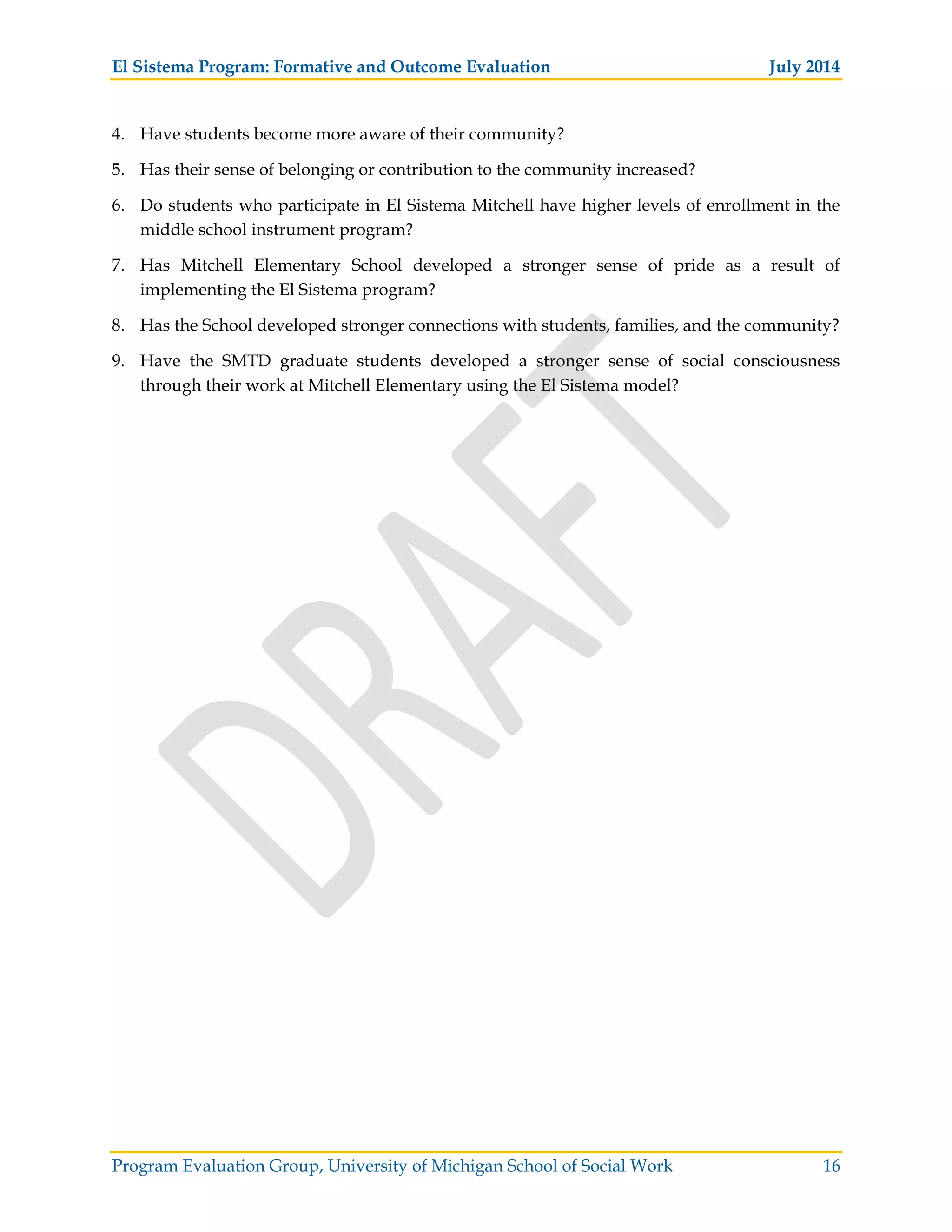
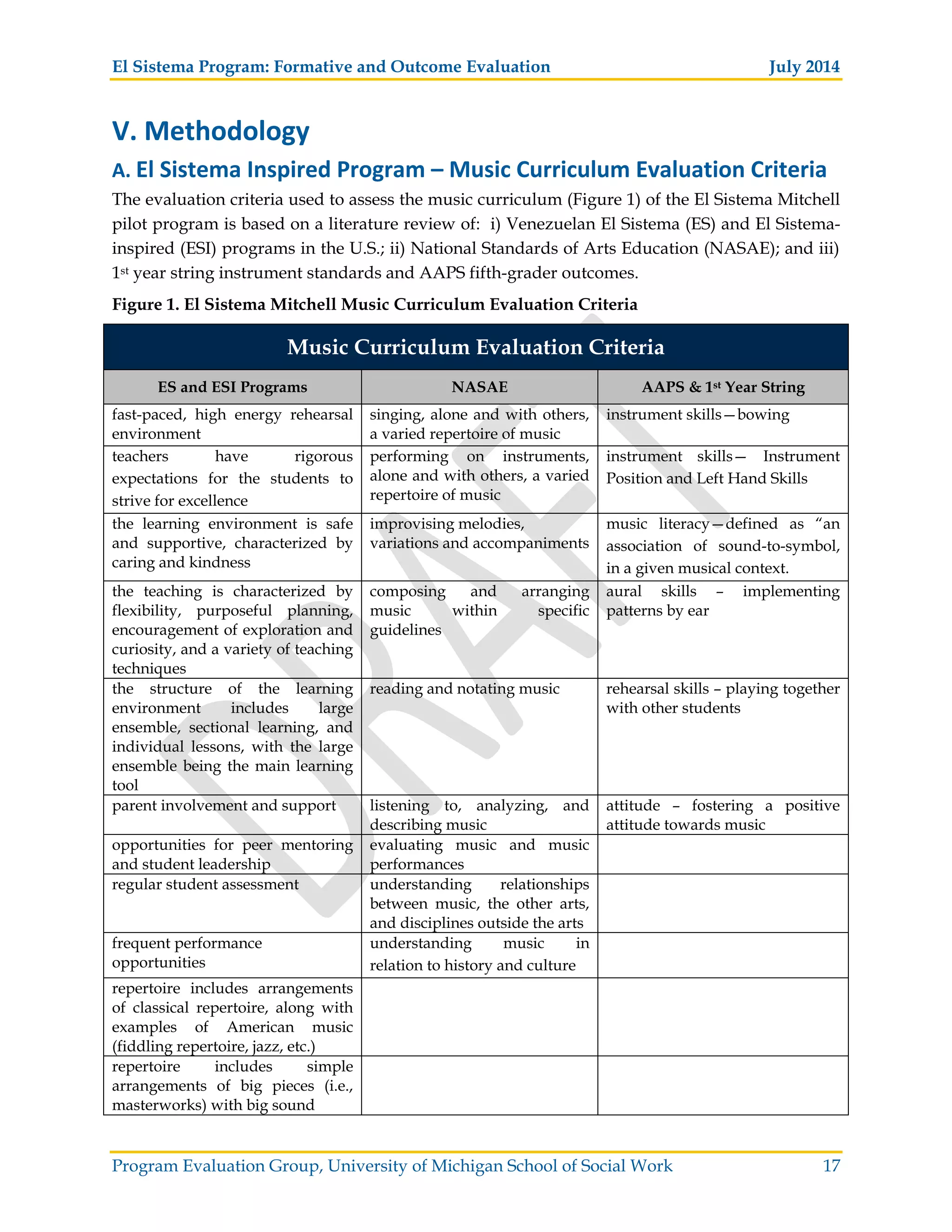
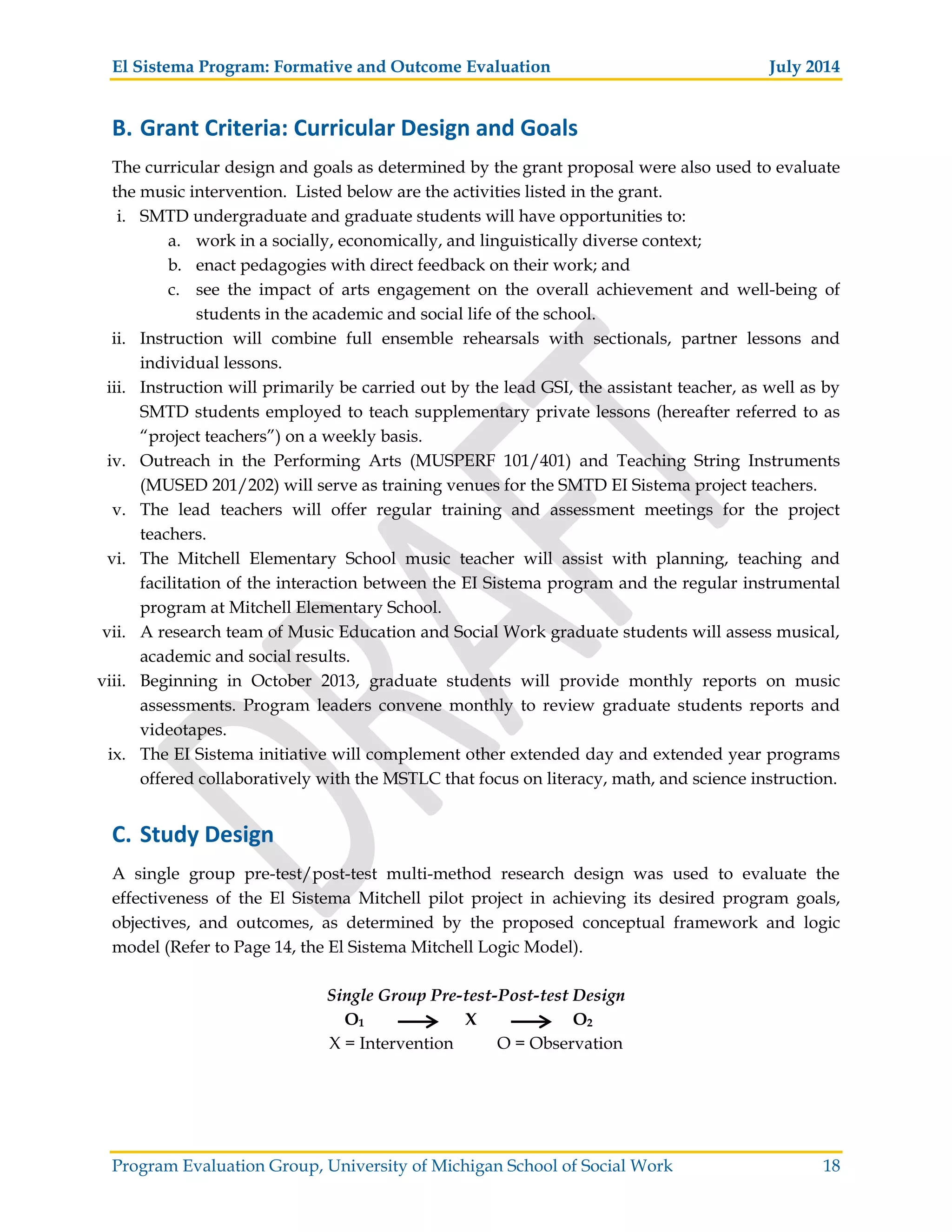
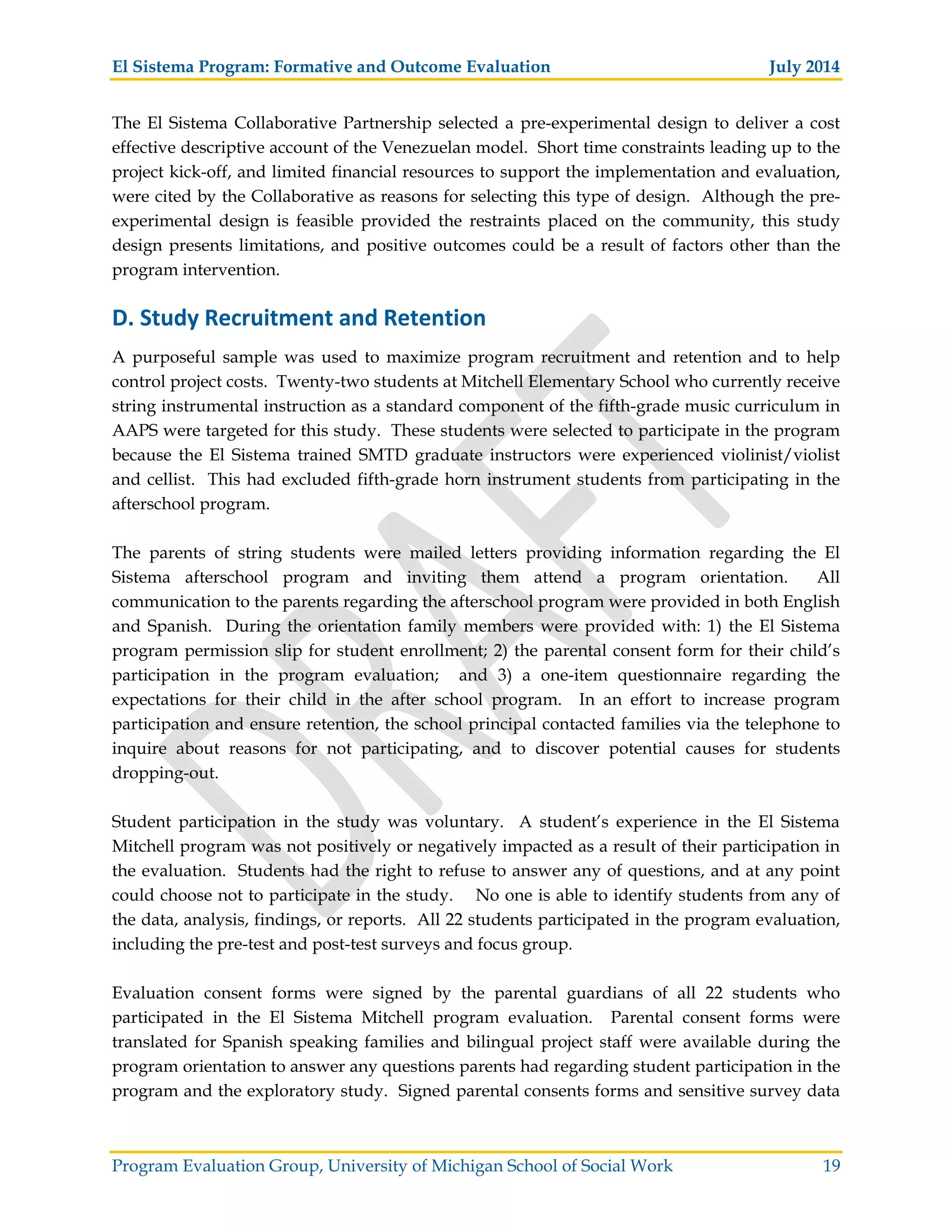
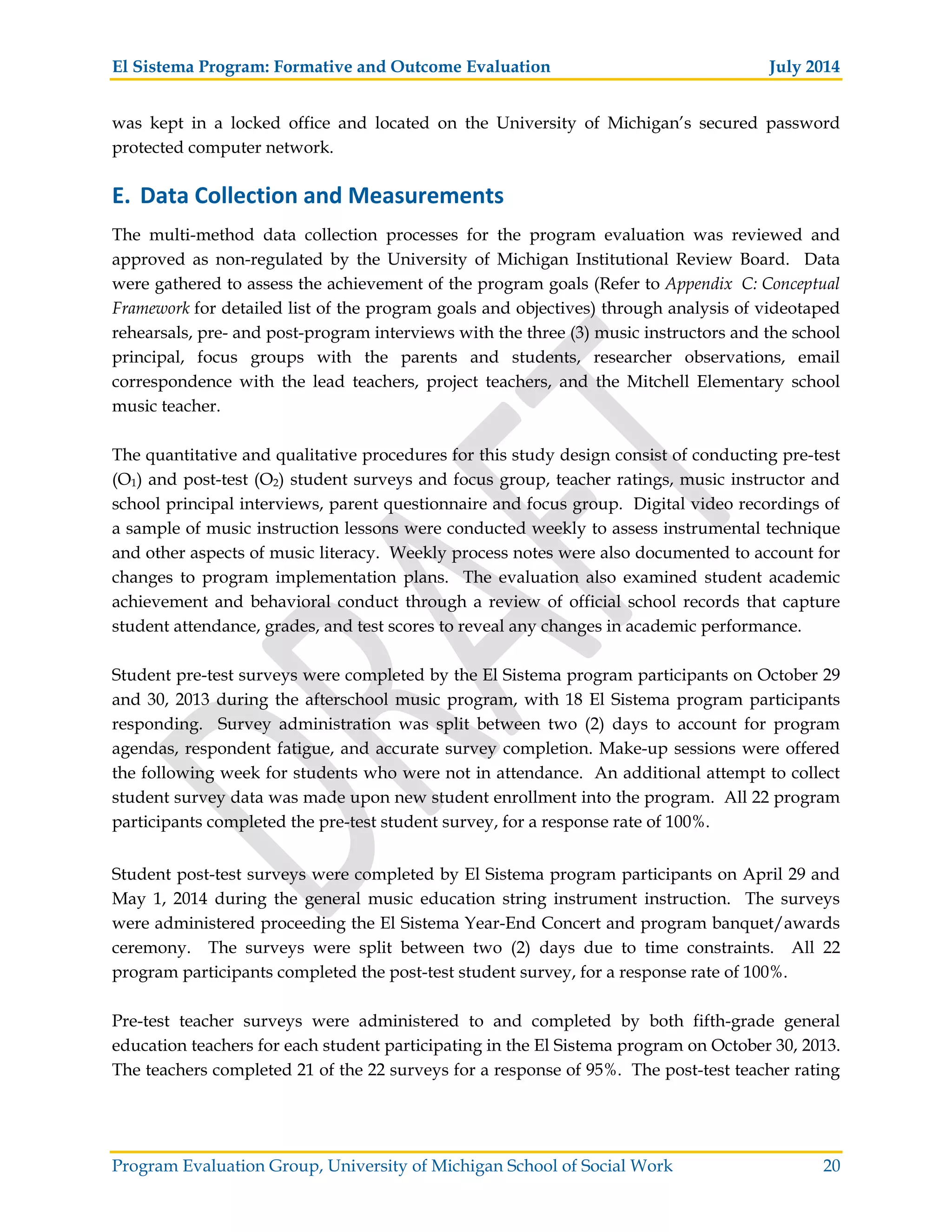
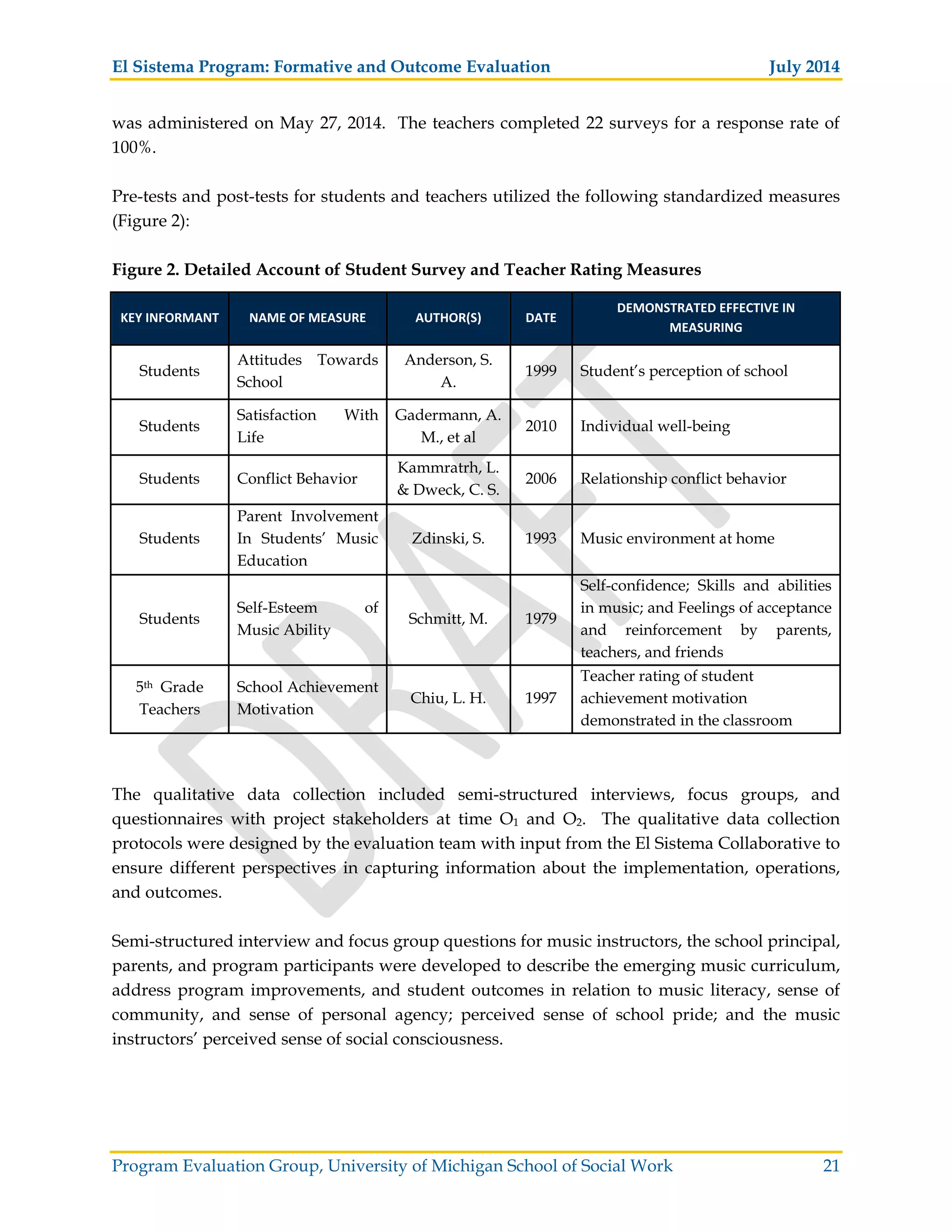
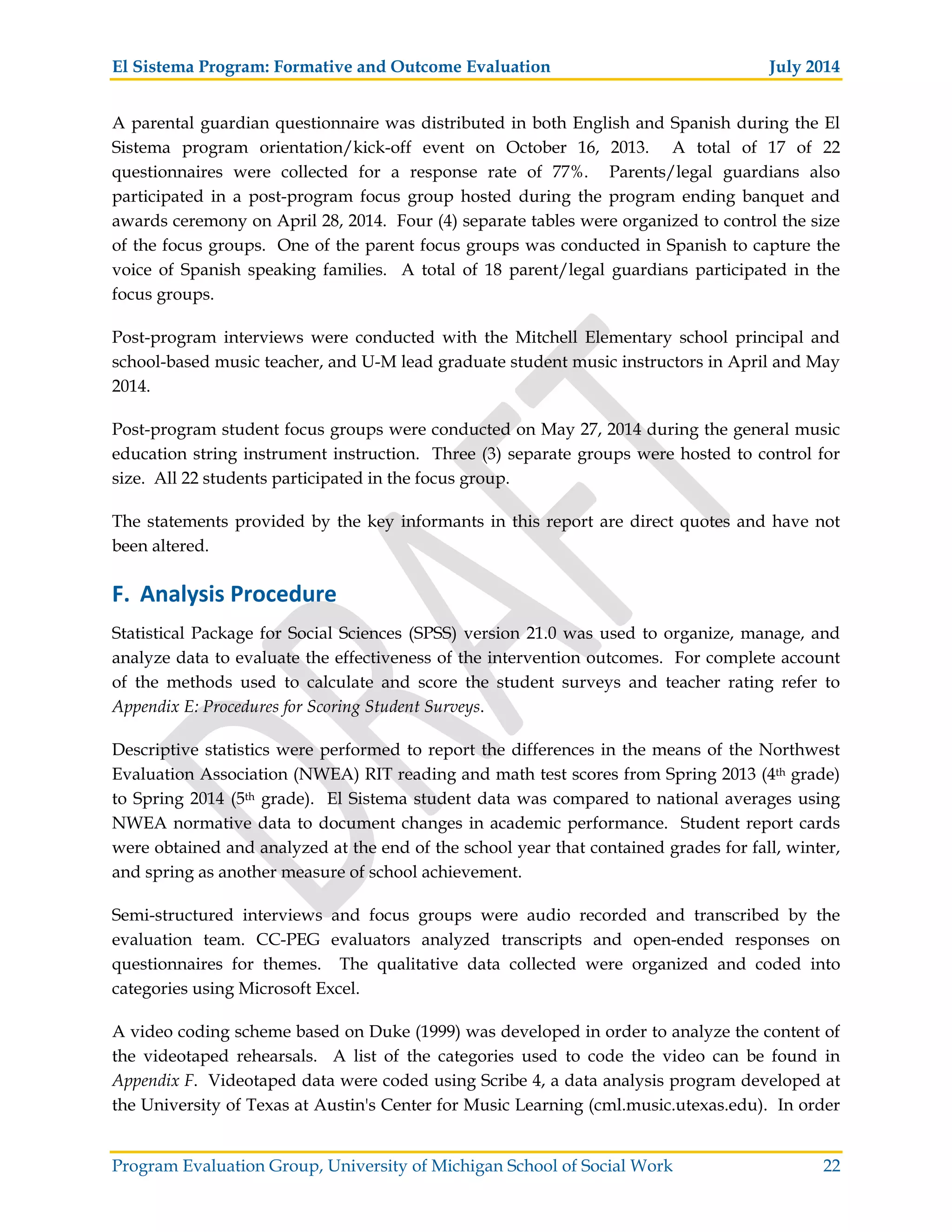
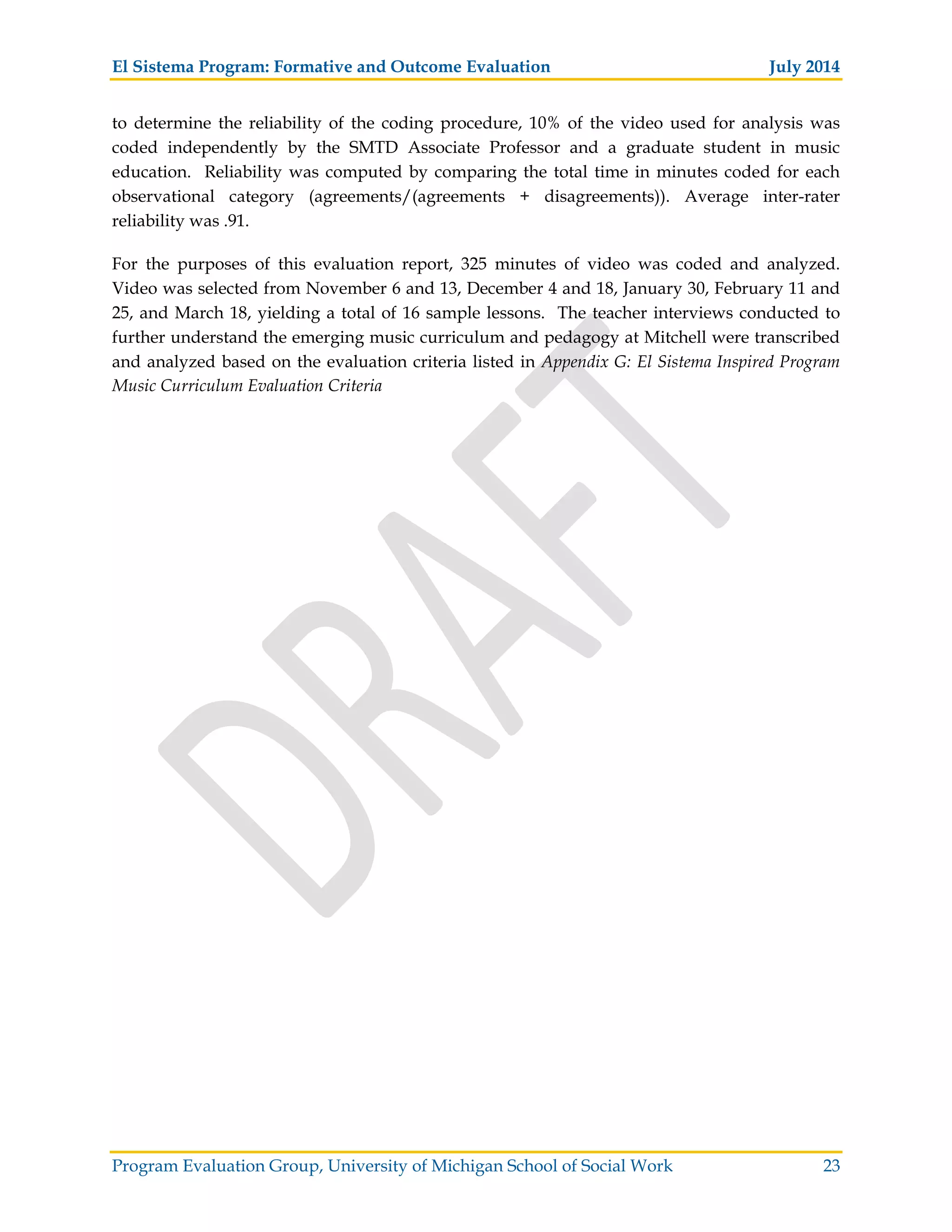
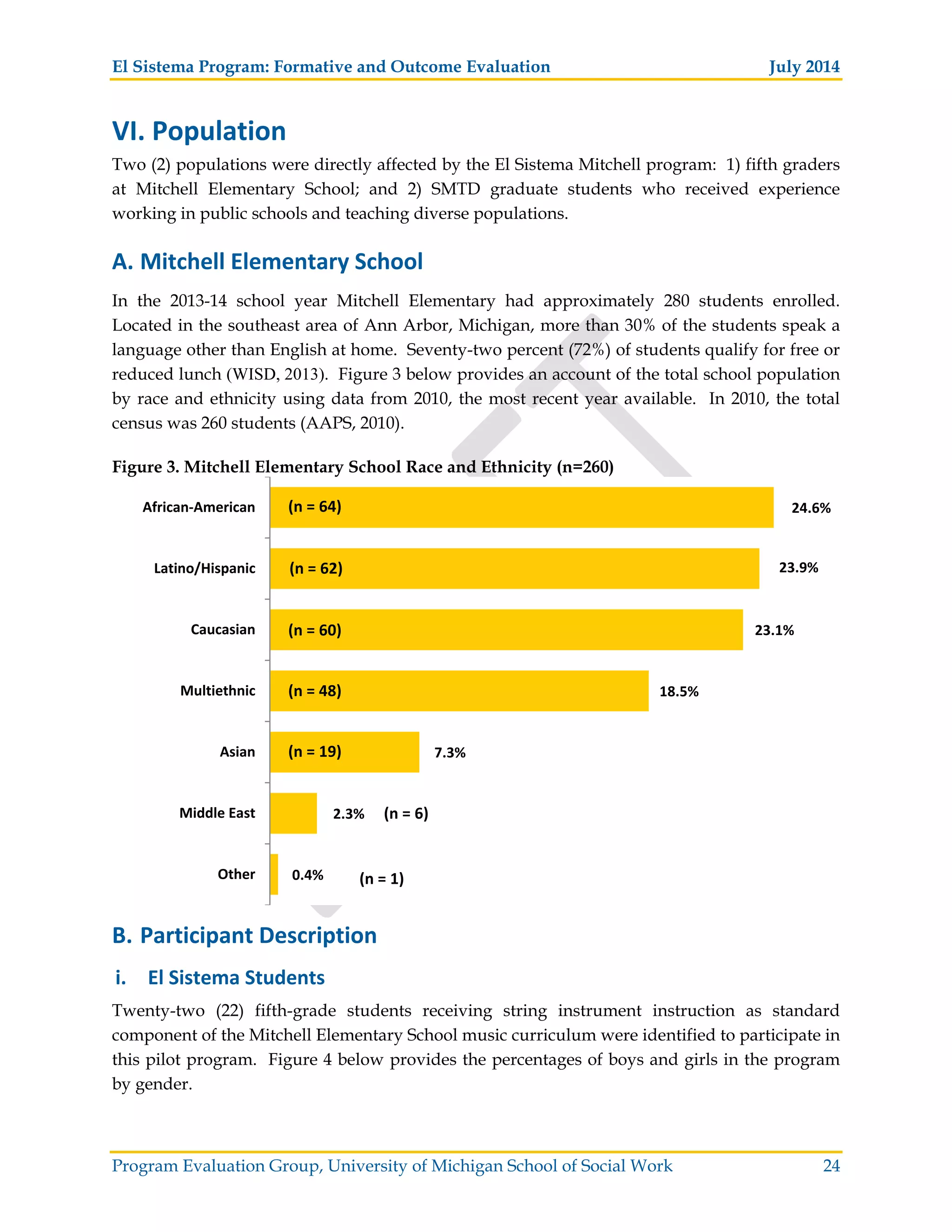
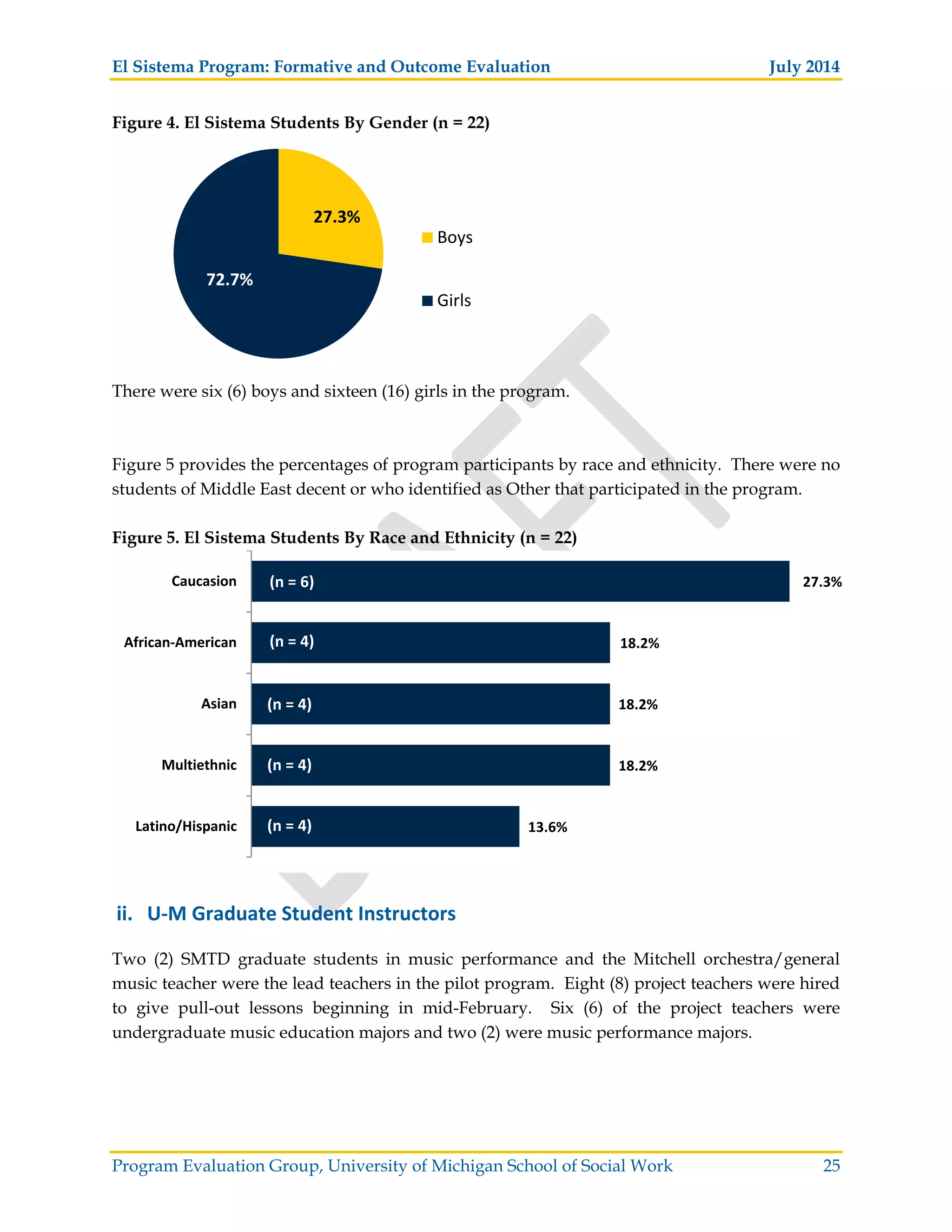

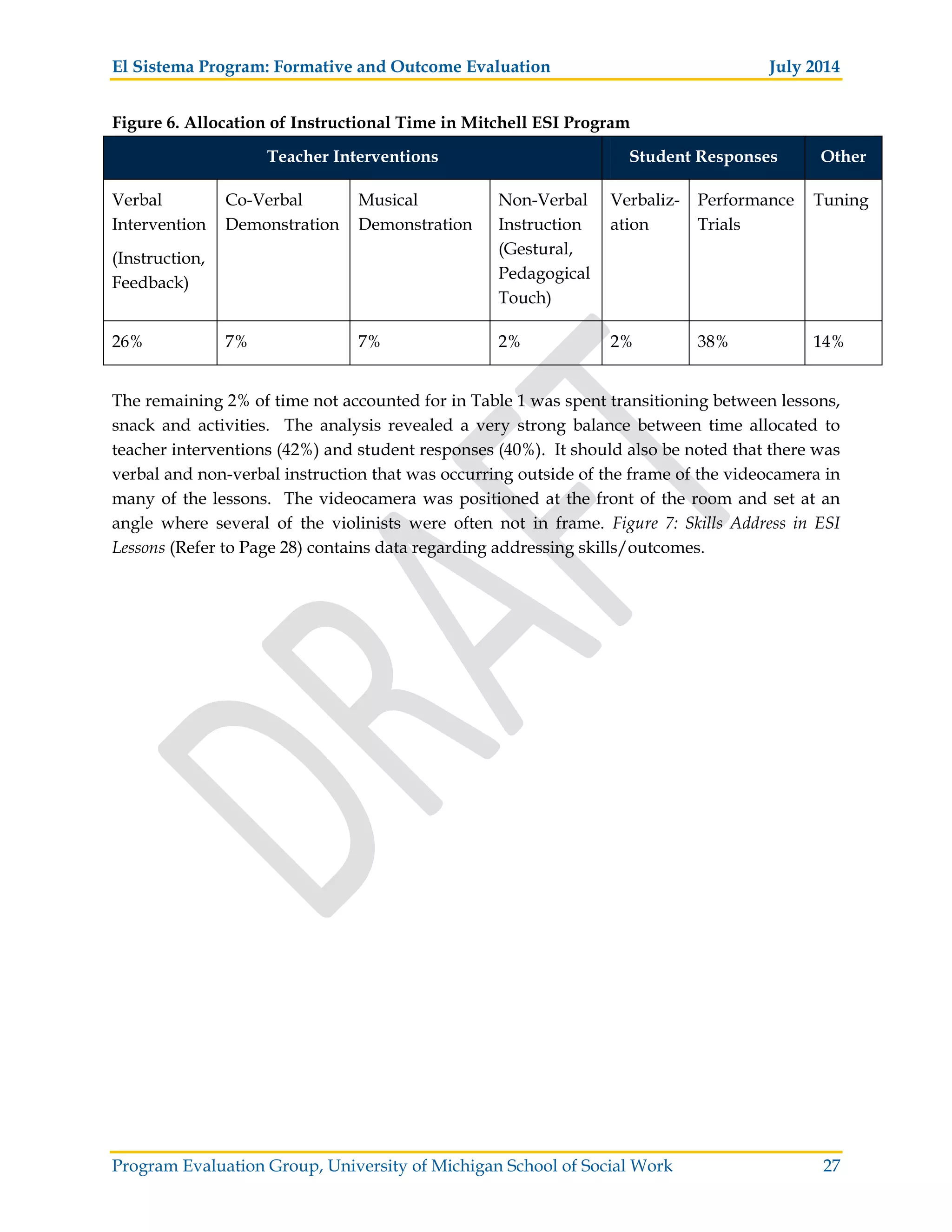
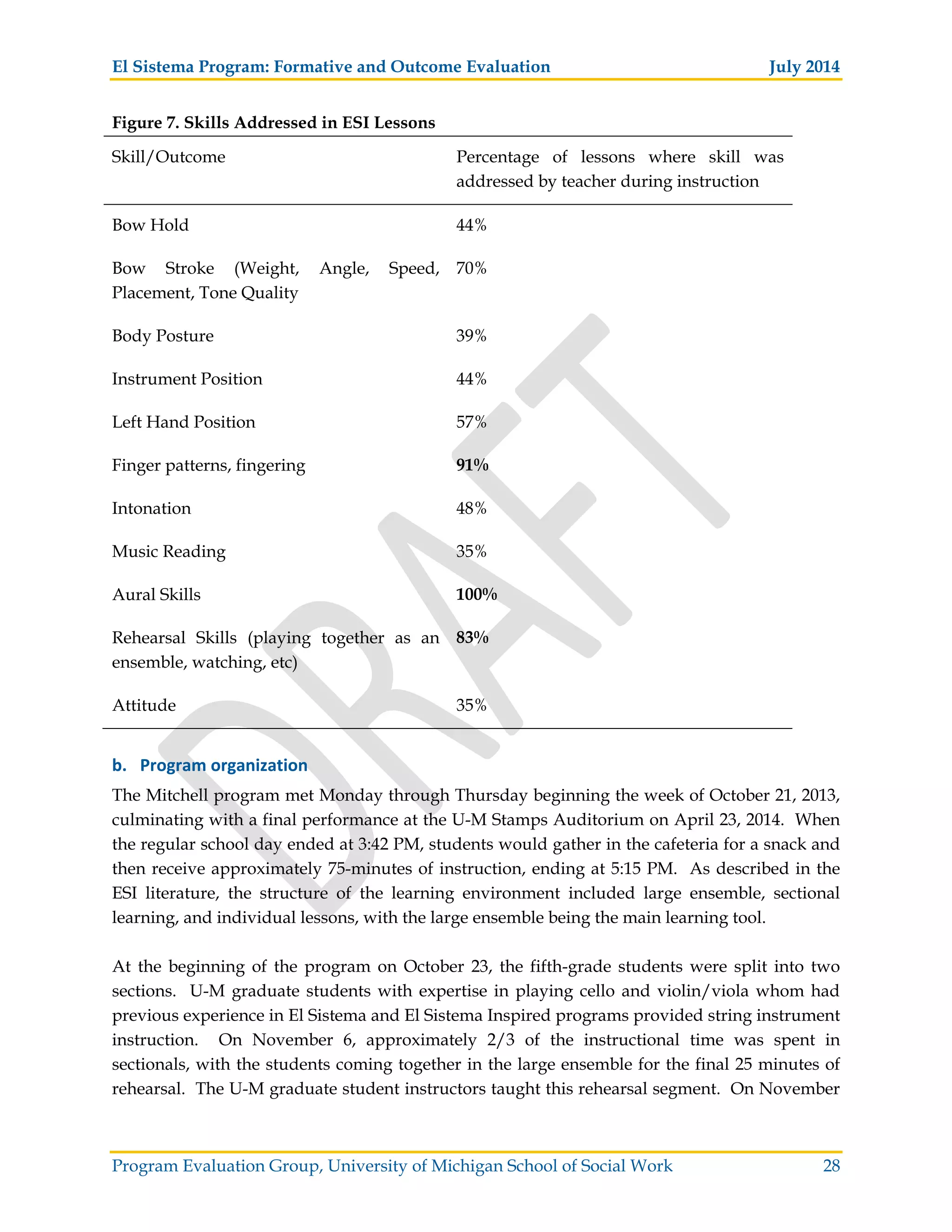
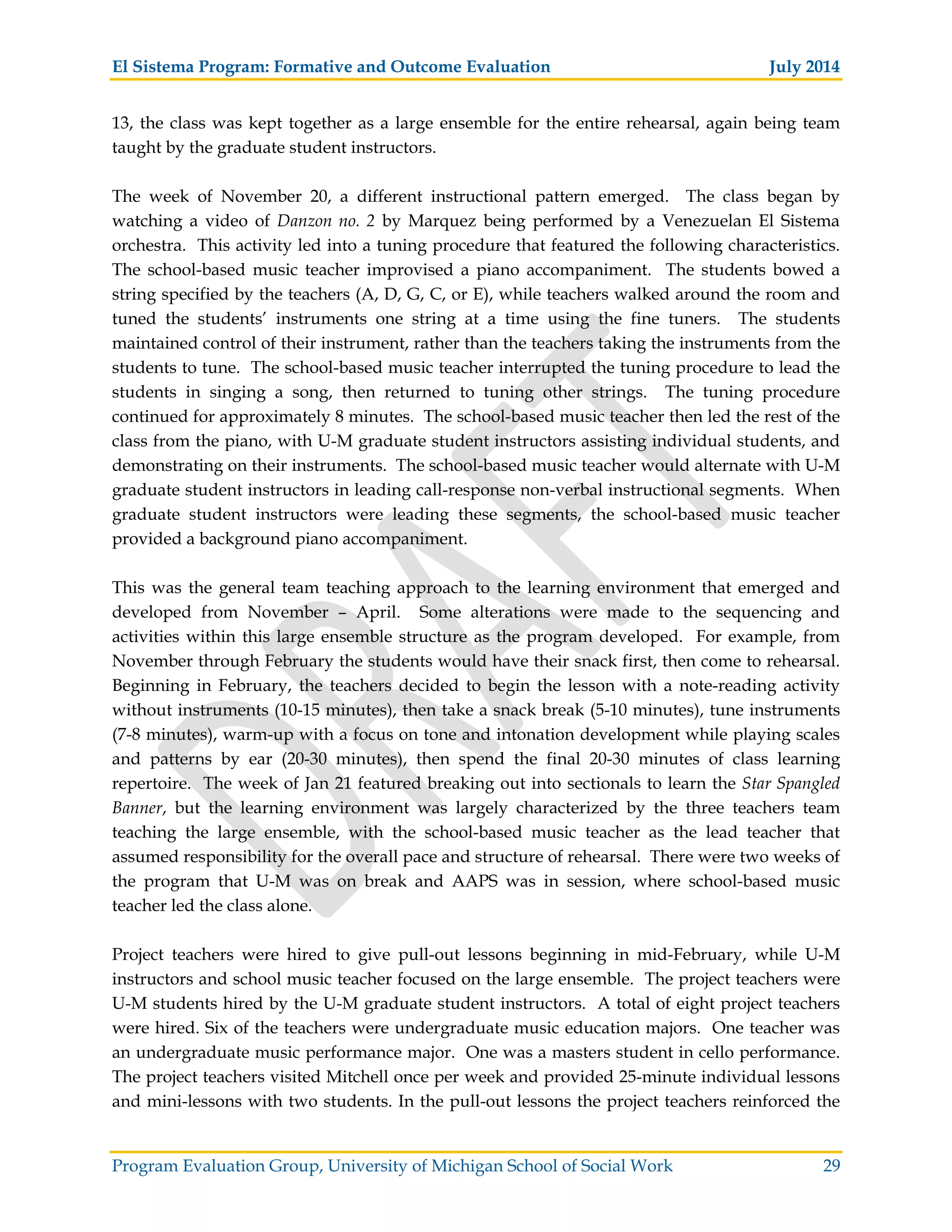
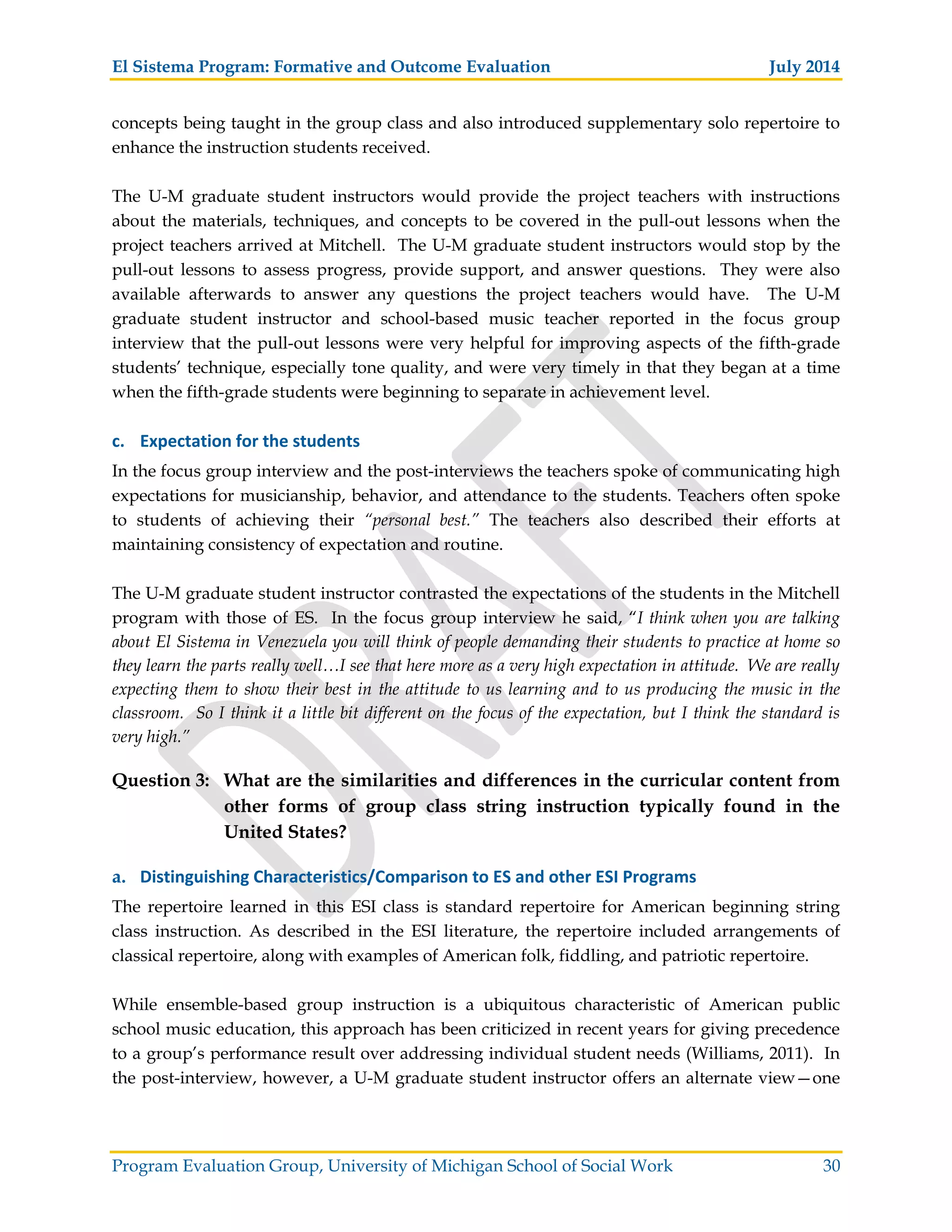
![El Sistema Program: Formative and Outcome Evaluation July 2014
Program Evaluation Group, University of Michigan School of Social Work 31
more in philosophical alignment with Vygotsky’s ideas on the Zone of Proximal Development
(1994),
“take the group and make the group learning and the sound of the group like a
participatory sound, of a participatory nature. The sound of the group will help kids that
don’t have the ability to play the whole piece. For example, to just participate. Be there
and try to play what they can play and then, they take the sound of their group as the
strong thing that keeps them playing and keeps them stimulated while facing individual
challenges.”
By focusing on the collective participatory sound of the large ensemble, the teacher is in fact
addressing the needs of the individual students within the ensemble. Group instruction
provides students with low levels of achievement or self-esteem an opportunity to feel
successful even if they not be able to play the music perfectly.
Question 4: What are the skills the SMTD Instructors and Mitchell Elementary
Music Teacher possess?
a. Development of musicianship
The preparation that the Mitchell students received from the school-based music teacher prior
to the program, and during the school day throughout the program, was a highly influential
factor on this ESI program. In the post-interview, one U-M graduate student instructor
remarked, “I’ve never been with a group that had such strong rhythm and solfege training prior to
picking up their instruments.”
In the focus group interview, the teachers spoke of the benefits they saw from the program. The
school-based music teacher said, “The biggest thing for me is that the kids are set up better than ever.
That is outstanding. In terms of repertoire, we’re not really further along, but the kids have a deeper
understanding of reading that we didn’t have in the past. When they leave us, they’re going to be better
musicians than ever. Their set up is better, they’re listening better, they’re creating better sounds and
they’re understanding deeper.” A U-M graduate student instructor added, “They’re reading really
strong, some of them, some of them are exceptionally strong, and all of them are functional readers at this
point.”
The school-based music teacher expressed a belief that the students’ reading ability will help
keep them interested in continuing to play in middle school and will make them leaders in the
middle school orchestra program. In the post-interview, a U-M graduate student instructor said,
“they really learned a lot of music over the course from October through April, and because of the
fact that there is a combination of the [school-based music teacher and U-M graduate student
instructors], I think they really, for the most part, do have a pretty good technical set-up…and
they have strong reading skills. I’m very happy with the kind of reading processes they’re
developing.”](https://image.slidesharecdn.com/9fe3a314-f4f1-49b9-be48-11714ceb9433-160508203325/75/El-Sistema-Formative-and-Outcome-Evaluation-Final-Report-DRAFT-071514-31-2048.jpg)
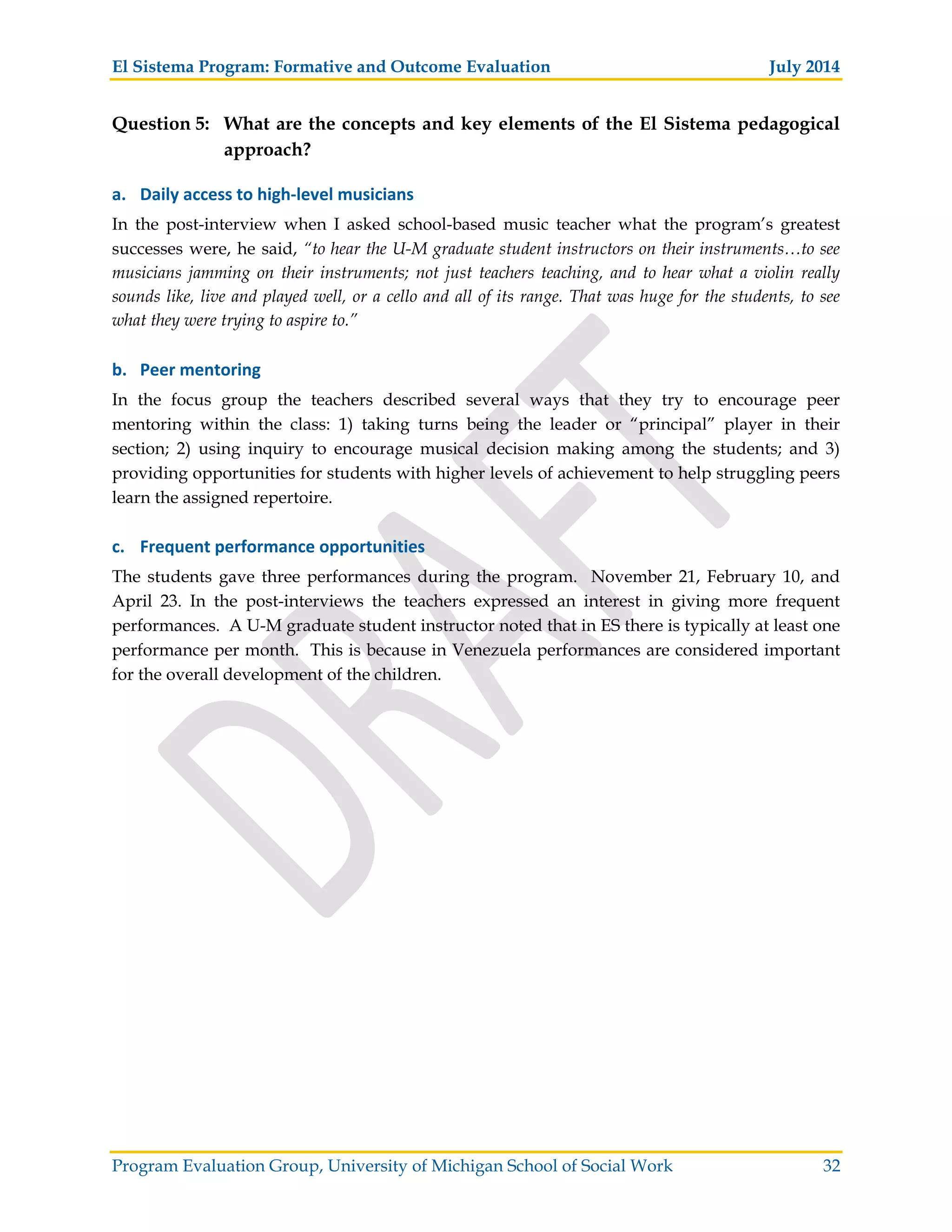
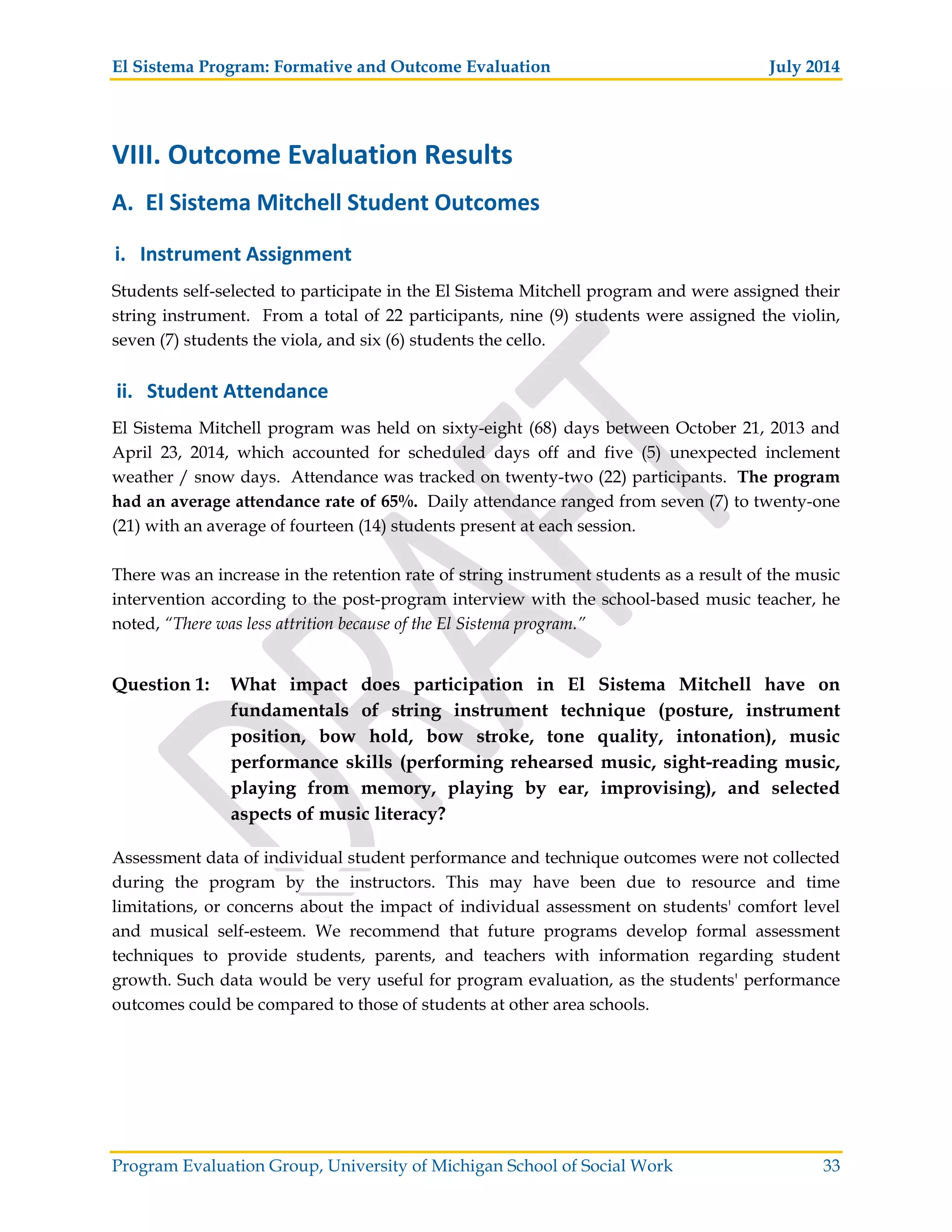
![El Sistema Program: Formative and Outcome Evaluation July 2014
Program Evaluation Group, University of Michigan School of Social Work 34
Question 2: What impact does El Sistema have on students’ musical self-esteem,
academic achievement, and conduct?
a. Musical self esteem
Results from a paired sample t-test (p<.05) of pre-test (mean = 55.68) and post-test (mean =
59.41) scores from Subscale 1: Support and Recognition from Others of the Self-Esteem of
Musical Ability (SEMA) Scale (Schmitt, 1979) indicated that students showed a statistically
significant improvement in their feelings of acceptance and reinforcement by parents,
teachers, and friends. The Self-Perception of Music Ability subscale changed in a positive
direction, but was not statistically significant. The Personal Interest and Desire sub-scale
decreased from pre to post-test, however was not significant.
Furthermore, in the post-program interviews with the music instructors, one teacher stated that,
“the program helped the fifth-grade students learn the benefits of discipline, perseverance, a positive
attitude and hard work.” Another instructor said, “Some students were more shy in the beginning, less
inclined to express their feelings or personality, but by the end of program they were more at ease.”
Another instructor stated, “Some students displayed more confidence in their music playing.”
Parents reported in the post-program focus group that students seemed to have improved their
confidence. “I feel like [El Sistema] was a great confidence builder.” Another parent stated, “She saw
she was successful for herself.” A father noted, “[He has] more self-esteem.”
b. Academic achievement
Results of the differences in the means of the Northwest Evaluation Association (NWEA)
reading and math test scores from Spring 2013 to Spring 2014 revealed El Sistema students
exceeded the national average. NWEA normative data shows the national average growth in
RIT test scores from end of 4th grade to end of 5th grade as 5.6 points in reading and 8.5 points
in math. The growth from Spring 2013 (end of 4th grade) to Spring 2014 (end of 5th grade) for
program participants was higher than the national average in reading (6.2 points, 10.7% above
national average) and in math (9.9 points, 16% above national average). However, it was
difficult to determine if the El Sistema music intervention had a direct impact on academic
achievement due to the limitations of the outcome design.
Parents shared their reservations about the effects of the program on academic achievement
during the focus group, “[My child’s] reading went up two levels, not sure if it was the [El Sistema]
program.”
c. Behavioral conduct
Results from a paired sample t-test (p<.05) of pre-test (mean = 68.32) and post-test (mean =
70.95) scores from the Student Attitudes Towards School Scale (Anderson, 1999) indicated that
students showed a statistically significant positive improvement in the way they felt about
school.](https://image.slidesharecdn.com/9fe3a314-f4f1-49b9-be48-11714ceb9433-160508203325/75/El-Sistema-Formative-and-Outcome-Evaluation-Final-Report-DRAFT-071514-34-2048.jpg)
![El Sistema Program: Formative and Outcome Evaluation July 2014
Program Evaluation Group, University of Michigan School of Social Work 35
In a post-program interview, the school principal noted El Sistema students’ behavior had
appeared to improve, “I do believe the kids are more engaged in positive behaviors.” The principal
also indicted that, “There were no school suspensions [of those students who participated in El
Sistema].” Parents noted changes in their students’ behavior, during the focus group one parent
said, “He takes things more seriously. He’s more responsible.”
Question 3: Have students increasingly acknowledged their sense of control in
evoking change in their own lives?
It was challenging to identify if the students increased their sense of control in evoking change
in their own lives due to the limitations of the measurement tools used and outcome design.
Results from the paired sample t-test of pre-test and post-test scores from the Self-Perception of
Music Ability (SEMA) Scale (Schmitt, 1979) revealed no significant change in students’
perception of their interest and desire in playing music. However, the results from the SEMA
Personal Interest and Desire sub-scale were positive, indicating that students: i) enjoyed
practicing music; ii) expected a lot of themselves; and iii) had a strong desire to play music in
the future. Although limitations created barriers for answering this evaluation question, the
students’ realization of their role in determining their level of interest in continuing playing was
used as a proxy to determine the students’ realization of their sense of control in evoking
change in their own lives.
In parent focus groups, families underscored their students’ renewed sense of control in
evoking change in their own lives. Parents noted their student’s ability to adhere to prior
commitments, act responsible, and make decisions about their future, “She would work to finish
her homework, she was more organized.” Another parent shared, “I liked the way she followed through
[with El Sistema]. It is important to me for her to take on something challenging… Taking on the
responsibility shows maturity.” ”Playing the cello has made him take it a step further. He wants to play
a stand-up bass,” was noted by one student’s father.
Question 4: Have students become more aware of their community?
In the post-program interviews, the music teachers all spoke of the benefit they saw from the
year end performance at U-M Stamps Auditorium. The school-based music instructor stated
that the experience of playing in Stamps Auditorium was highly empowering for the students
and helped them to envision themselves as part of a larger community.
“The greatest success was getting the kids to the Michigan campus, getting them to North
Campus, getting them to see that, getting them to see the auditorium… the cello players were
already down on the stage getting ready with [one instructor], and [the other two instructors]
brought the violins and violas and we came in from the top, and when they looked down they
were just…they were really taken back. They could not believe they were playing there.”](https://image.slidesharecdn.com/9fe3a314-f4f1-49b9-be48-11714ceb9433-160508203325/75/El-Sistema-Formative-and-Outcome-Evaluation-Final-Report-DRAFT-071514-35-2048.jpg)
![El Sistema Program: Formative and Outcome Evaluation July 2014
Program Evaluation Group, University of Michigan School of Social Work 36
The students echoed the similar sense of community they felt as being part of the final
performance at Stamps Auditorium. During the post-program focus group, one student stated
that, “It was nice to see my teacher and student teacher come to one of my performances. It was also nice
to hear my teachers talk about my performance at school.”
Question 5: Has their sense of belonging or contribution to the community
increased?
In a focus group with student’s families, one parent stated, “the impact [El Sistema] had on her
made her feel like she belonged. This was the first year she felt like she belonged to the group. She had fun
with it and enjoyed it. It made her a lot better.”
In the post-program interview, a U-M graduate student instructor attributed the performance of
El Sistema as vehicle to keep students connected said, “there are some students that kind of drifted
away from the program and came back…I was very happy that they came back. That they were in their
final performance and I know their families were some of the ones that were most happy in the wake of the
performance.”
Question 6: Do students who participate in El Sistema Mitchell have higher levels
of enrollment in the middle school instrument program?
The evaluation of the El Sistema pilot program measured program outcomes at the end of fifth-
grade (June 2014). The El Sistema student level of enrollment at the middle school should be
conducted in a subsequent evaluation after the program participants have entered 6th grade.
For example, the Mitchell School music teacher tracks the elementary students into the
instrument and orchestra program at Scarlett Middle. The instrument instruction retention rate
at the elementary level is a proxy to determine attrition rates at the middle school level
currently used by Mitchell Elementary School.
Question 7: Has Mitchell Elementary School developed a stronger sense of pride as
a result of implementing the El Sistema program?
During a post-program interview, the school principal was asked about the ways El Sistema has
contributed to the sense of school community and positive reputation in the larger Ann Arbor
community. He noted the following:
“We have become a music school in a sense where kids are interested in playing and developing
their music ability. It is really an important part of the changes that have happened here.”
“Having kids engaged at the performances and attend the initial meeting created a sense of
community.”
“For the Mitchell Community the performance at the end added to the sense of community at
Mitchell.”](https://image.slidesharecdn.com/9fe3a314-f4f1-49b9-be48-11714ceb9433-160508203325/75/El-Sistema-Formative-and-Outcome-Evaluation-Final-Report-DRAFT-071514-36-2048.jpg)
![El Sistema Program: Formative and Outcome Evaluation July 2014
Program Evaluation Group, University of Michigan School of Social Work 37
“Historically, people in the larger community do not speak highly of Mitchell Elementary.
However, because of El Sistema there was a certain buzz in Ann Arbor about what is going on
here. The program is something special. This program is a positive thing for Mitchell, bringing
positive press.”
In post-program interviews, the U-M graduate student instructors and school-based music
teacher conveyed a similar sense of community within the school and across Ann Arbor. “The
media buzz was pretty cool, on NPR and two articles in the newspaper.”
The school principal and music teacher had to monitor the publicity and address issues of
equity among the school community. In a post-program interview, the school based music
teacher stated, “If we made too big a deal of El Sistema we could offend some people.” He went on to
say, “We had to harness the publicity at the end of the program to protect against the divide between the
two groups [strings and band students.]”
One unintended consequence of offering the after-school ESI program at Mitchell to strings only
was that it introduced an inequality of educational opportunity for the fifth grade students. The
fifth-grade band director and strings teacher reported that the band students expressed feelings
of envy toward the ESI program. Eventually, the Mitchell band director began inviting her
fifth-grade band students to walk to Scarlett Middle School two days a week to participate in an
afterschool practice club, in an attempt to ameliorate the disparity of instructional time between
the fifth-grade orchestra and band students.
Question 8: Has the School developed stronger connections with students, families,
and the community?
A sense of support and community developed around the program. An older brother of one of
the fifth-grade students in the program began attending and assisting the teachers with snack
and tuning instruments. The teachers also stated this helped the fifth-grade student to have her
brother attend because of some family issues. The presence of eight (8) U-M graduate students
at Mitchell to provide lessons each week also provided a sense of support to the students. The
school-based music teacher was pleased with the project lesson teachers. In the focus group, he
reported that the attendance of the U-M students had been very consistent.
During a post-program interview, the school principal stated that, “The [El Sistema program] has
helped me get to know parents in a more meaningful way.” He went on to say, “Every parent I see of
an El Sistema student will say that they love it and they will tell me.”](https://image.slidesharecdn.com/9fe3a314-f4f1-49b9-be48-11714ceb9433-160508203325/75/El-Sistema-Formative-and-Outcome-Evaluation-Final-Report-DRAFT-071514-37-2048.jpg)
![El Sistema Program: Formative and Outcome Evaluation July 2014
Program Evaluation Group, University of Michigan School of Social Work 38
B. U M Graduate Student Instructor Outcomes
The two (2) U-M lead graduate student instructors participated in a post-program interview to
offer their perspective of program’s effectiveness in achieving a stronger sense of social
consciousness through their provision of music instruction in the community.
Question 9: Have the SMTD graduate students developed a stronger sense of social
consciousness through their work at Mitchell Elementary using the El
Sistema model?
The instructors discussed the opportunity for U-M students to teach in communities as
advantage and strength of program. One of the graduate students decided to attend U-M
because of the El Sistema initiative: “One of the reasons I chose U-M was because of the opportunity
to participate in the El Sistema program.” Throughout the interview, the graduate students
expressed an appreciation for the opportunity to work in a public school to develop their
expertise in teaching group instruction. “It was great for me to develop these skills and gain more
experience teaching group instruction.”
When the U-M graduate student instructors were asked about their initial expectations for the
program during the post-program interview, it was evident they both expected to connect with
the students through their music instruction. One instructor stated, “I hoped to work closely with
the kids not just learning to play music, but how to play an instrument well and for them to gain
confidence on their instruments.” The other instructor added to this notion by stating that,
“[Initially,] I was anxious to meet kids from a different culture. I wanted to be able to handle situations
with the children.”
Upon further reflection of their initial expectations and what the graduate student instructors
gained from the program, engaging students, their families, and the community in a
meaningful way while contemporaneously improving their teaching acumen emerged as the
recurring themes:
“The teacher-student relationship is a special thing in of itself, music teaching is a unique subset
of that. Ideally, helping kids to gain fluency in a new language, in a new manner of expression,
and connect with a new corpus of art in the world – is exciting in of itself. It is great when you
get to know these children and their families, it enriches your life too.”](https://image.slidesharecdn.com/9fe3a314-f4f1-49b9-be48-11714ceb9433-160508203325/75/El-Sistema-Formative-and-Outcome-Evaluation-Final-Report-DRAFT-071514-38-2048.jpg)
![El Sistema Program: Formative and Outcome Evaluation July 2014
Program Evaluation Group, University of Michigan School of Social Work 39
IX. Areas for Improvements
A. Attendance
The El Sistema Mitchell program had an average attendance rate of 65%. At the beginning of
the program, there was a strict policy regarding attendance. A number of problems began to
emerge with the strict policy, and it needed to be dropped. The school-based music teacher
explained in the post-program interview, “We knew that if we were strict about the policy about
attendance, we’d lose everybody. In fact, when I look back, I think we were maybe going to end up with 2
or 3 students if we enforced the policy about attendance that we started off with. There were only 2 or 3
kids that gave us almost full attendance.” The school-based music teacher expressed considerable
frustration in the focus group with how schedule interruptions were impacting the program,
“They added programs throughout the year. Math was one that got added. It was only
supposed to be first semester for 8 weeks. They found extra money from the governor,
and all of a sudden they had another one, and the day that the kids met changed on us.
Tuesdays and Thursdays were always our big days, and it worked out well because I
would see the kids during the day for string class, with a gentle reminder, ‘you’re coming
tonight, yes? Yes. We’ll see you tonight. Good.’ Second semester that switched so our
big days ended up being Monday and Wednesday, now I don’t have the reminder, the
schedule changed, attendance was affected…All of a sudden, it was hard to define what
school activities were a must that you could miss versus an activity that you wanted to
join. They also added Science Olympiad. There was another Science Makers that was
not in place at the beginning of the year that started; so a lot of activities.”
He also noted the many disruptions in January and February,
“there were so many snow days…and then Martin Luther King Day, and then,
President’s Day…we just had so many interruptions. They went to camp. The kids said,
“I can’t be here today, I have to get ready for camp.” And then when they came back,
they said “I can’t be here because I’m really tired from camp”….so there are a lot of
dynamics that hit me probably more than them [U-M graduate student instructors], with
the teachers here in the building…. I am thinking this could have been planned
differently, we could have better communication, who’s in charge? That was making it
tough. And then Michigan’s off for a week. I was frustrated because I felt like we were
losing momentum, but it’s not because we’re not doing a good job. We have a lot of
things fighting against us.”
Regular student attendance was the most significant challenge perceived by the other
instructors. In the post-program interview, a U-M graduate student instructor said, “one of the
stresses for us was regular attendance especially as certain other programs targeting the fifth-grade
population were being added. It’s great for the school that the kids have all these opportunities, but in](https://image.slidesharecdn.com/9fe3a314-f4f1-49b9-be48-11714ceb9433-160508203325/75/El-Sistema-Formative-and-Outcome-Evaluation-Final-Report-DRAFT-071514-39-2048.jpg)

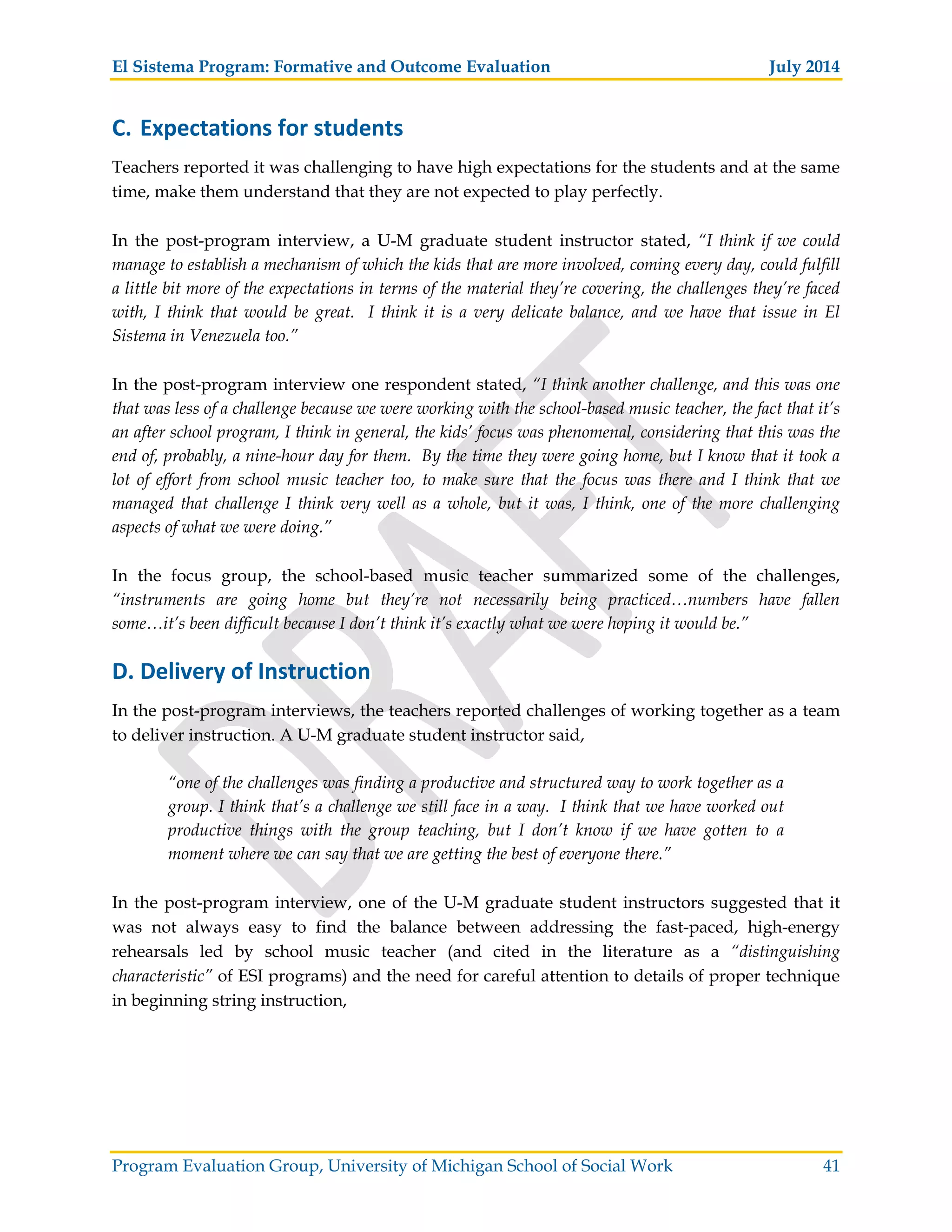
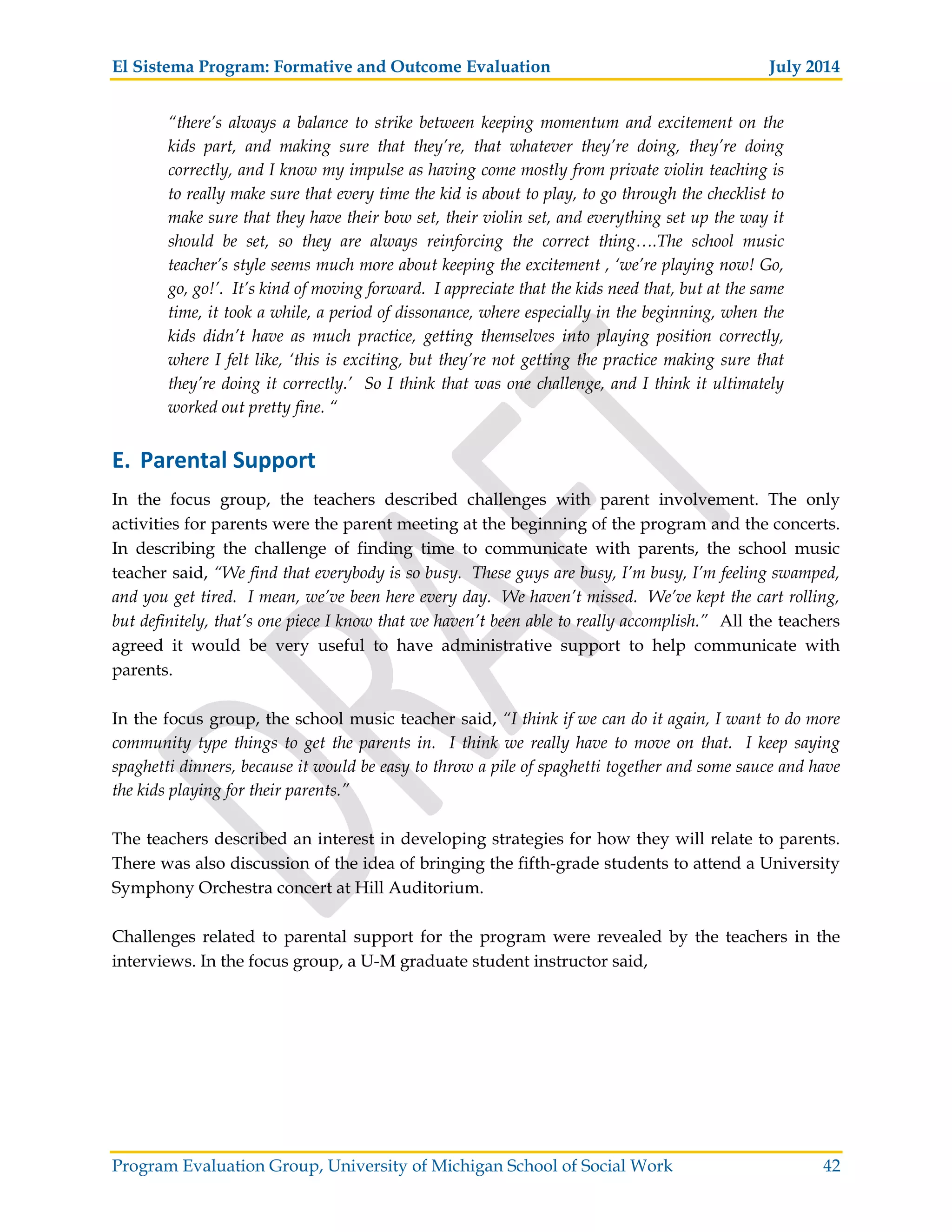
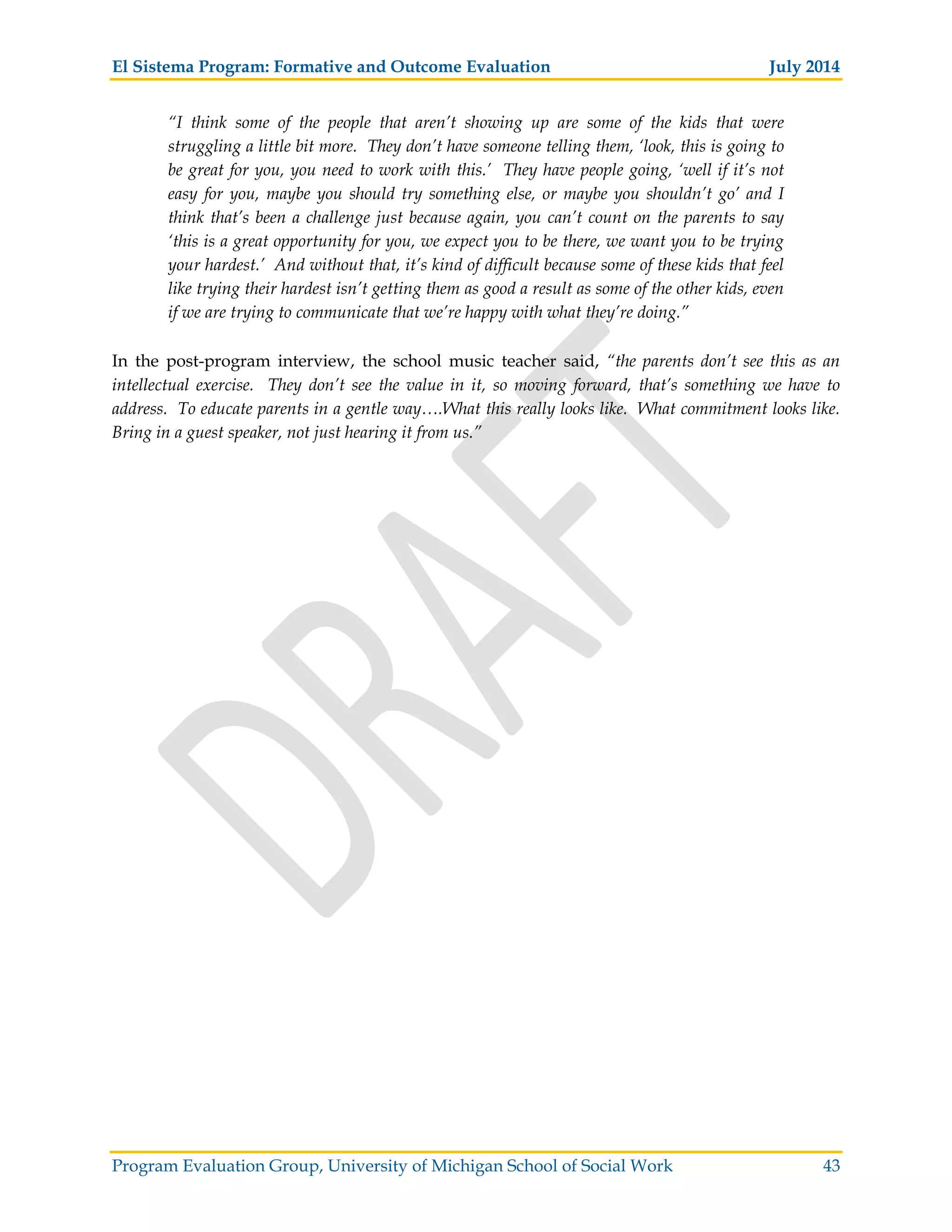
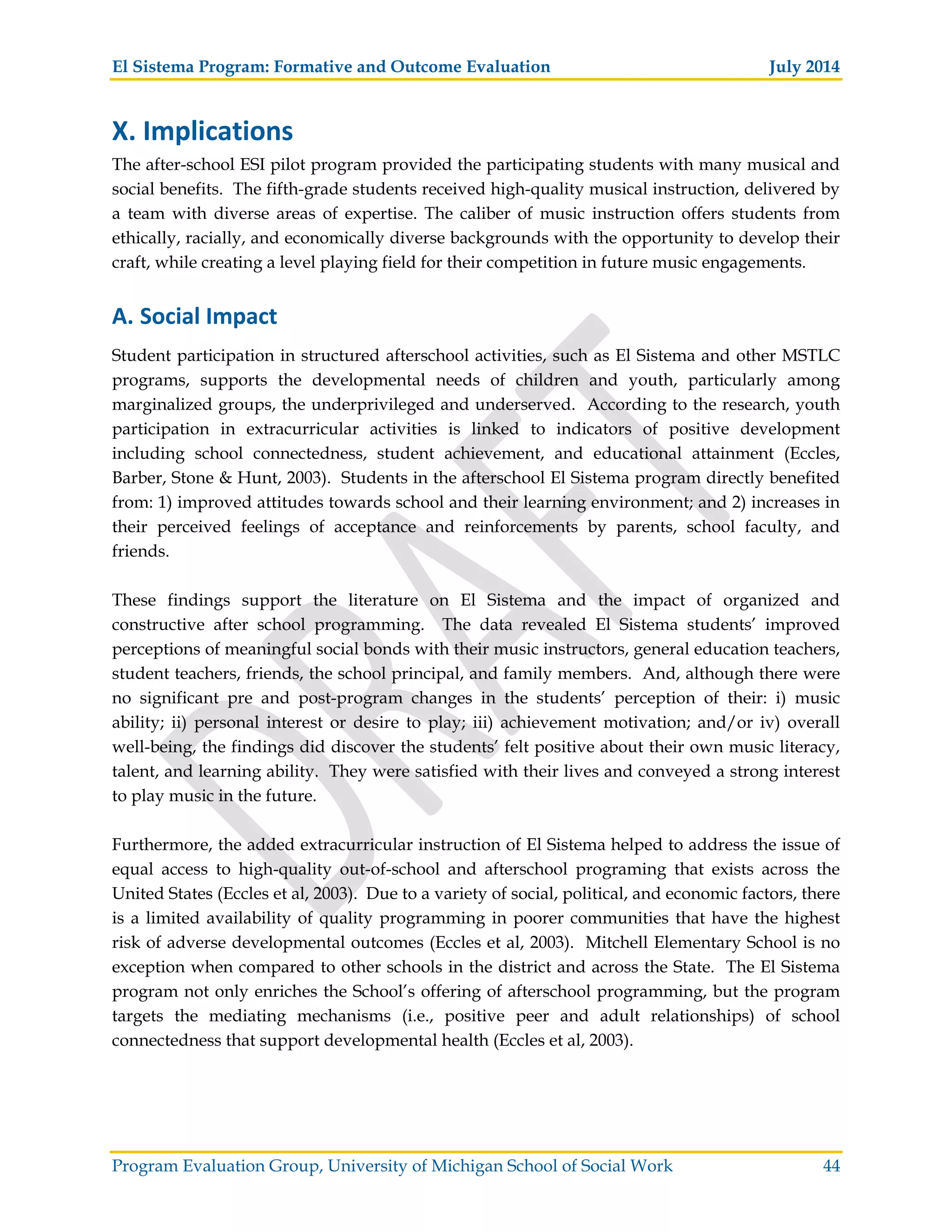
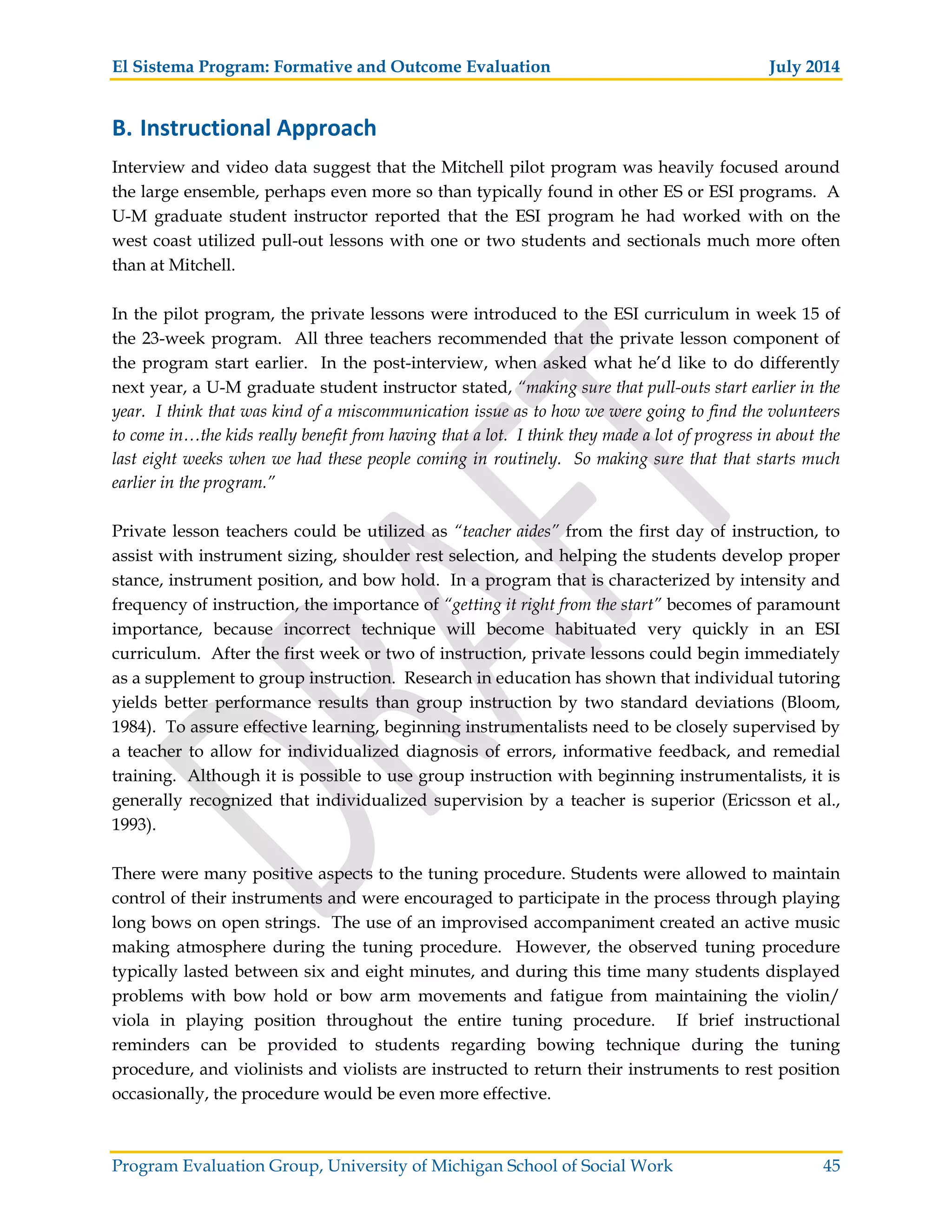
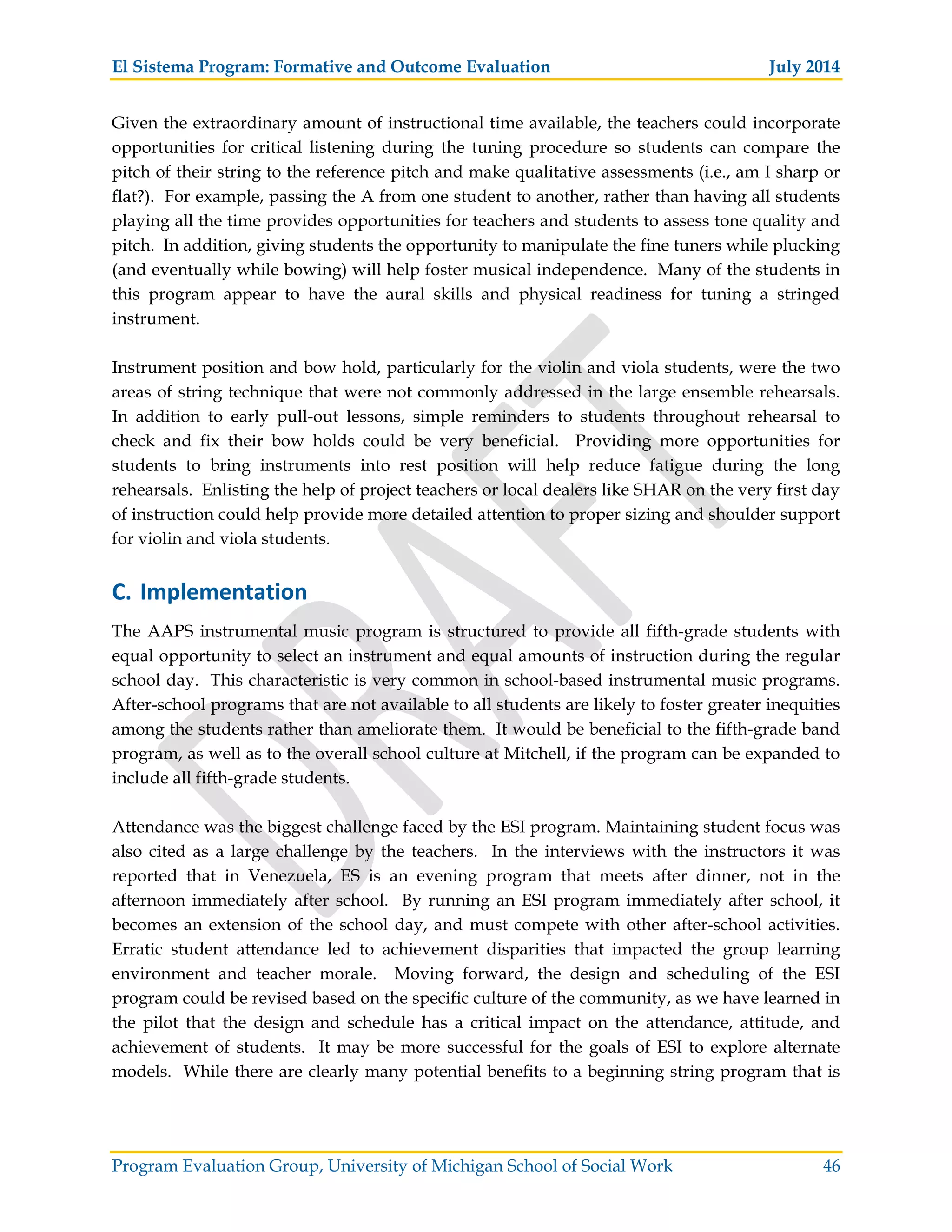
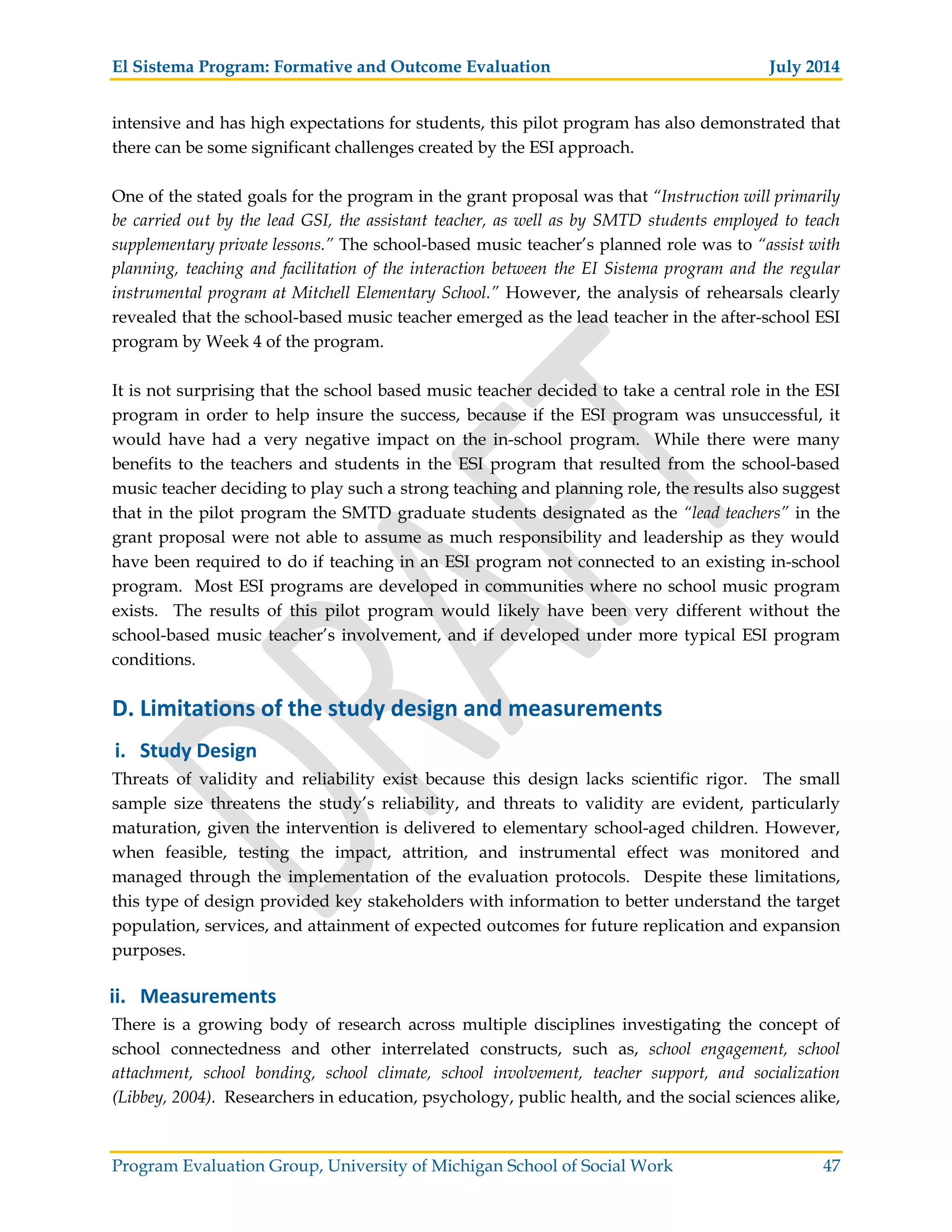
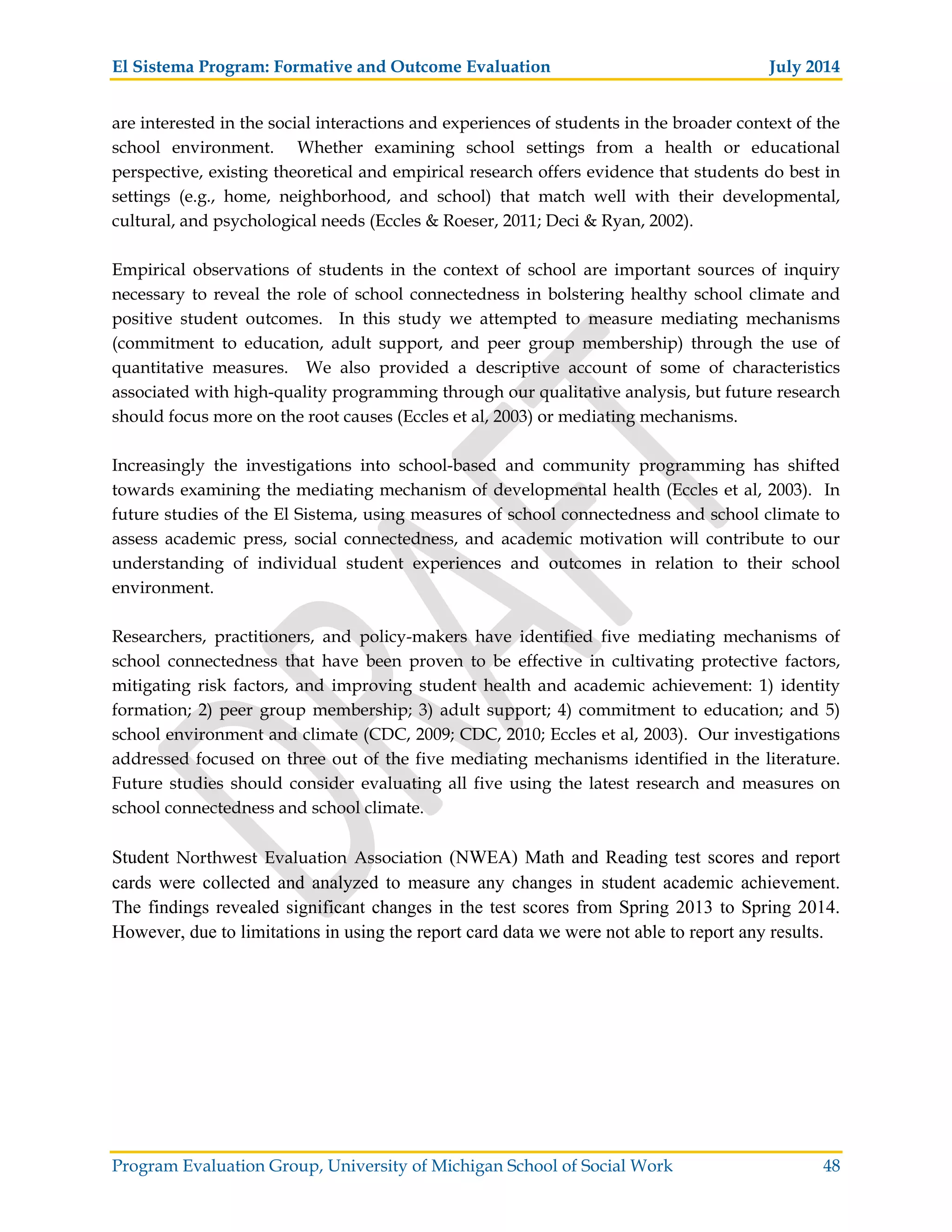
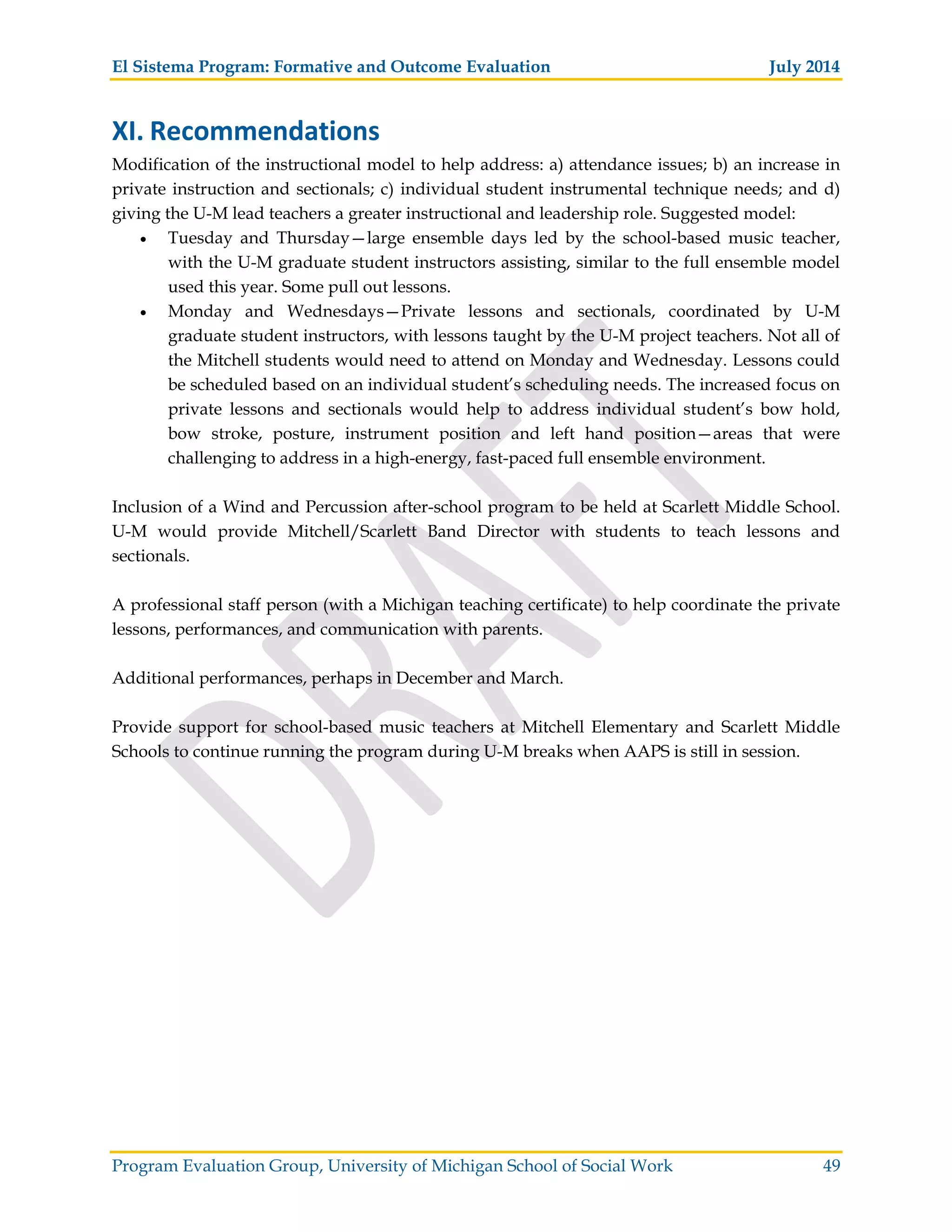
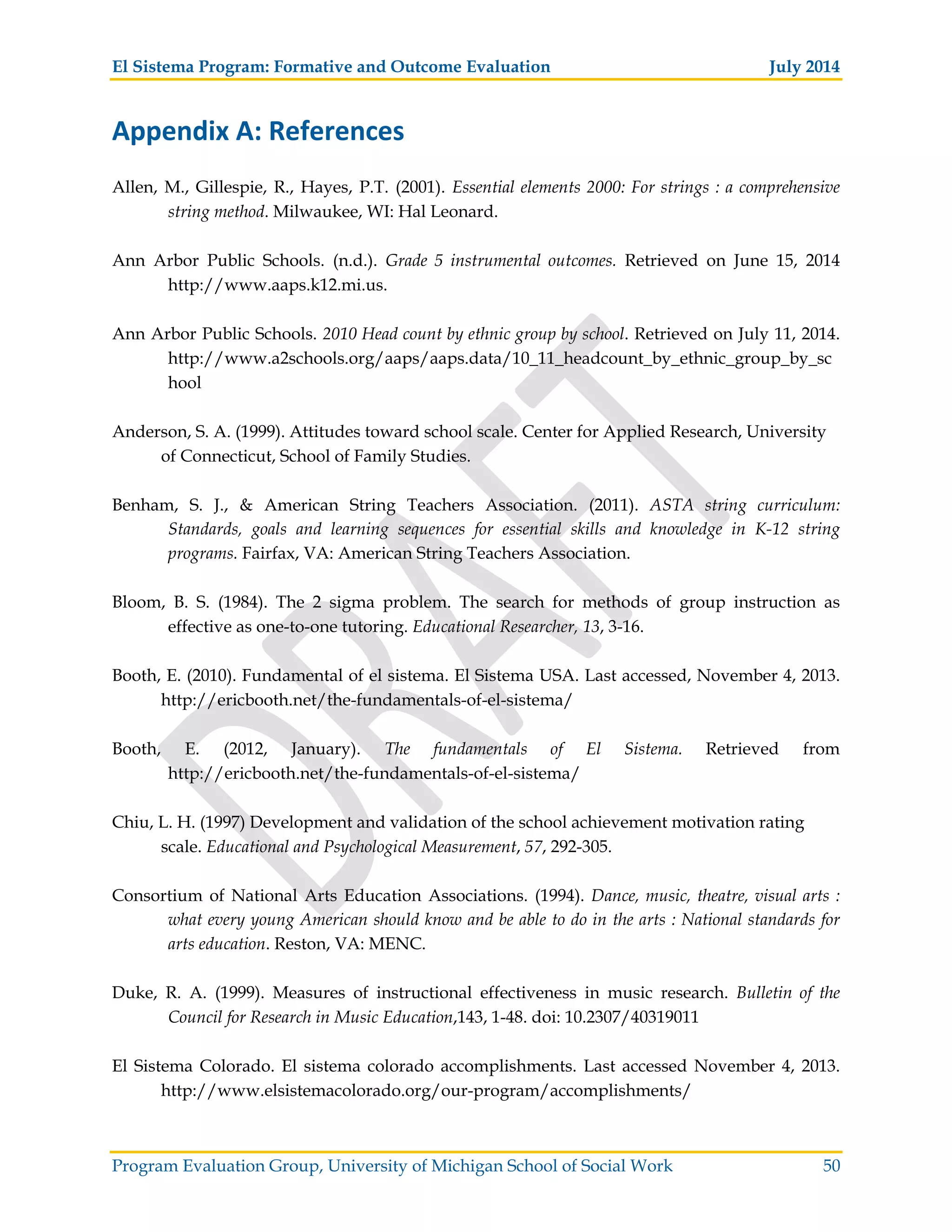


![El Sistema Program: Formative and Outcome Evaluation July 2014
Program Evaluation Group, University of Michigan School of Social Work 53
Appendix B: Background and Review of the Literature
El Sistema is a global movement that began thirty-eight years ago by Jose Antonio Abreu, an
economist and musician, discouraged by the fact that Venezuelans could not participate in
classical music. History tells us Abreu announced his plans to start a youth orchestra in the
burgeoning cosmopolitan capital city of Caracas, Venezuela. The initial rehearsal took place in
an abandoned parking structure with only eleven student musicians showing up (Tunstall,
2012). As the orchestra grew, so did Abreu’s understanding of what was being created – not
only a music center, but a catalyst for changing social and emotional lives of children and their
families (Tunstall, 2012, p. 71).
“To me, an orchestra is first and foremost a way to encourage better
human development within children. That is why I always said, and
I say today, that [El Sistema] is not an artistic program but a human
development program through music. It is very important to be clear
about this. Because everything that happened then, and everything that
happened since then, has been a direct consequence of this concept.”
Jose Antonio Abreu
Today, there are over 300 youth orchestras or “nucleos” throughout the Venezuela with the
majority funding provided by their federal government. Approximately 370,000 children and
youth currently participate in El Sistema, in country that has population of approximately 28
million people. Of the children and youth in the El Sistema program, there have been estimates
that between 70 and 90 percent live in poverty (Tunstall, 2012). Mitchell Elementary School has
a similar rate of poverty, approximately 80 percent, which is measured by the proportion of
students receiving free or reduced lunch. Modeling the Venezuelan program, El Sistema
Mitchell will deliver free music instruction, provide instruments, transportation, uniforms,
nutritious snacks, and offer access to social services.
Fundacion Musical Simon Bolivar is the Venezuelan government foundation that administers
the El Sistema program, and in 2010 had an operating budget of $120 million. Reports from the
Intra-American Development Bank (IDB), a private funder of Fundacion Musical Simon Bolivar
provides evidence that El Sistema participants have demonstrated better academic achievement
and fewer behavioral problems than children and youth who are not involved with El Sistema
(IDB, 2013). Furthermore, Venezuela’s national high school drop-out rate is over 26 percent,
although only 6.9 percent for students who have participated in the El Sistema program
(Tunstall, 2012).
In the United States, El Sistema Colorado has experienced similar success with half of teachers
at Garden Place Elementary reporting positive changes in the academic performance of students
who participated in El Sistema. These results did not show a reduction in drop-out rates.](https://image.slidesharecdn.com/9fe3a314-f4f1-49b9-be48-11714ceb9433-160508203325/75/El-Sistema-Formative-and-Outcome-Evaluation-Final-Report-DRAFT-071514-53-2048.jpg)

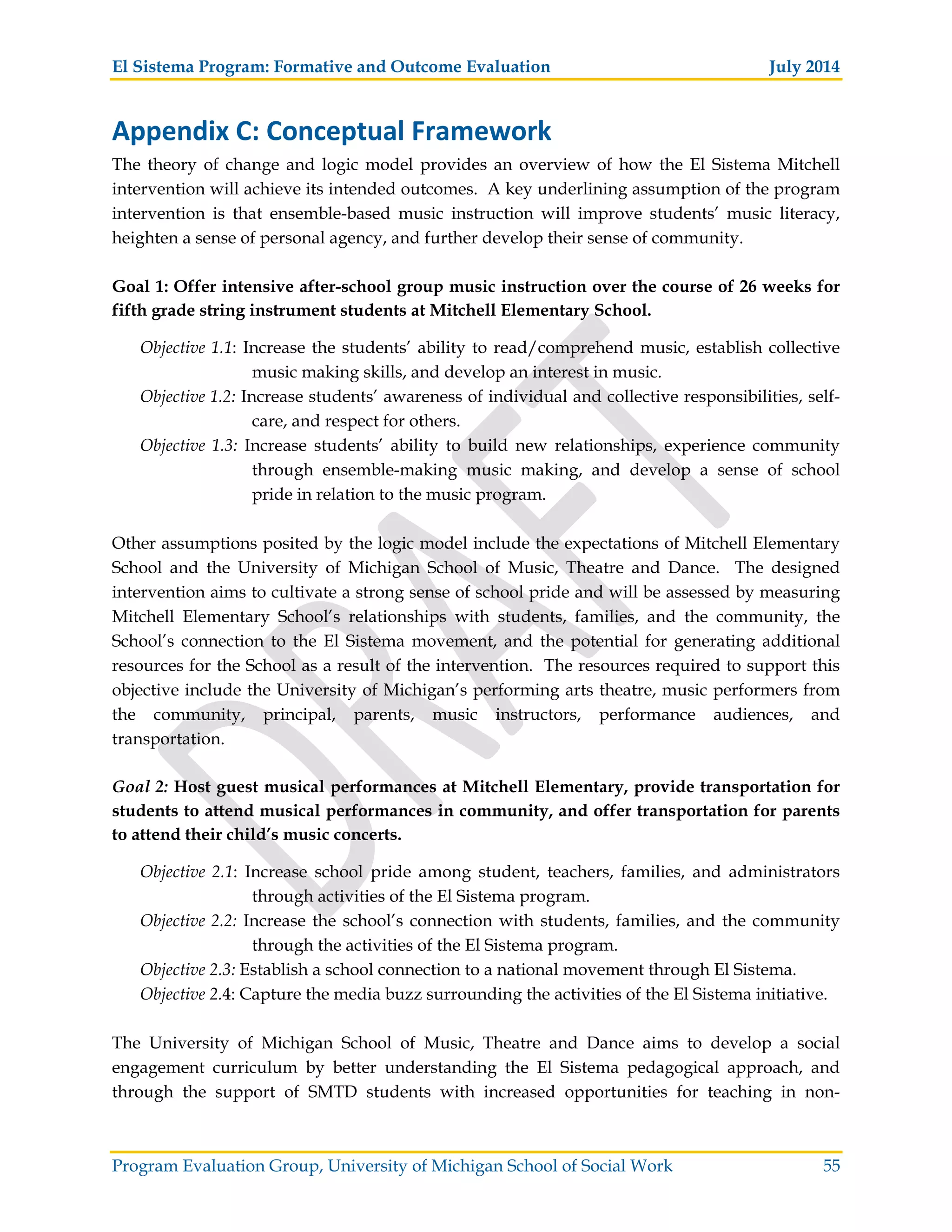
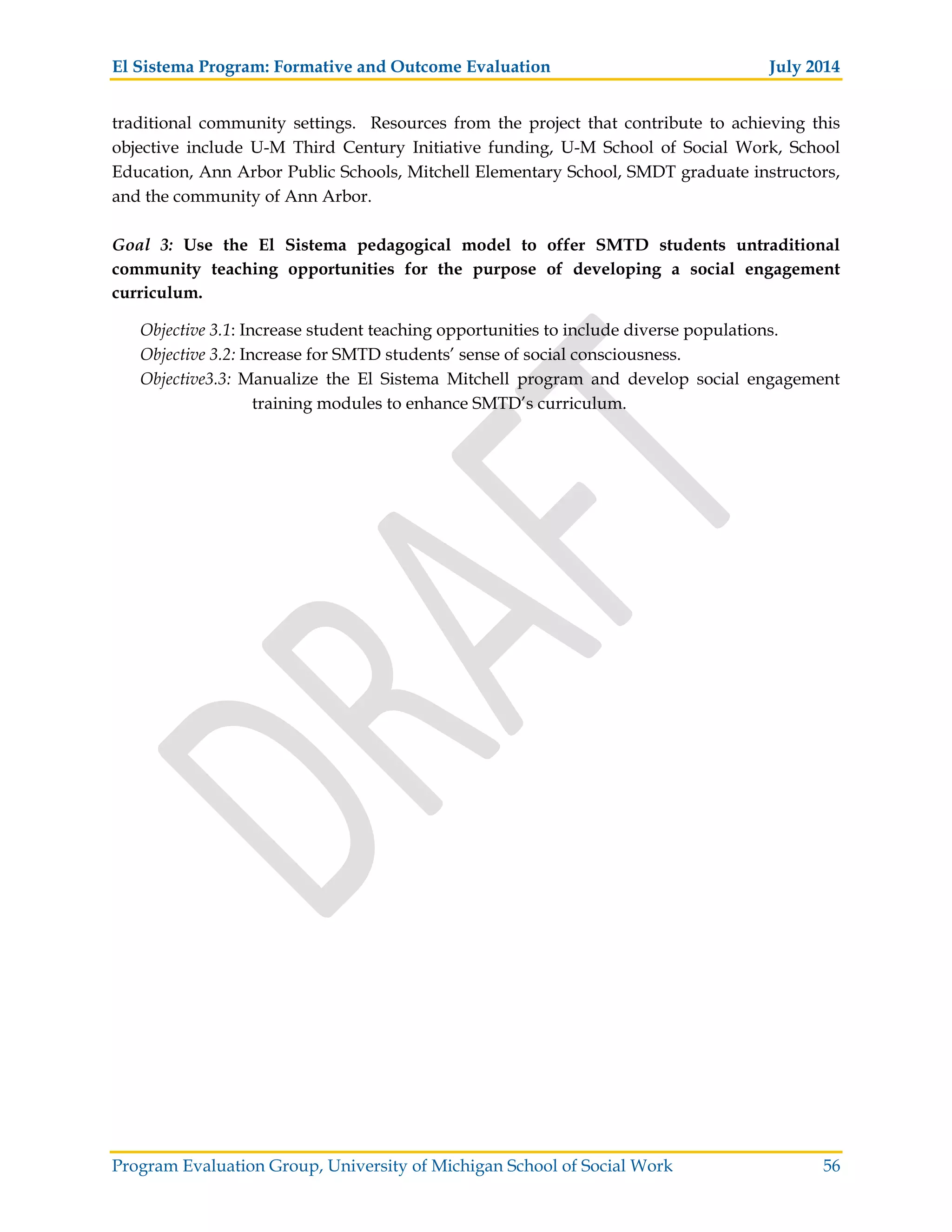
![El Sistema Program: Formative and Outcome Evaluation July 2014
Program Evaluation Group, University of Michigan School of Social Work 57
Appendix D: El Sistema Principles
1. Mission of social change. El Sistema is a social change/youth development program that
uses music to enable every child to feel like an asset within her or his community, inside
and outside the “nucleo.” Students feel an ownership of the music making process, taking
responsibility for both individual and group improvement.
2. Access and excellence. El Sistema includes as many children as it can, bringing young
people into its community whenever possible, as young as possible, for as long as possible,
whatever their background or abilities. As El Sistema strives single mindedly toward
musical excellence for all students, it also provides intensive training at “Academies” for the
most committed and gifted, preparing them for the highest-level national orchestras and
cultivating them as leaders in their own communities. In this way and others, the ideals of
access and excellence are maintained in a productive balance that maximizes both the fullest
success for all and highest accomplishment for some.
3. The nucleo environment. The nucleo is a physical location, within the students’
neighborhood where students live, that embodies the values and goals of El Sistema. It is a
haven of safety, fun, joy, and friendship, with an ethos of positivity and aspiration, where
all students are encouraged to explore their potential. The nucleo‘s doors are always open,
and community members convene in its hallways.
4. Intensity. Students spend a large amount of time at the nucleo, many hours per day, and
almost all days of the week, often building up to four hours per day, six days per week.
Rehearsals are fast paced and rigorous, demanding a durable commitment, personal
responsibility, and a strong work ethic. Through frequent performances, students have
many opportunities to excel and to share their accomplishments with their peers, family and
community.
5. The use of ensemble. The learning in El Sistema is based in ensemble experience in which
group achievement is balanced with individualized attention. The orchestra acts as a model
society in which an atmosphere of competition between individuals is replaced by shared
struggle. [Dr Abreu: “The orchestra is the only group that comes together with the sole
purpose of agreement.”] Smaller ensembles and choruses adopt the same ethos.
6. The CATS teacher model: Citizen/Artist/Teacher/Scholar. Those who work at the nucleo
take on many jobs and multiple roles in relationship to the students. By acting as citizens,
artists, teachers and scholars, these adults encourage their students to develop holistically:
as active musicians, helpful educators, inquisitive learners and responsible civic
contributors.
7. The multi-year continuum. El Sistema provides a “conveyor belt” of services, supporting its
students from early childhood into adulthood. Despite variation in resources and practices,](https://image.slidesharecdn.com/9fe3a314-f4f1-49b9-be48-11714ceb9433-160508203325/75/El-Sistema-Formative-and-Outcome-Evaluation-Final-Report-DRAFT-071514-57-2048.jpg)


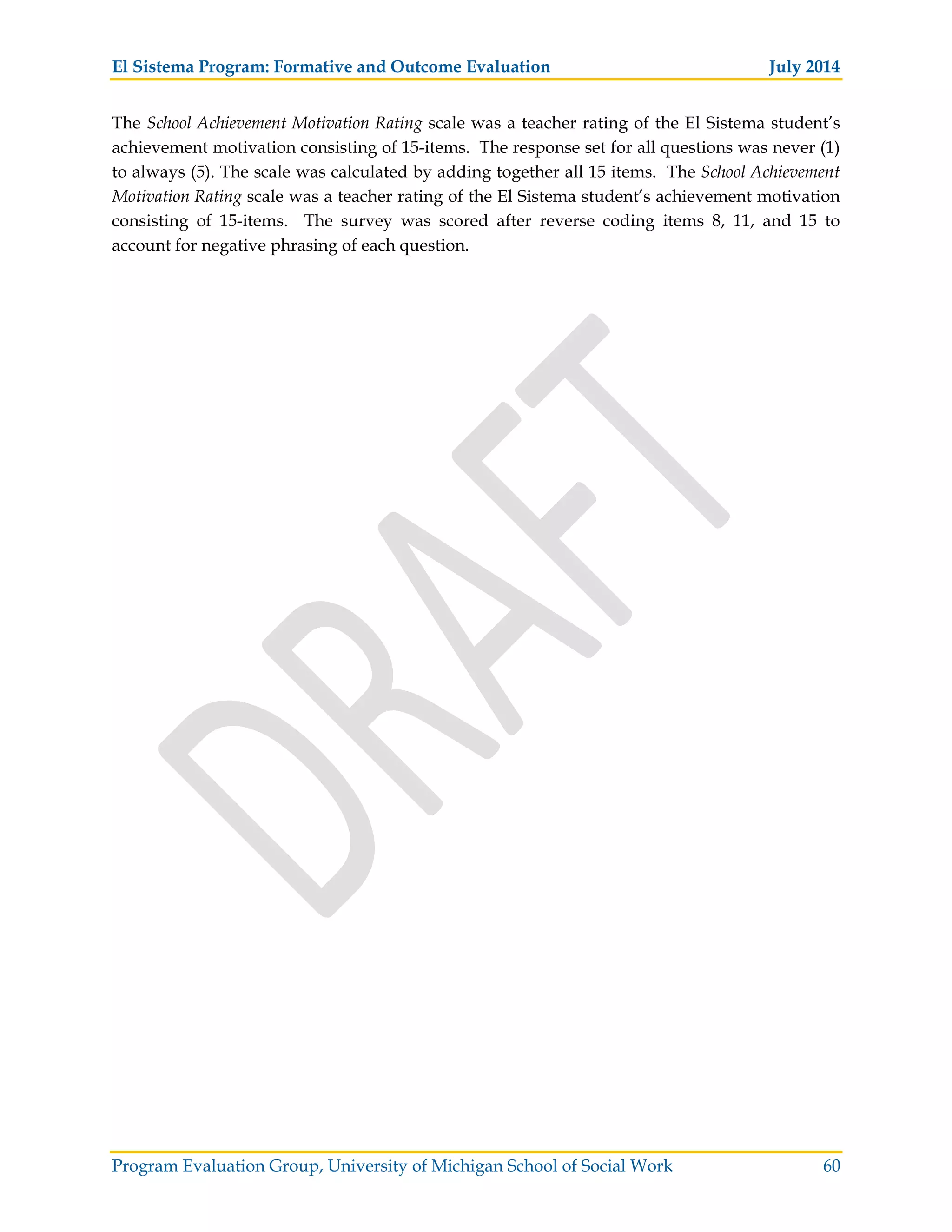
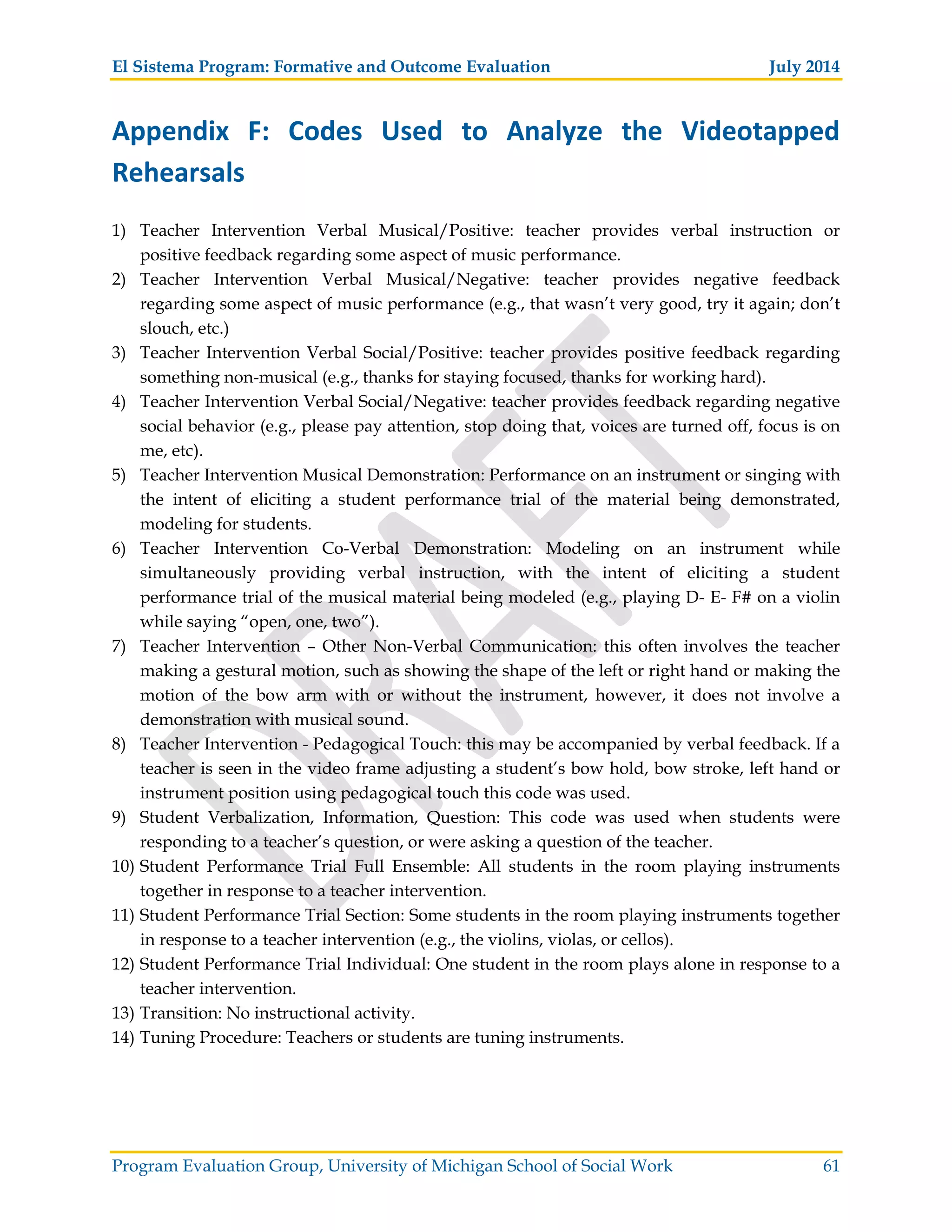
![El Sistema Program: Formative and Outcome Evaluation July 2014
Program Evaluation Group, University of Michigan School of Social Work 62
Rehearsals were also coded to determine which of the following skills were addressed by the
teachers in rehearsal:
1) Instrument Skills —Bowing
a. Bow Hold
b. Basic bow stroke (Weight, angle, speed, placement, tone quality)
2) Instrument Skills— Instrument Position and Left Hand Skills
a. Body posture
b. Instrument position
c. Left-hand position
d. Finger patterns, fingering
3) Music Literacy—defined as “an association of sound-to-symbol, in a given musical
context, which includes: predictive components (understanding of reading based on
audiation of written material) and knowledge of symbols and notation related to pitch,
rhythm, dynamics, tonality, clef, articulation, etc.), based on the principle that sound
comes before sight (Benham et al., 2011, p. 190).
a. read basic rhythmic notation using whole notes, half notes, quarter notes and
eighth notes and corresponding rests
b. perform simple rhythmic combinations listed above
c. read basic musical symbols
d. read and perform appropriate music in 2/4, 3/4 and 4/4 time signatures
4) Aural Skills—imitating simple patterns by ear, raising and lowering pitches by ear,
playing scales by ear
5) Rehearsal Skills— playing together with other students, showing self-discipline and
learning to play independently, contributing to group discipline and help create an
atmosphere for learning [I need to rethink this, because how can yo have an ensemble
rehearsal without students playing together? Does there need to be specific verbal
instruction addressing this?]
6) Expressive Skills — playing with dynamics, articulations, bowings (slurs, upbow,
downbow), simple phrasing, musical sensitivity
7) Attitude — fostering a positive attitude toward music learning and playing,
experiencing joy and self-pride in performing well.](https://image.slidesharecdn.com/9fe3a314-f4f1-49b9-be48-11714ceb9433-160508203325/75/El-Sistema-Formative-and-Outcome-Evaluation-Final-Report-DRAFT-071514-62-2048.jpg)
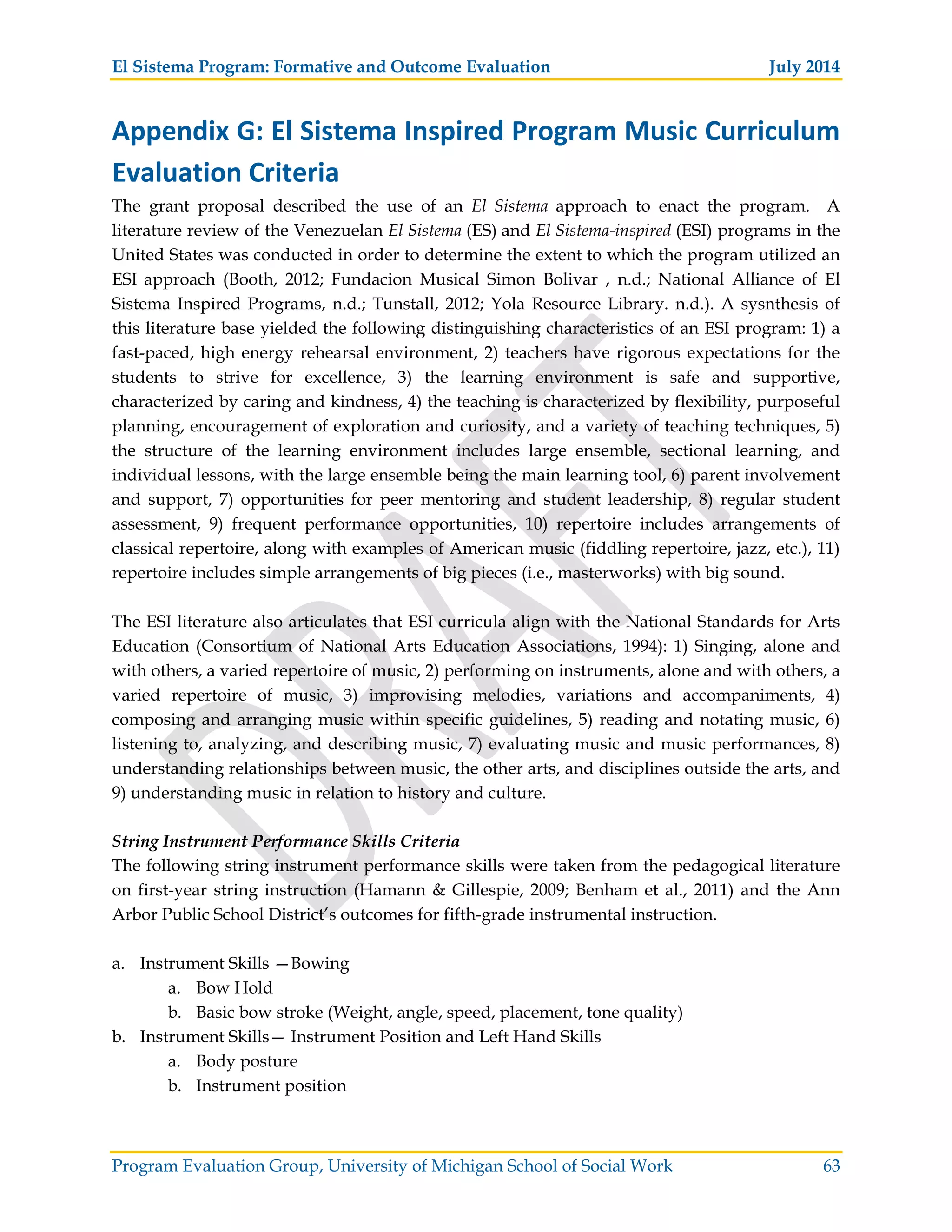
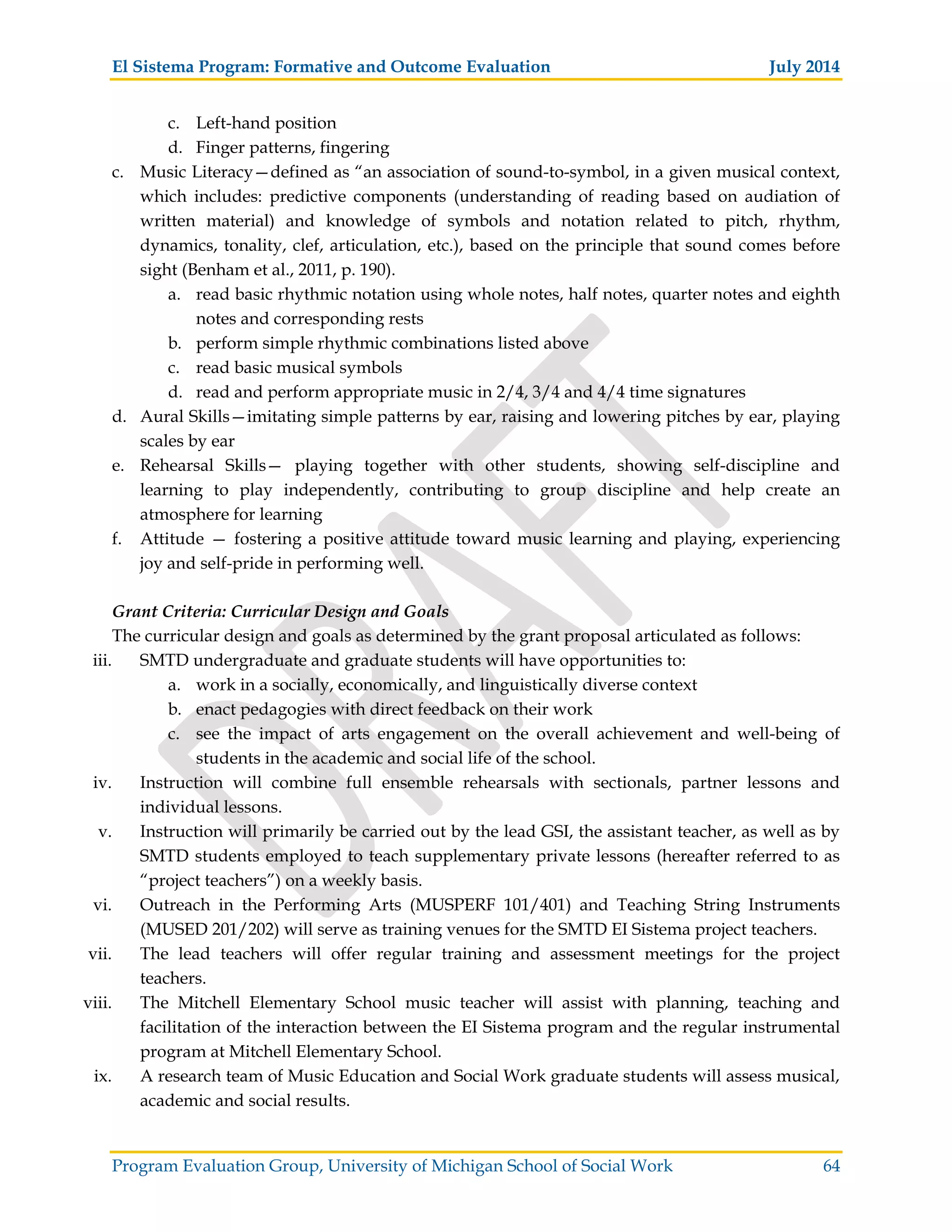
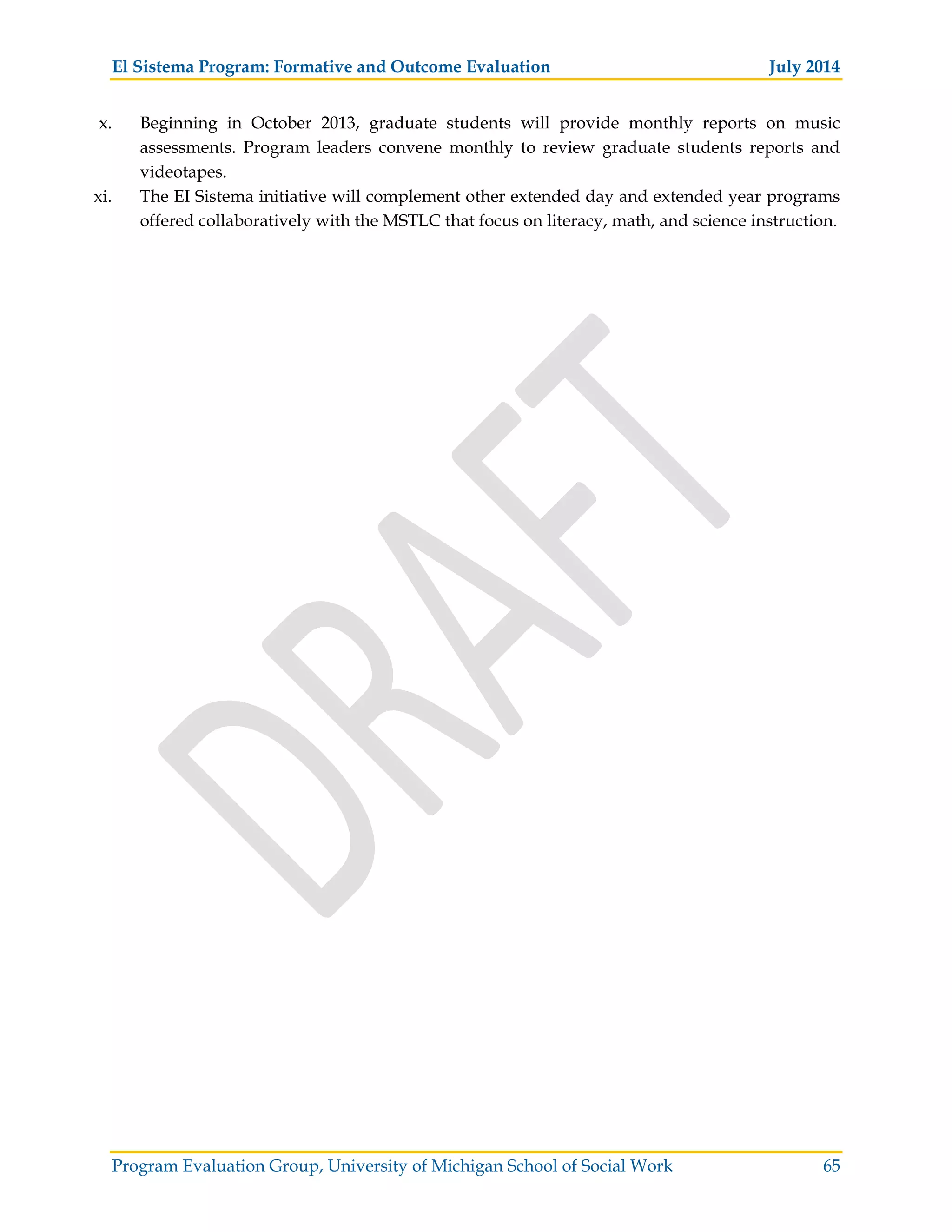
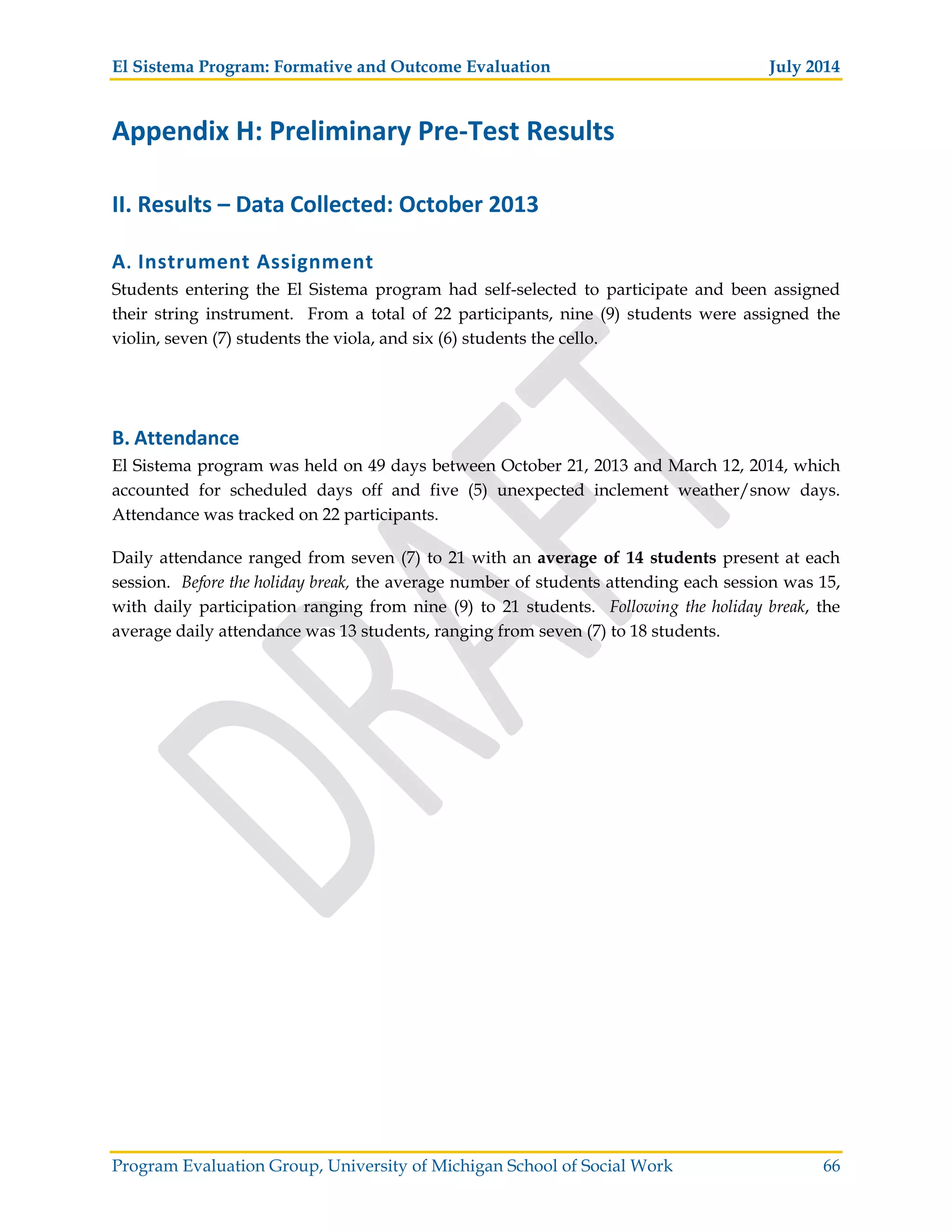
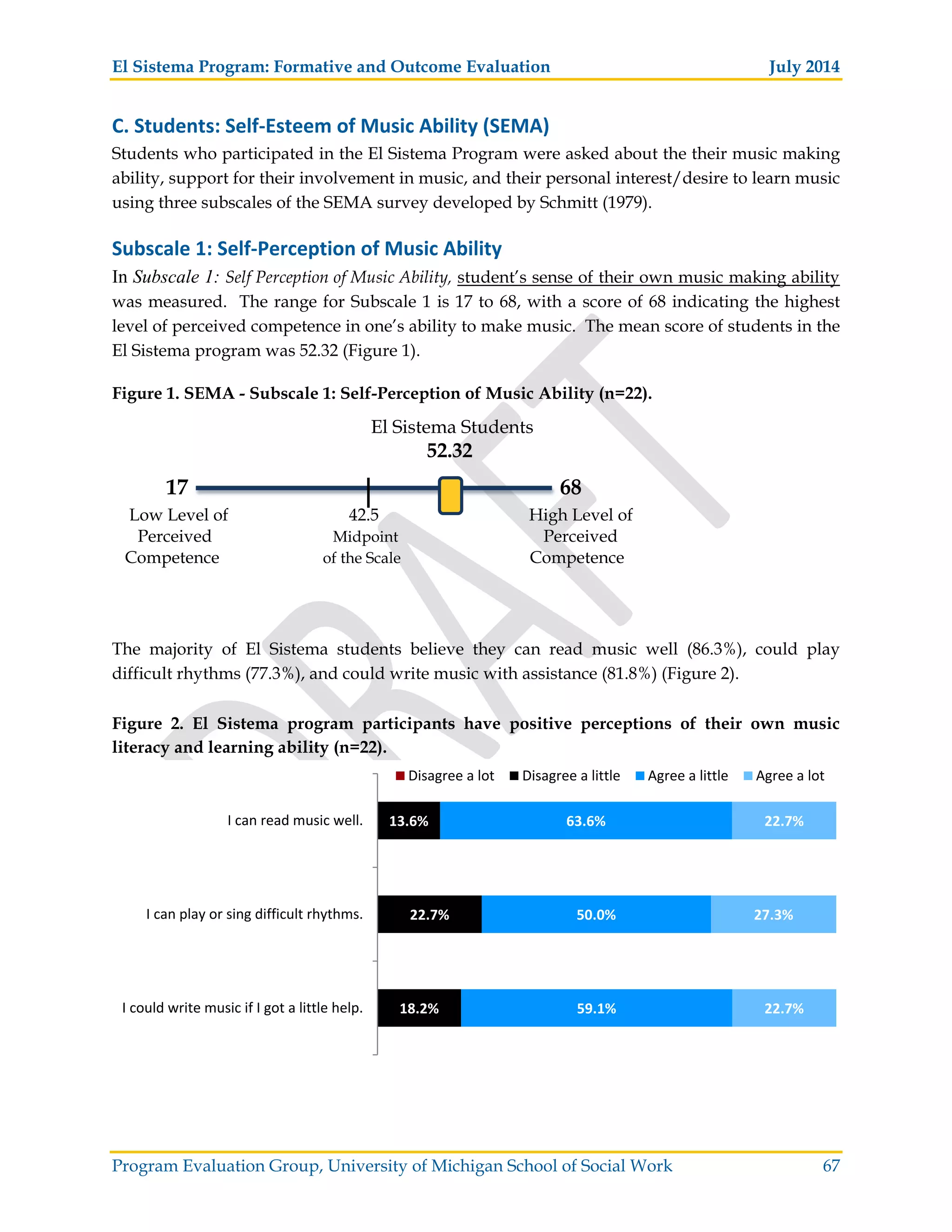
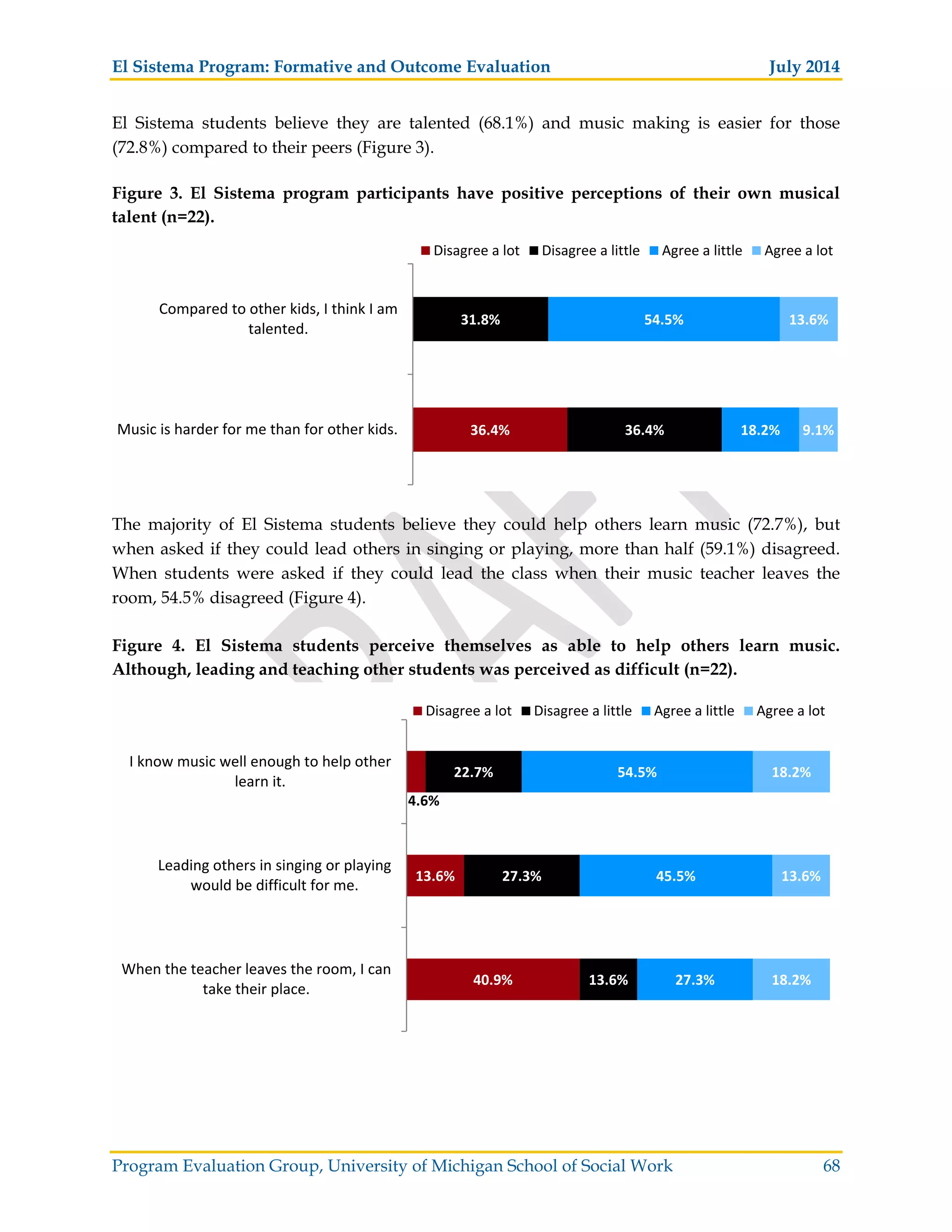
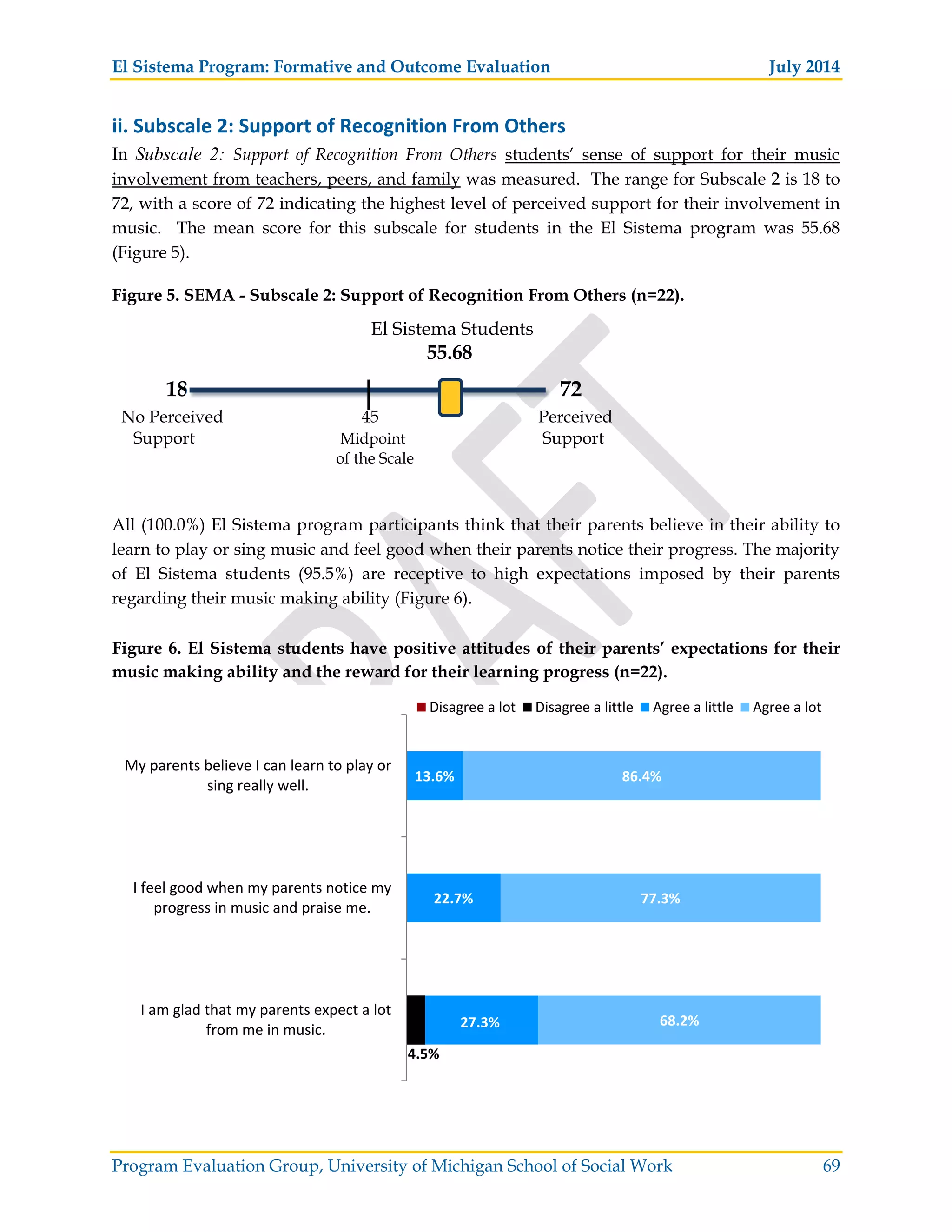
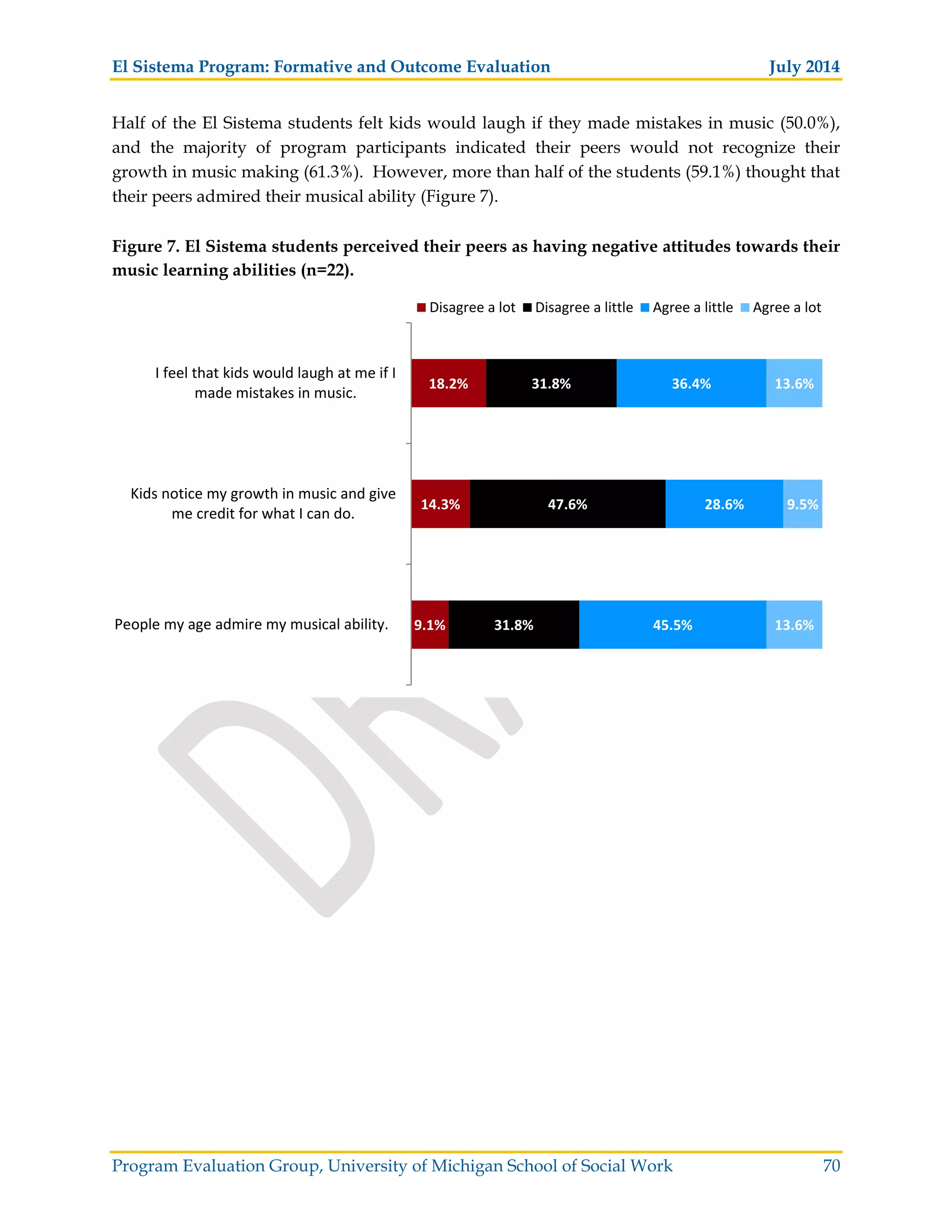
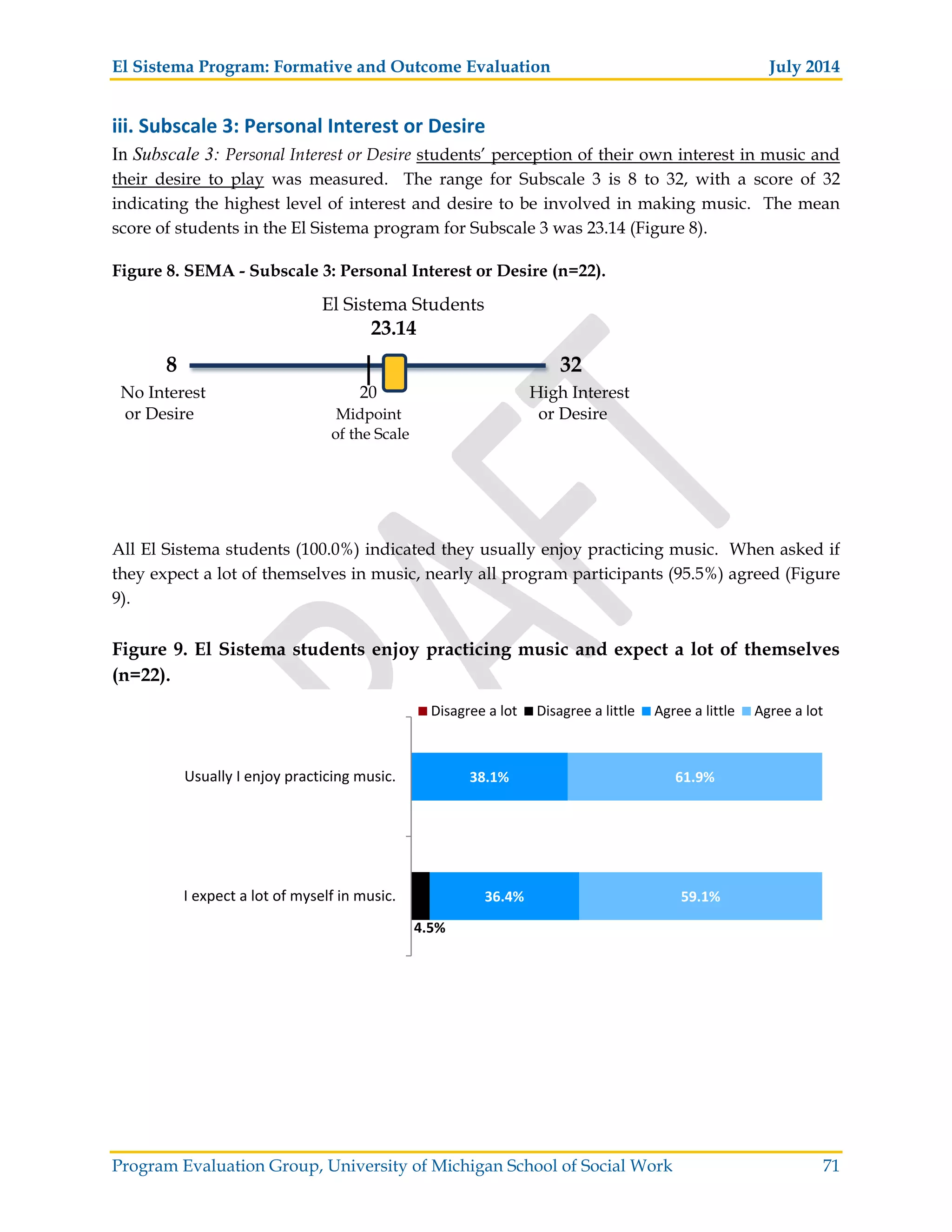

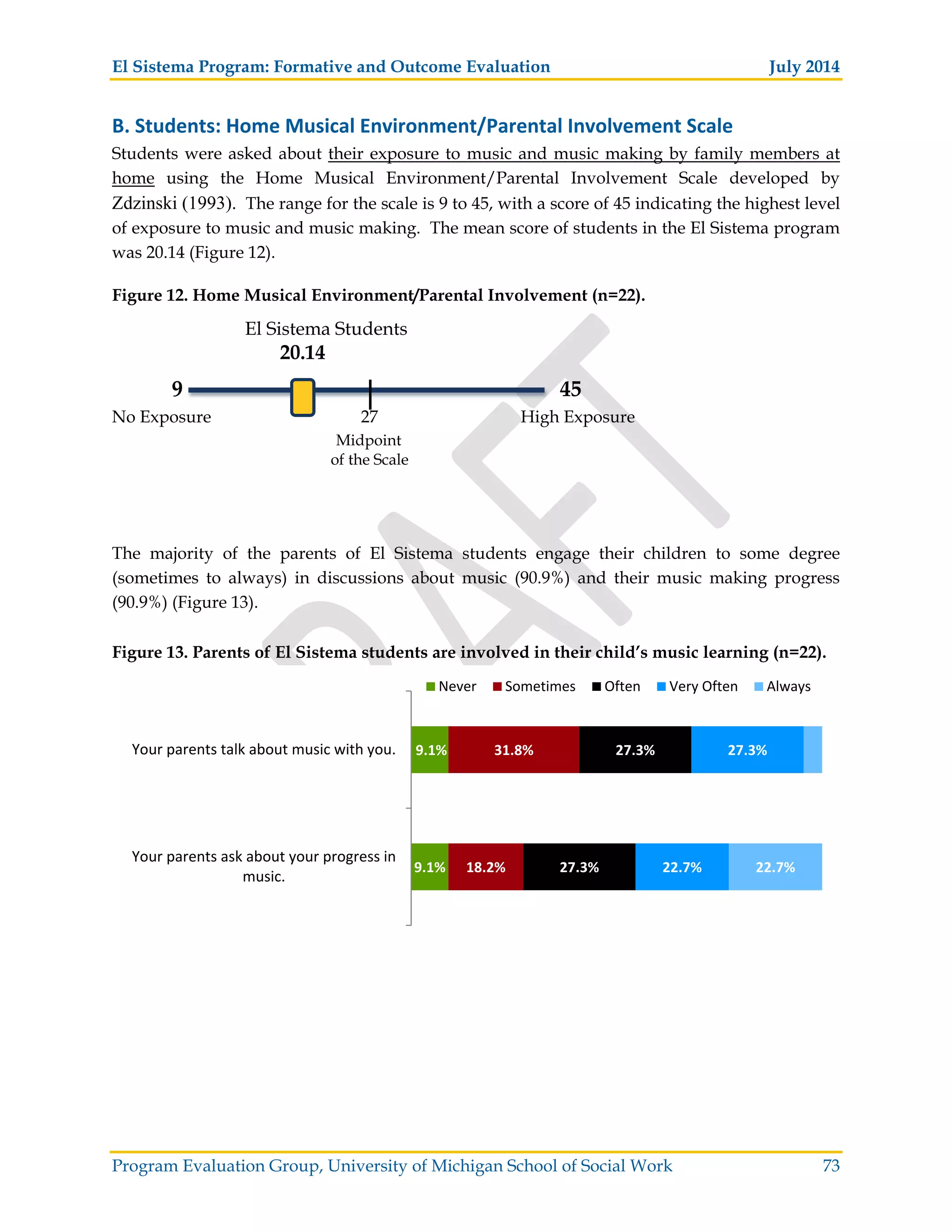
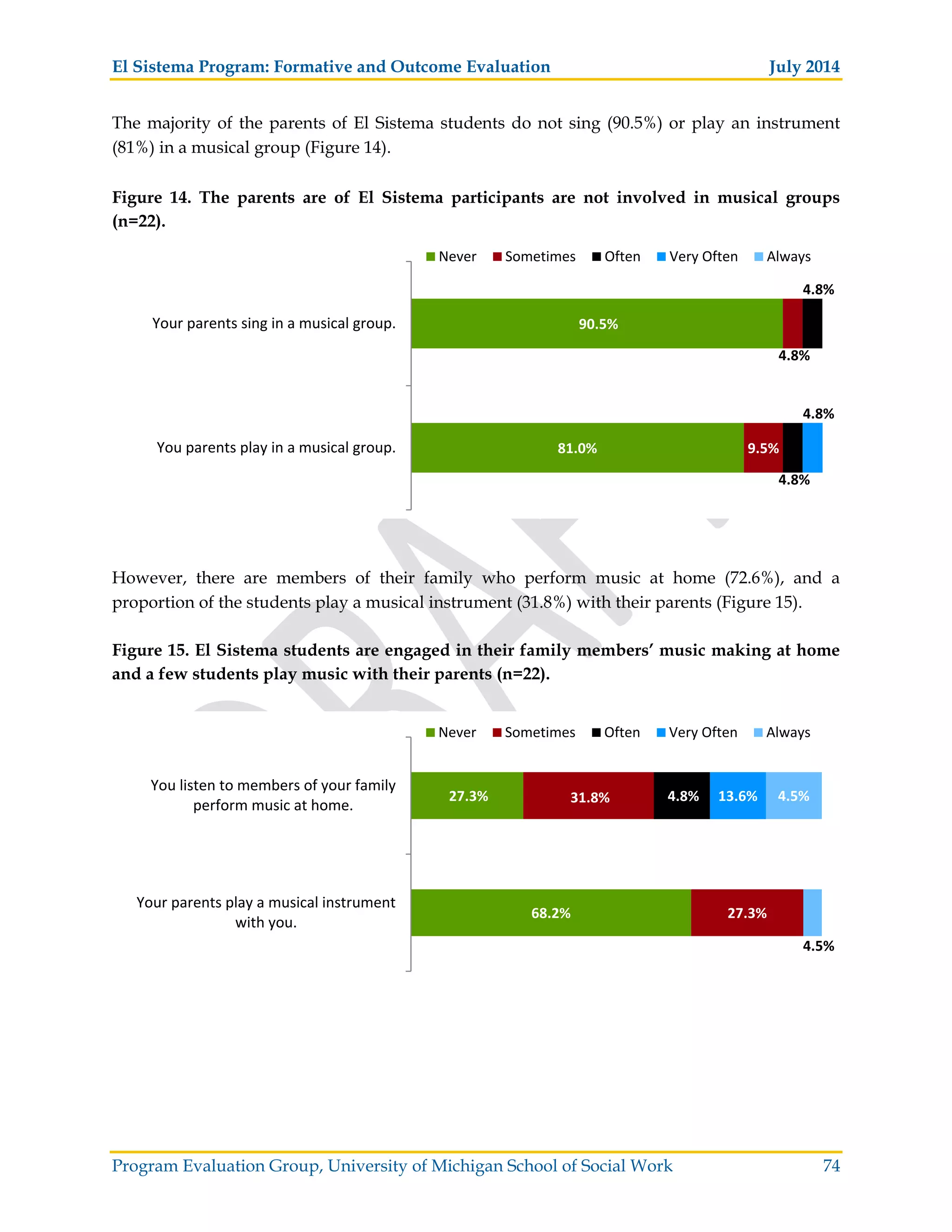

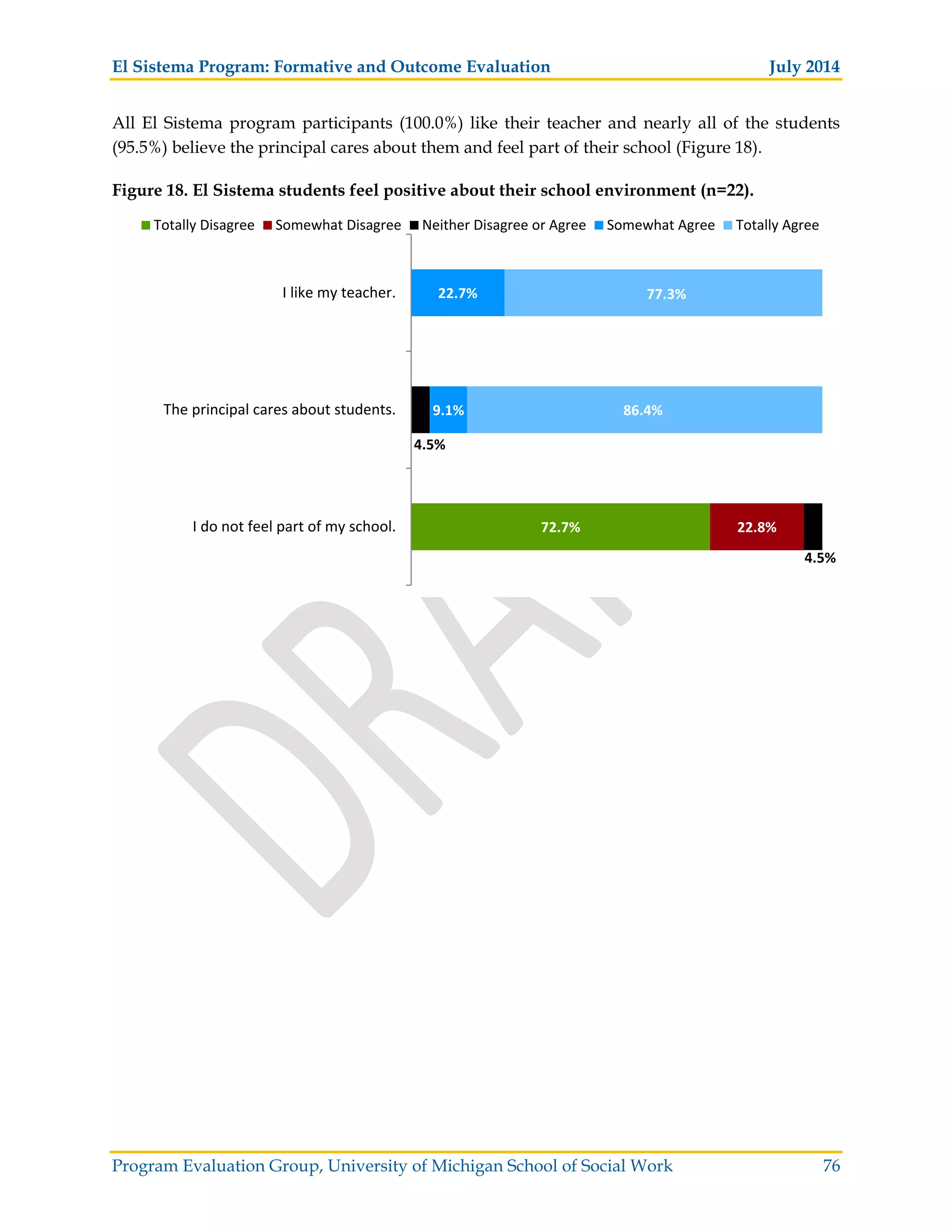
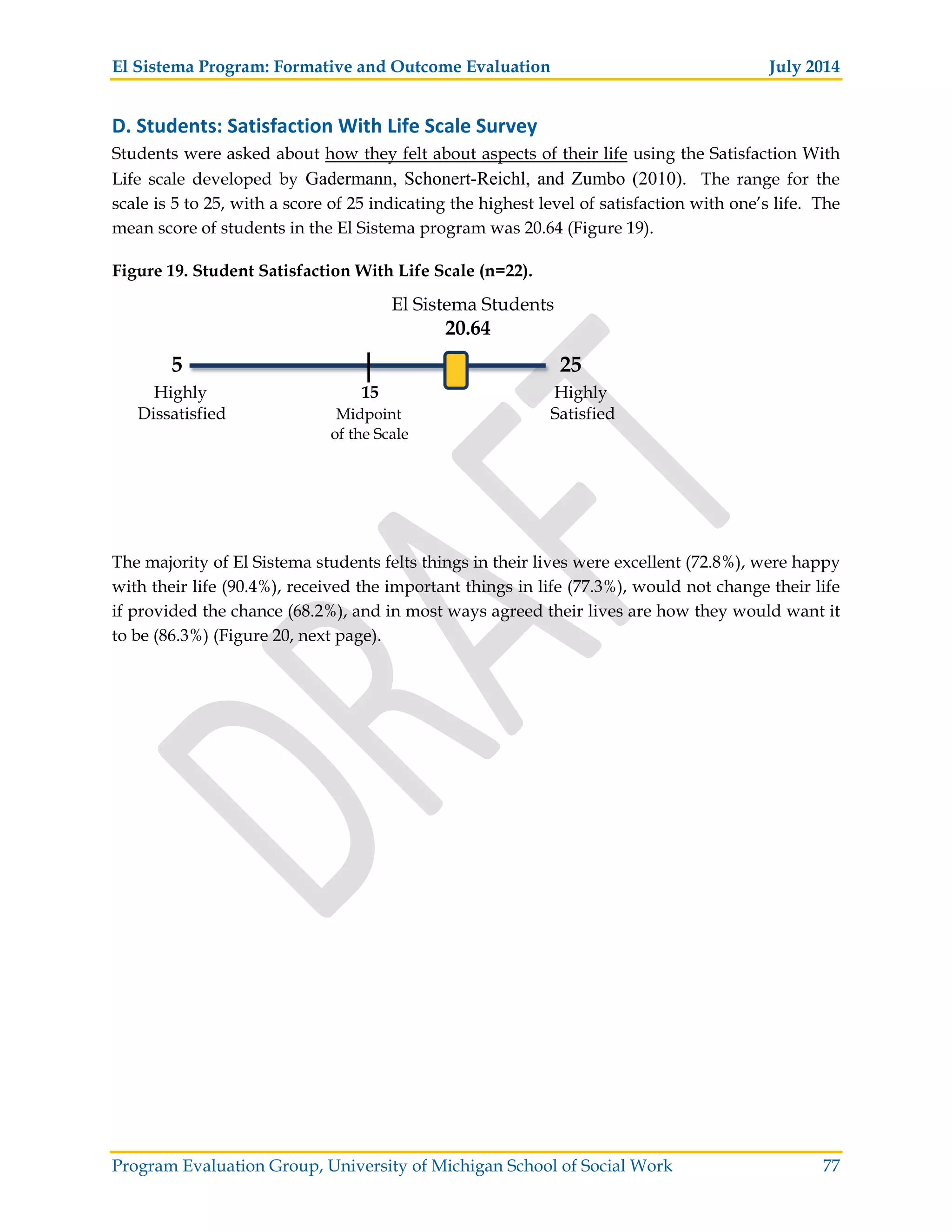
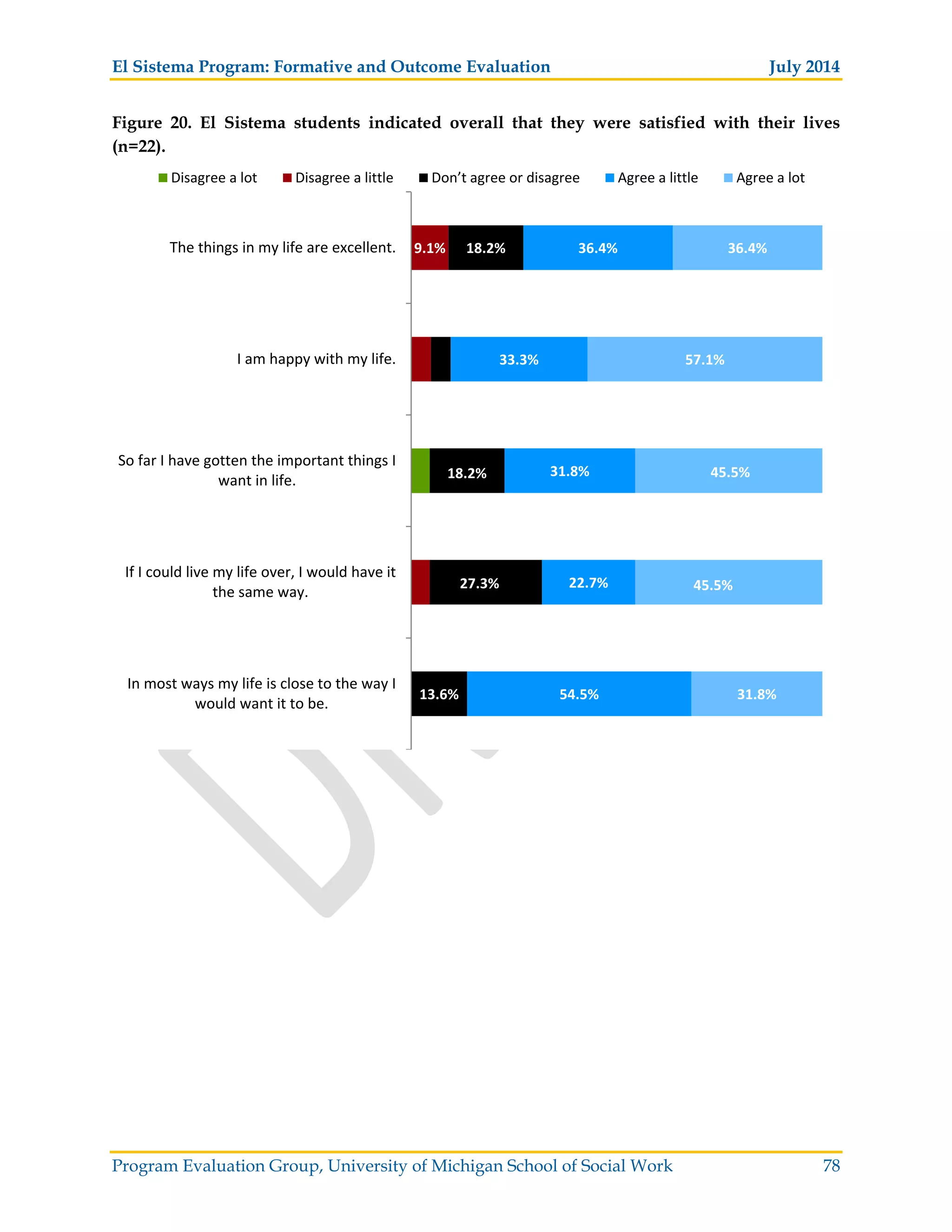
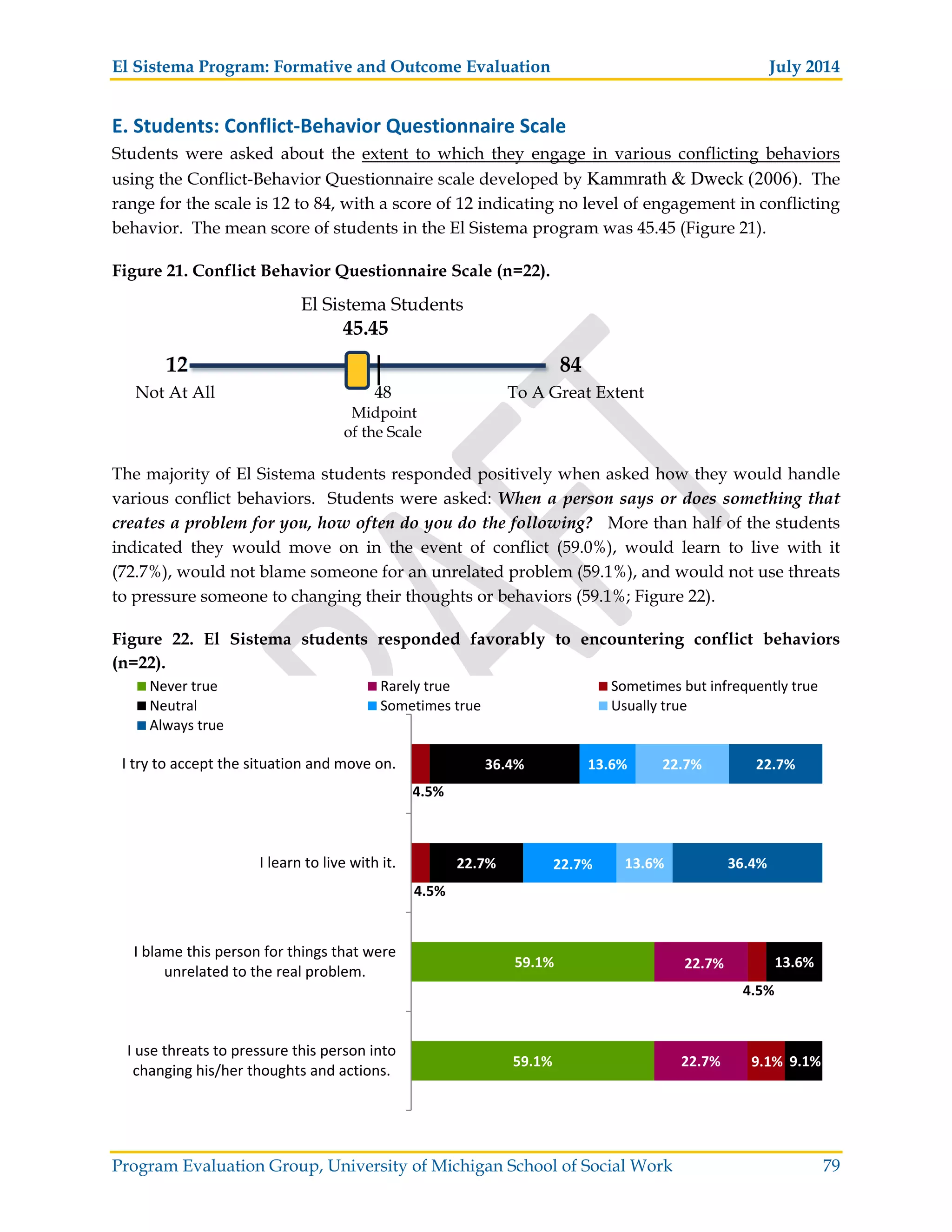
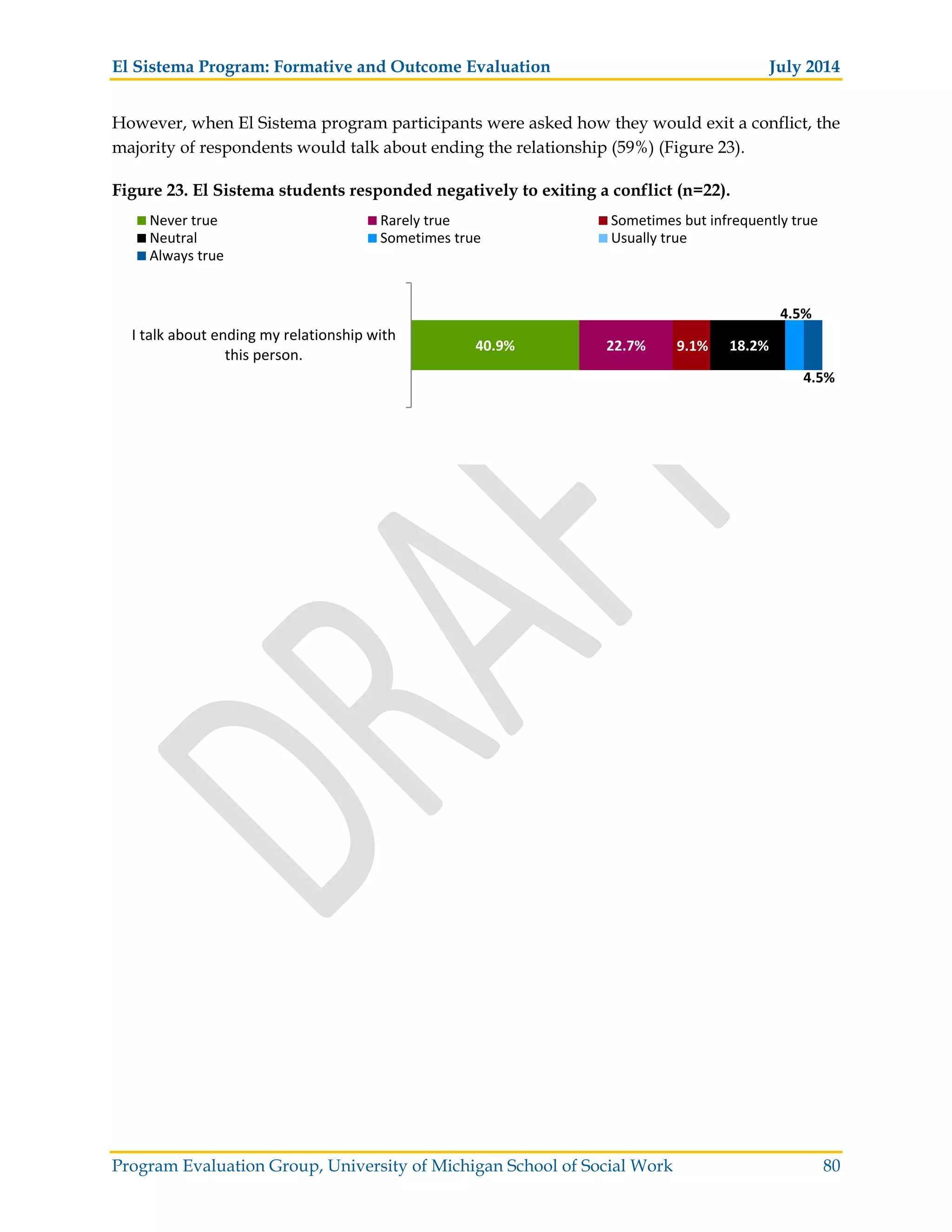
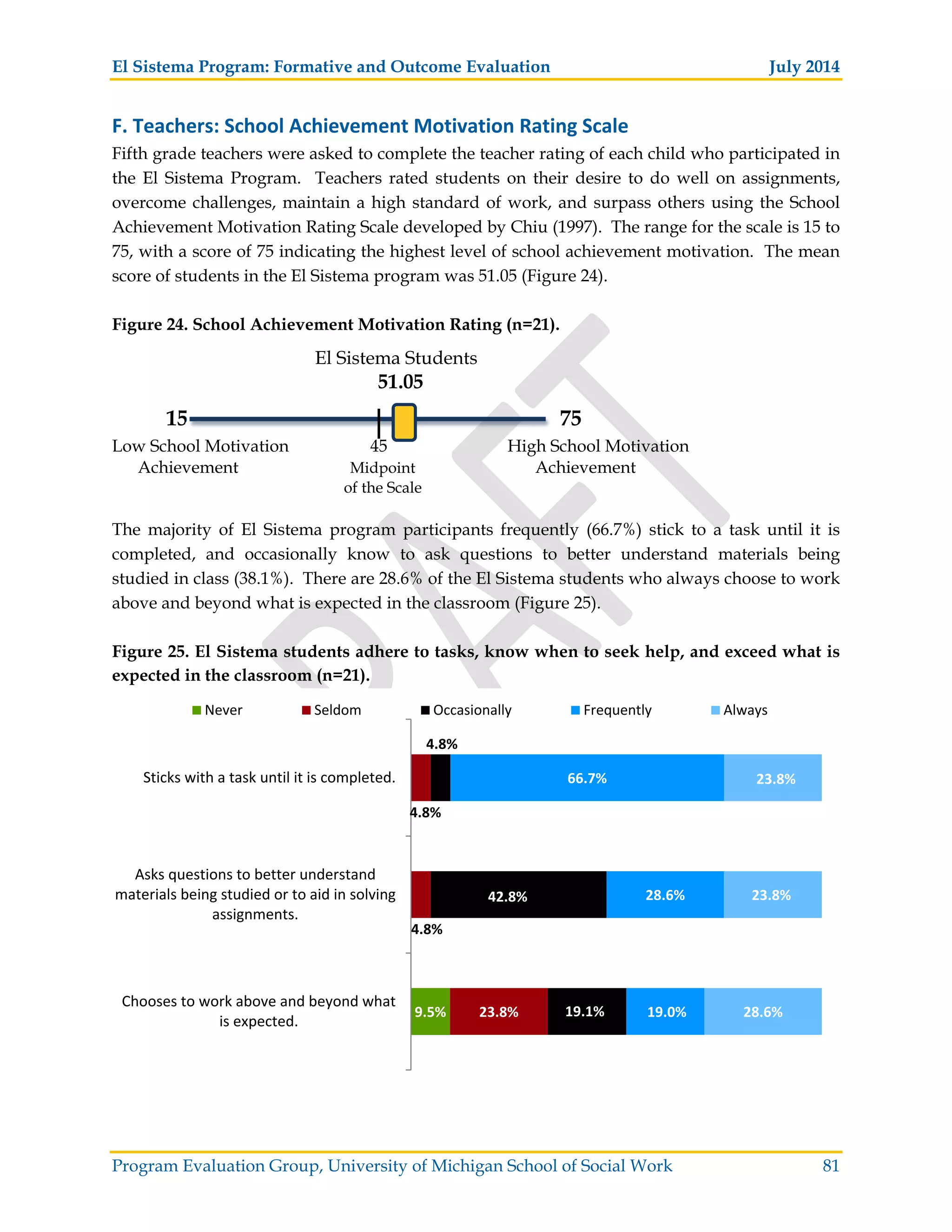
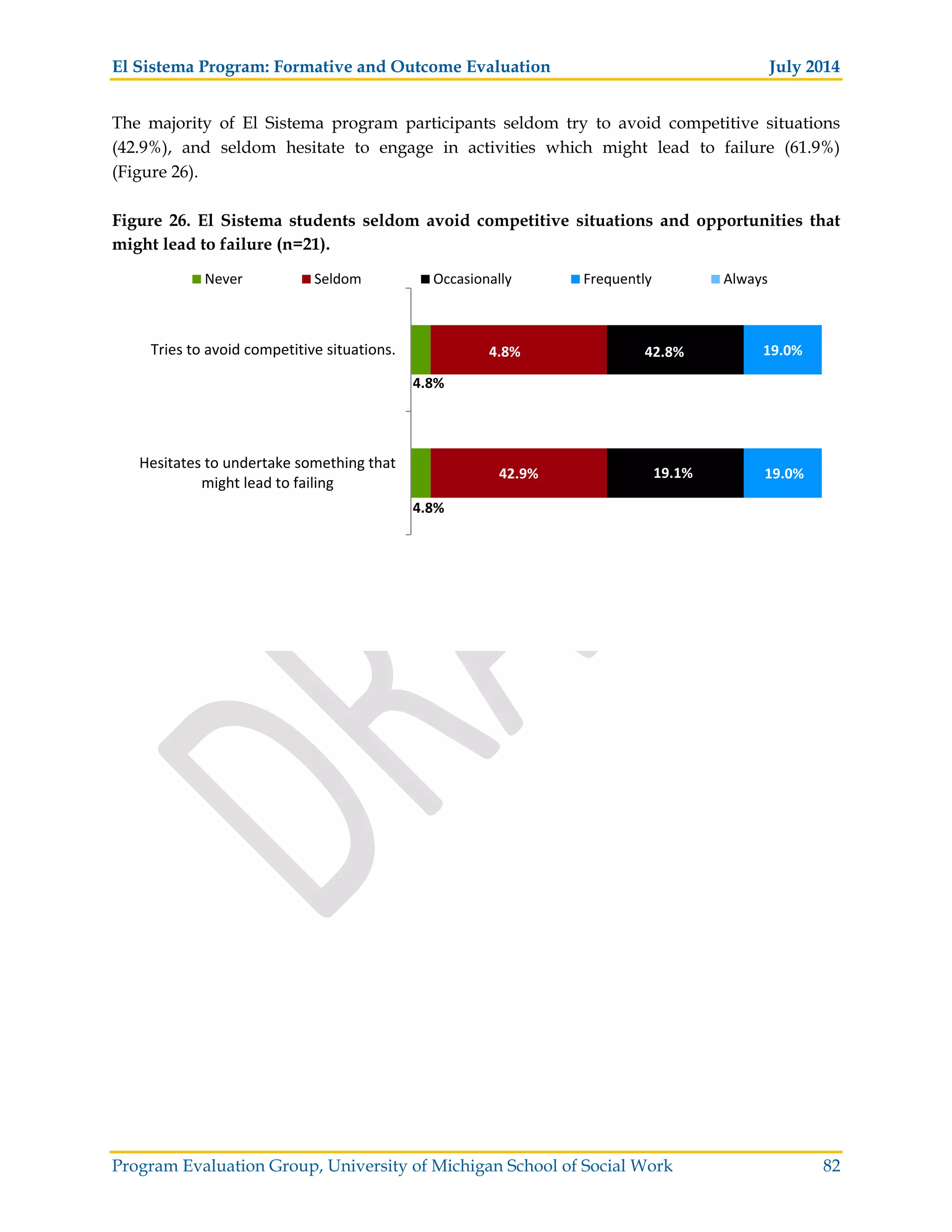
![El Sistema Program: Formative and Outcome Evaluation July 2014
Program Evaluation Group, University of Michigan School of Social Work 83
G. Parental Questionnaire
Parental guardians were asked the following question: What are you hoping your child gets
out of this afterschool music program?
The results from the questionnaire depicted seven (7) themes listed below in order from the
highest to the lowest response rate.
Learns to play an instrument = 47.1% (8 of 17 responses): Respondents identified that they were
primarily interested in seeing their child learn to play a musical instrument.
“It is very important my child learn to play an instrument. I want her to be very smart student
in music and other instruments.”
“Learn how to play viola.”
“Able to play the violin.”
Learns to appreciate different cultures and genres of music = 47.1% (8 of 17 responses):
Respondents indicated that they were interested in their children learning about new cultures
and music from around the world.
“An understanding and appreciation of various types of music from around the world.”
“[Develop a] love of music – classical, jazz, etc.”
“I want my daughter to appreciate things is life – concerts, good music, etc.”
Develops an improved sense of personal agency = 23.5% (4 of 17 responses): Respondents
identified an interest in seeing their children become more self-confident, self-disciplined, and
develop improved executive functioning skills.
“I hope [my child] learns to be more self-disciplined, and that she will develop a more optimistic
outlook on things.”
“Able to use what she has learned and apply to viola and guitar, and mostly to her life.”
“Use music to connect with others.”
Improves intellectual skills = 17.6% (3 of 17 responses): Respondents identified an interest in
seeing their children strengthen their intellectual ability.
“I think that this program is good for the performance of my daughter as well as for her
intellectual skills.”
“I believe this experience will lead to a greater knowledge and skill than she would get otherwise.”](https://image.slidesharecdn.com/9fe3a314-f4f1-49b9-be48-11714ceb9433-160508203325/75/El-Sistema-Formative-and-Outcome-Evaluation-Final-Report-DRAFT-071514-83-2048.jpg)
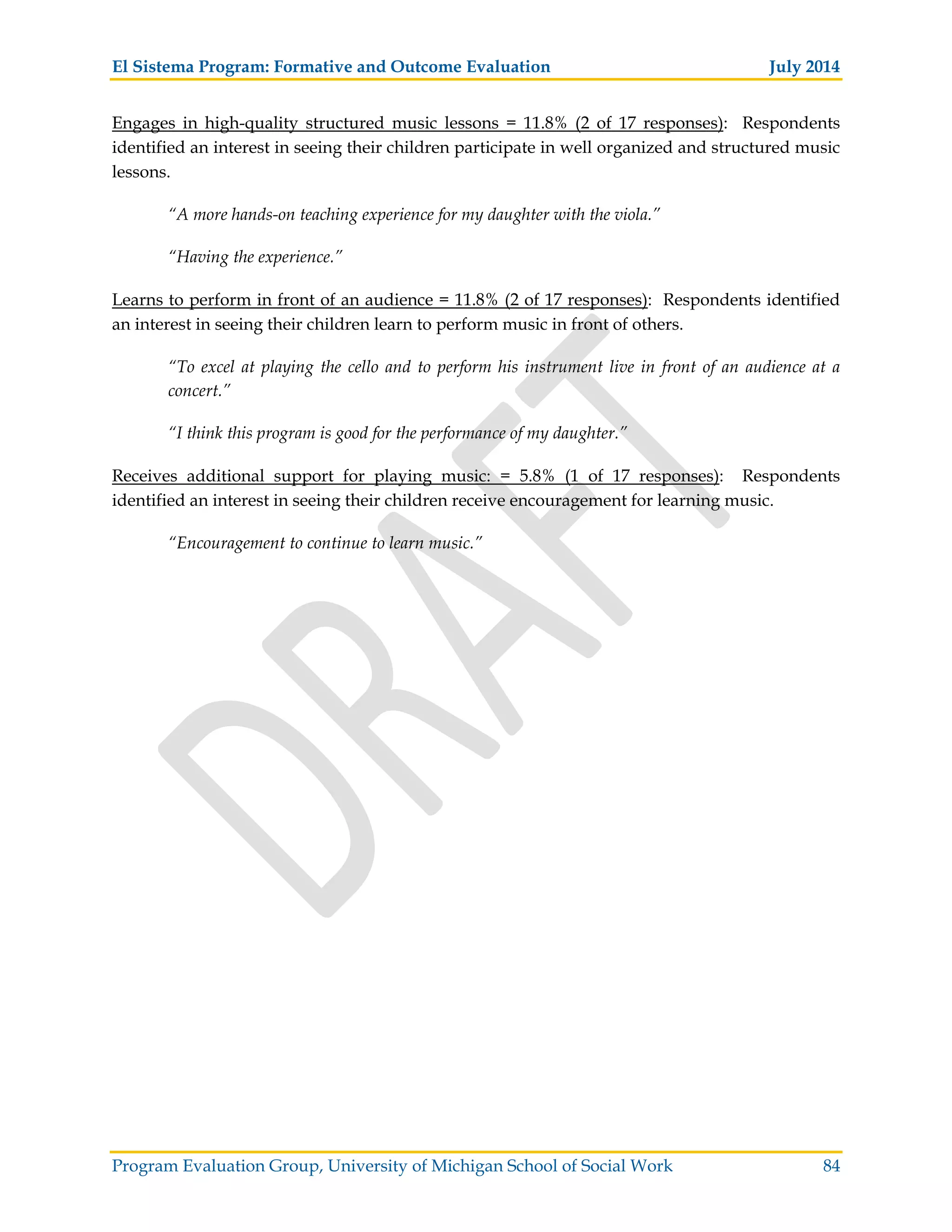
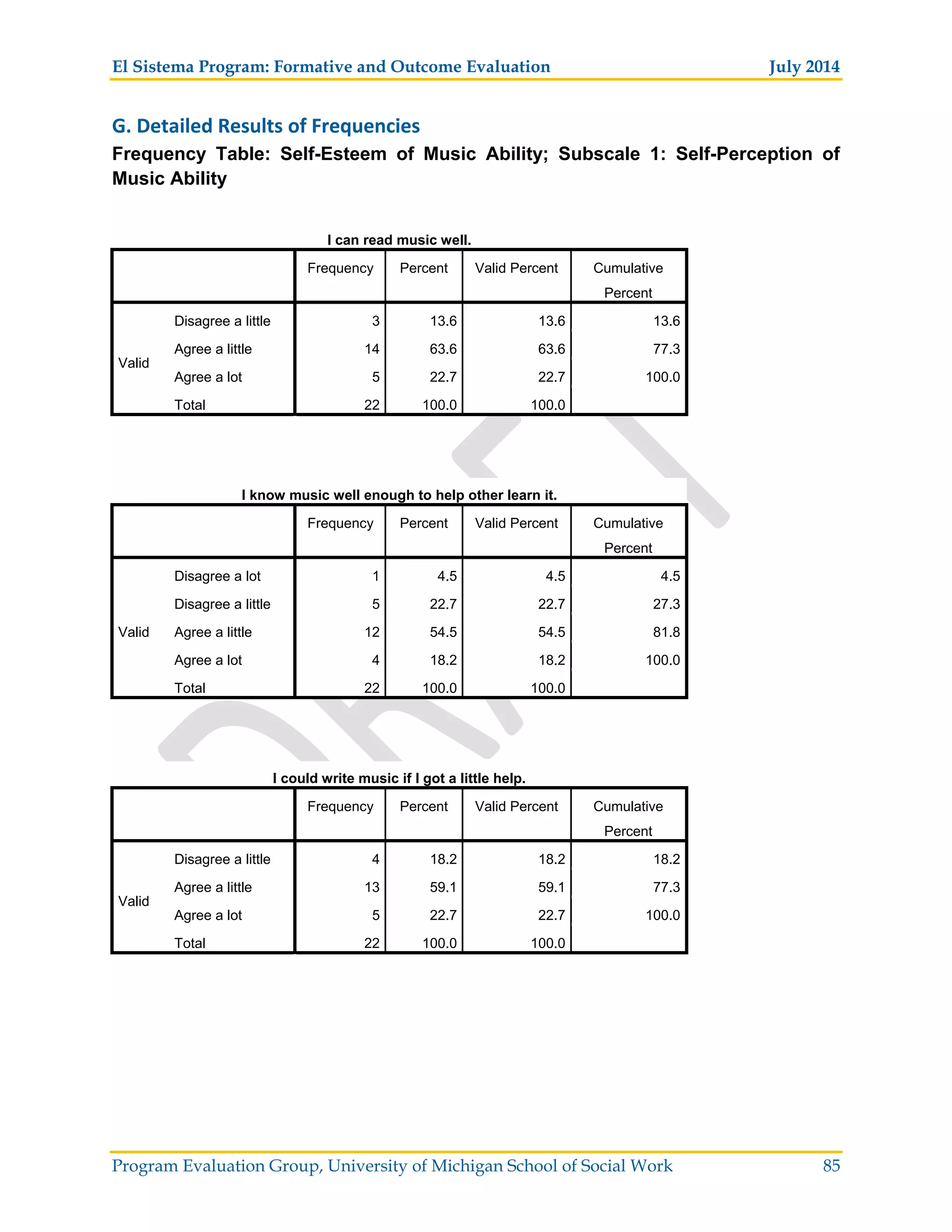
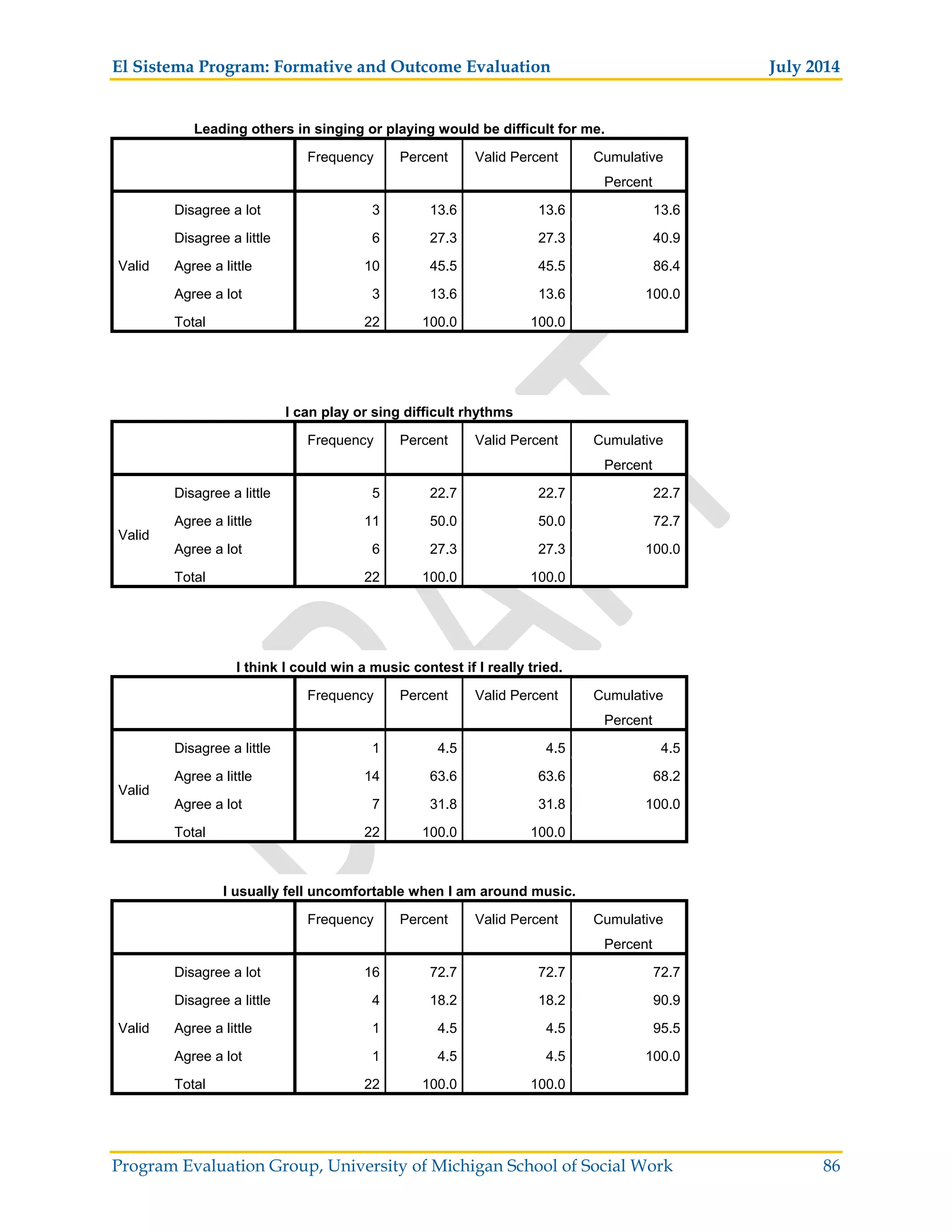
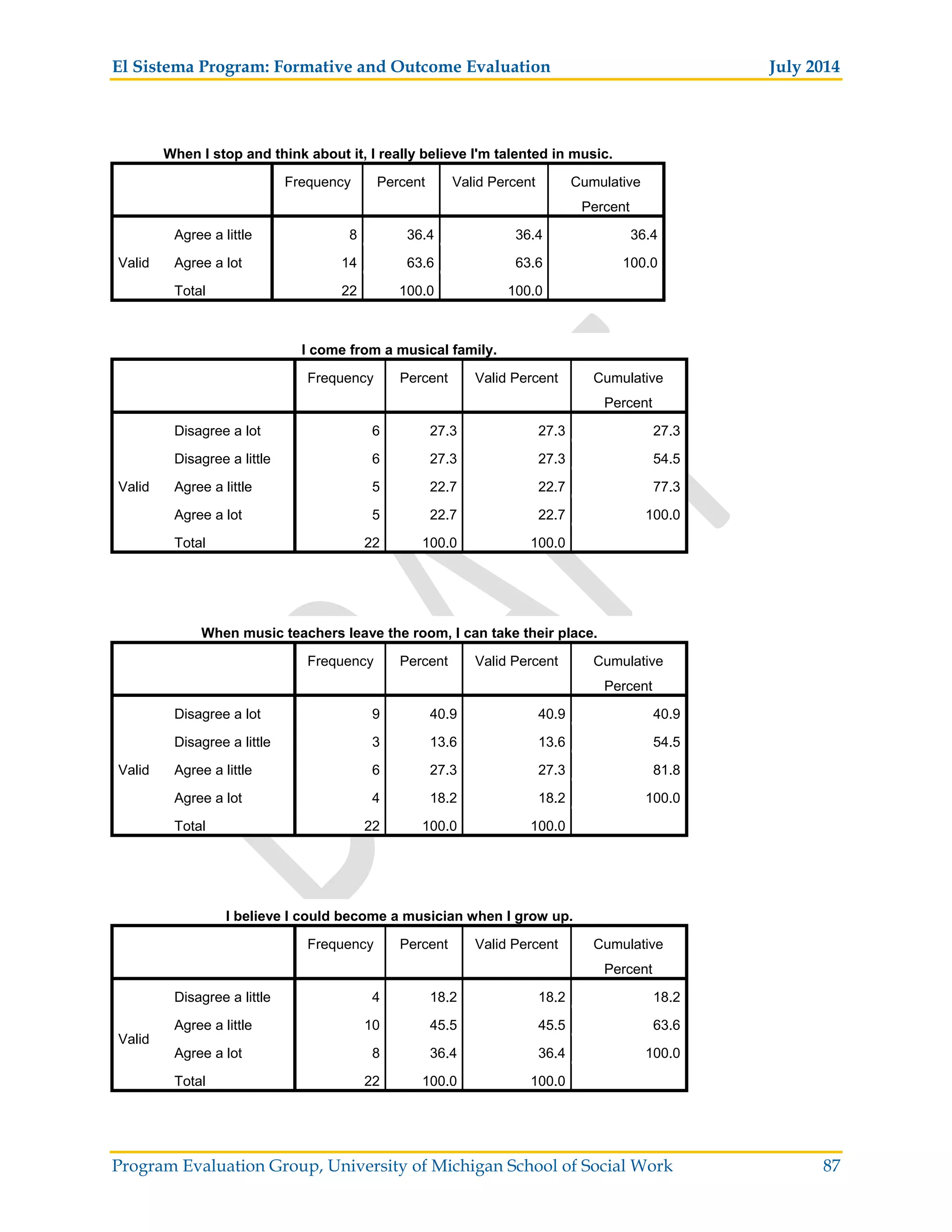
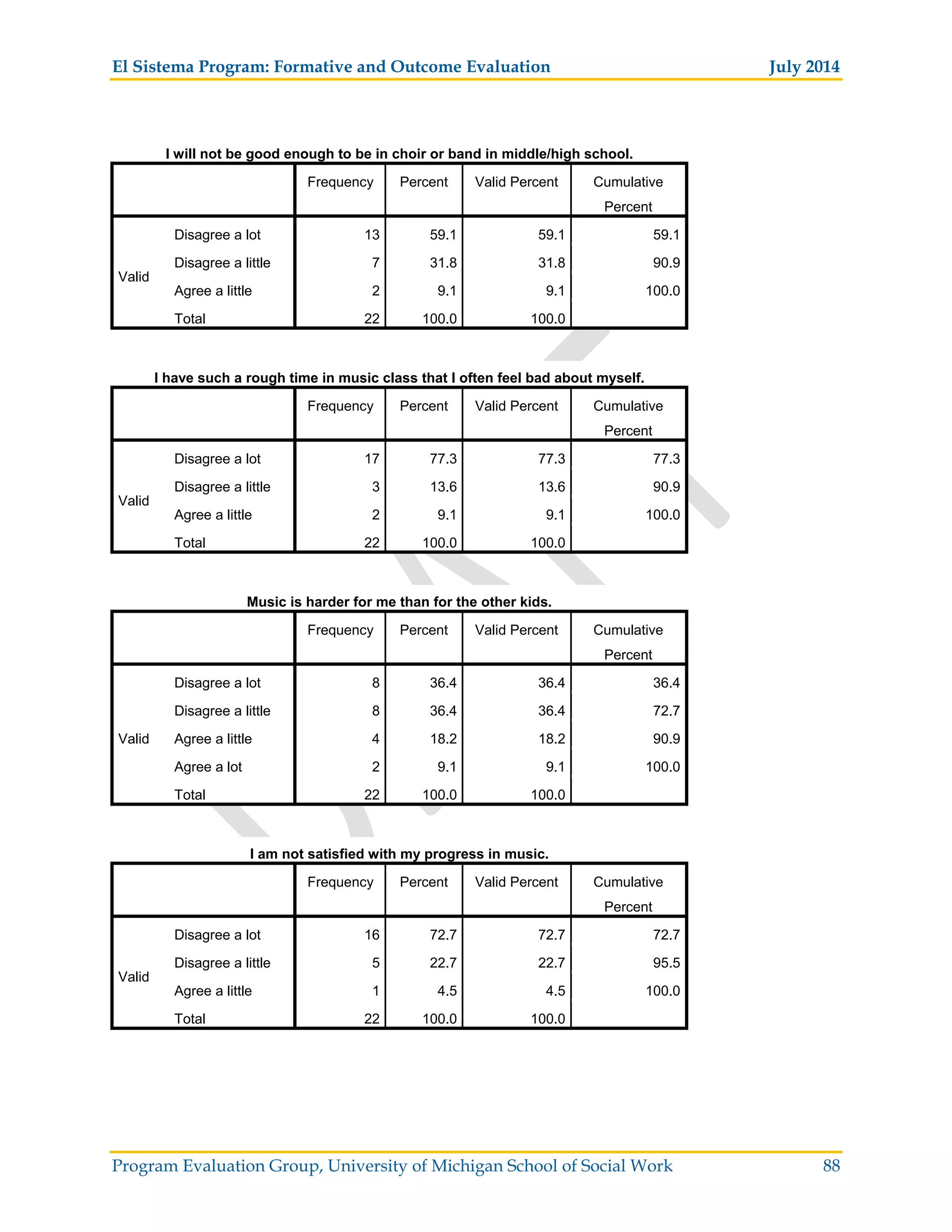
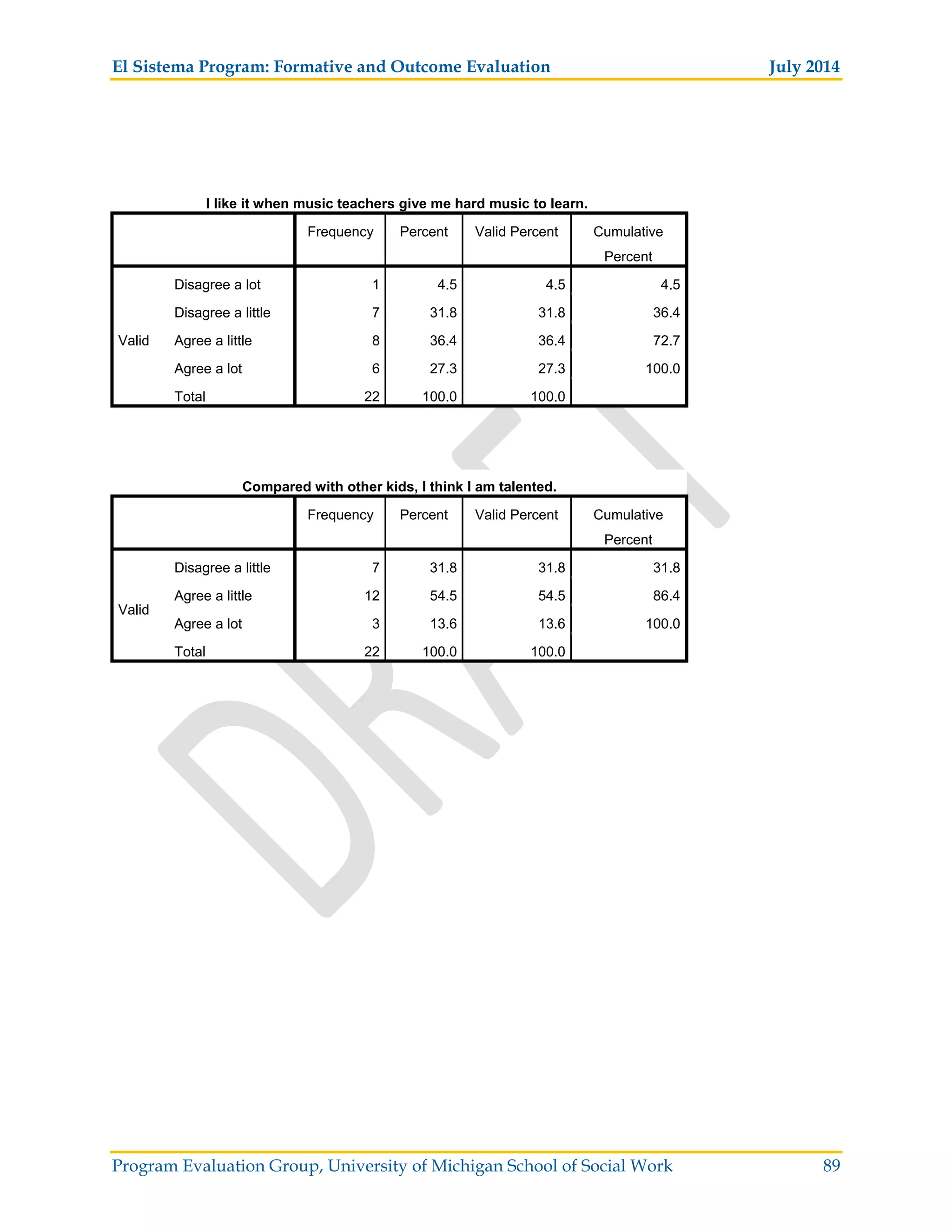
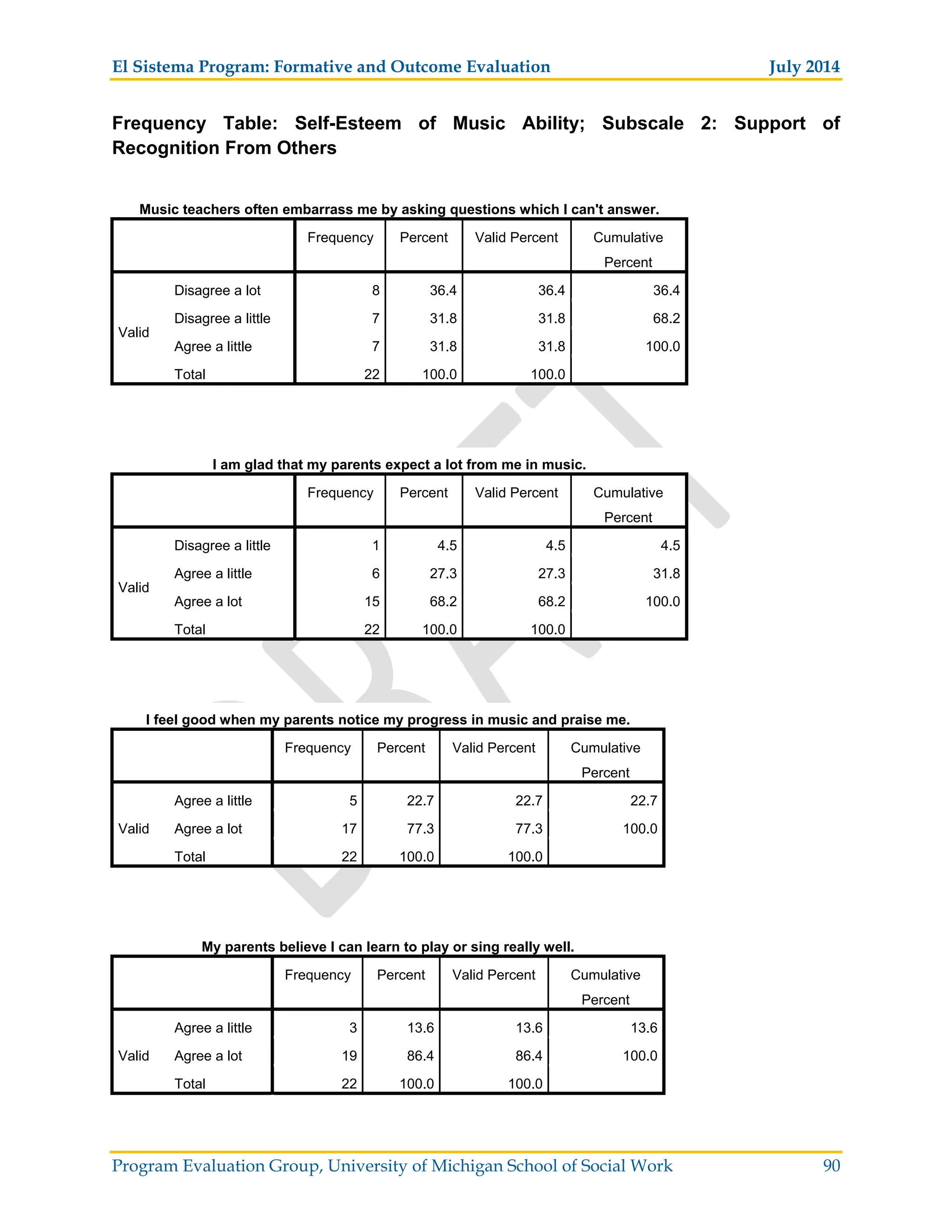

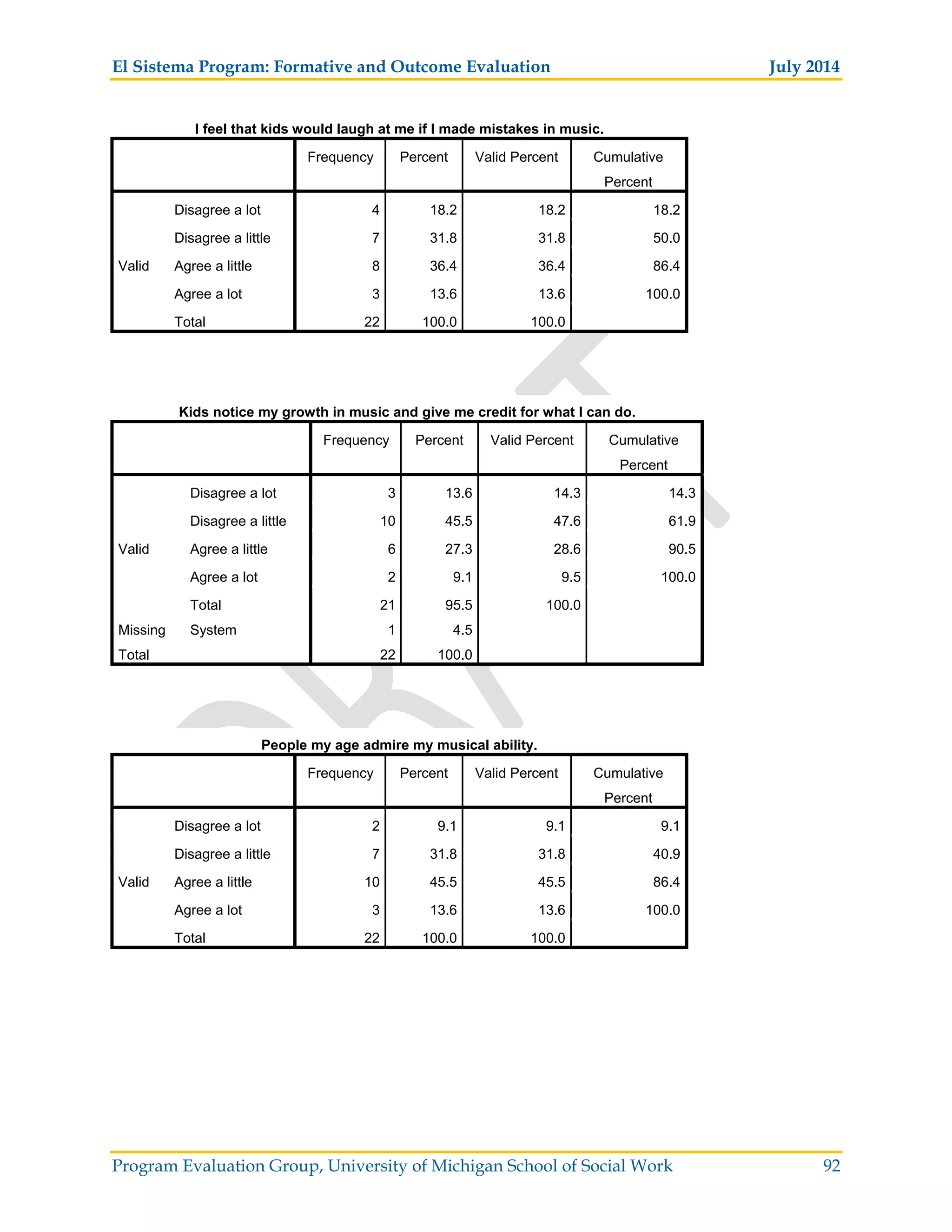
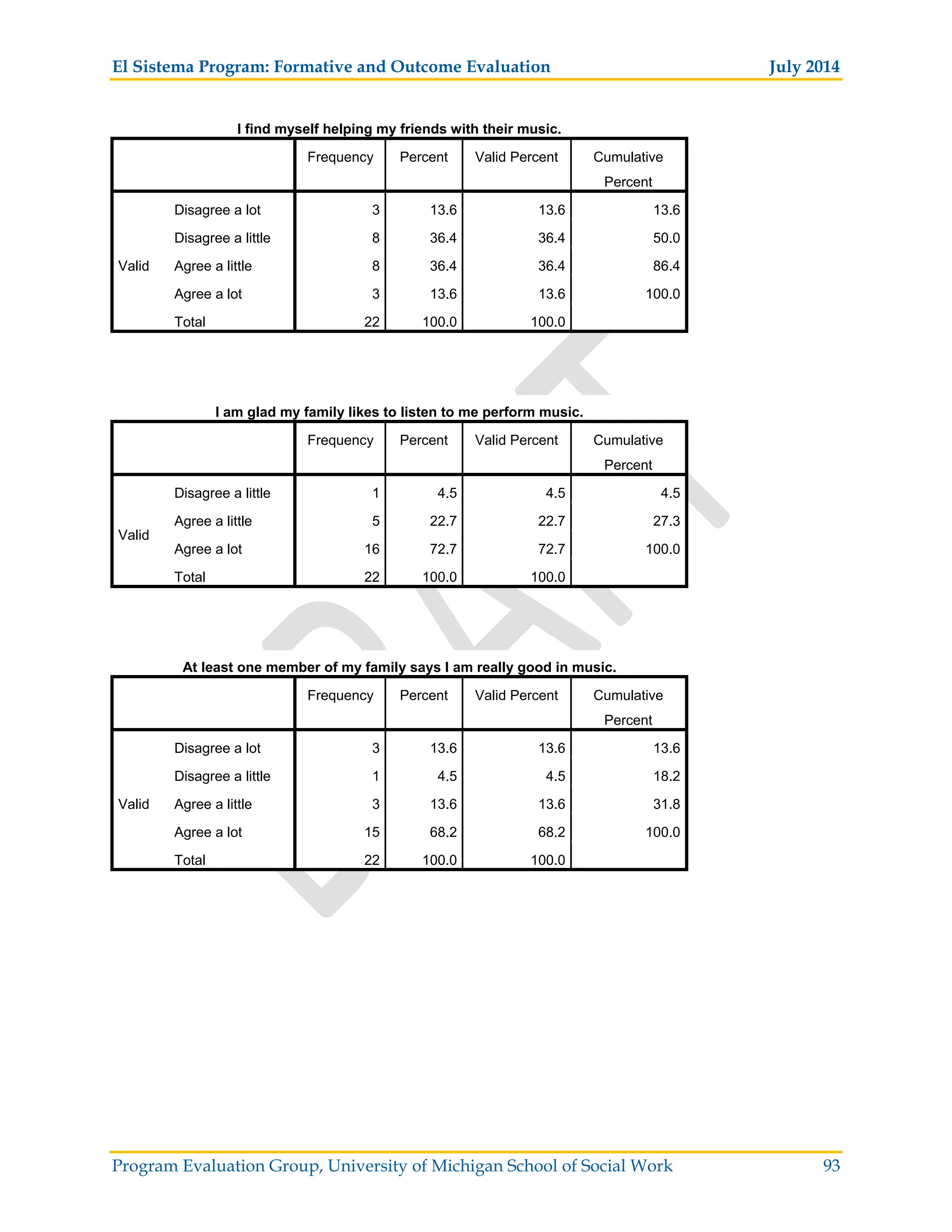
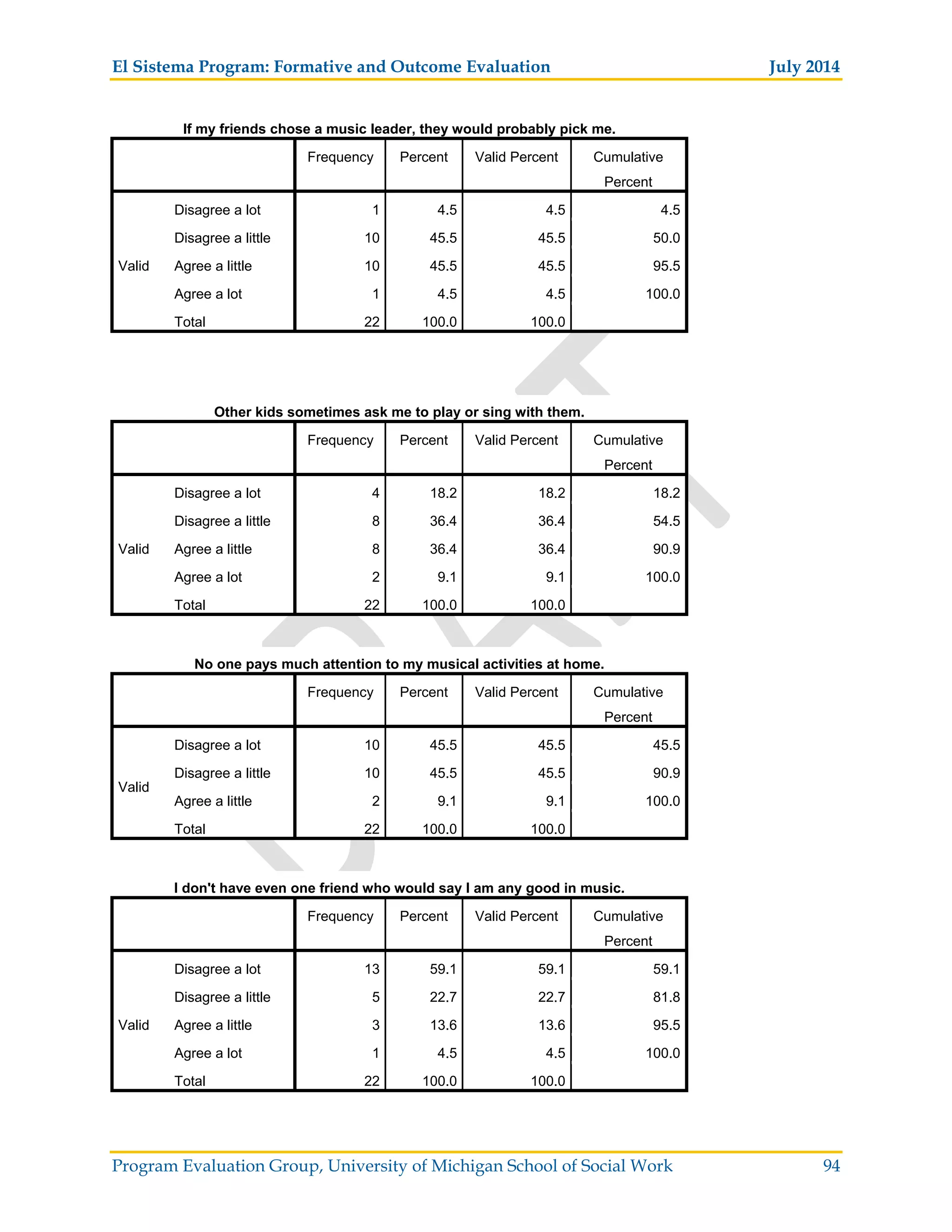
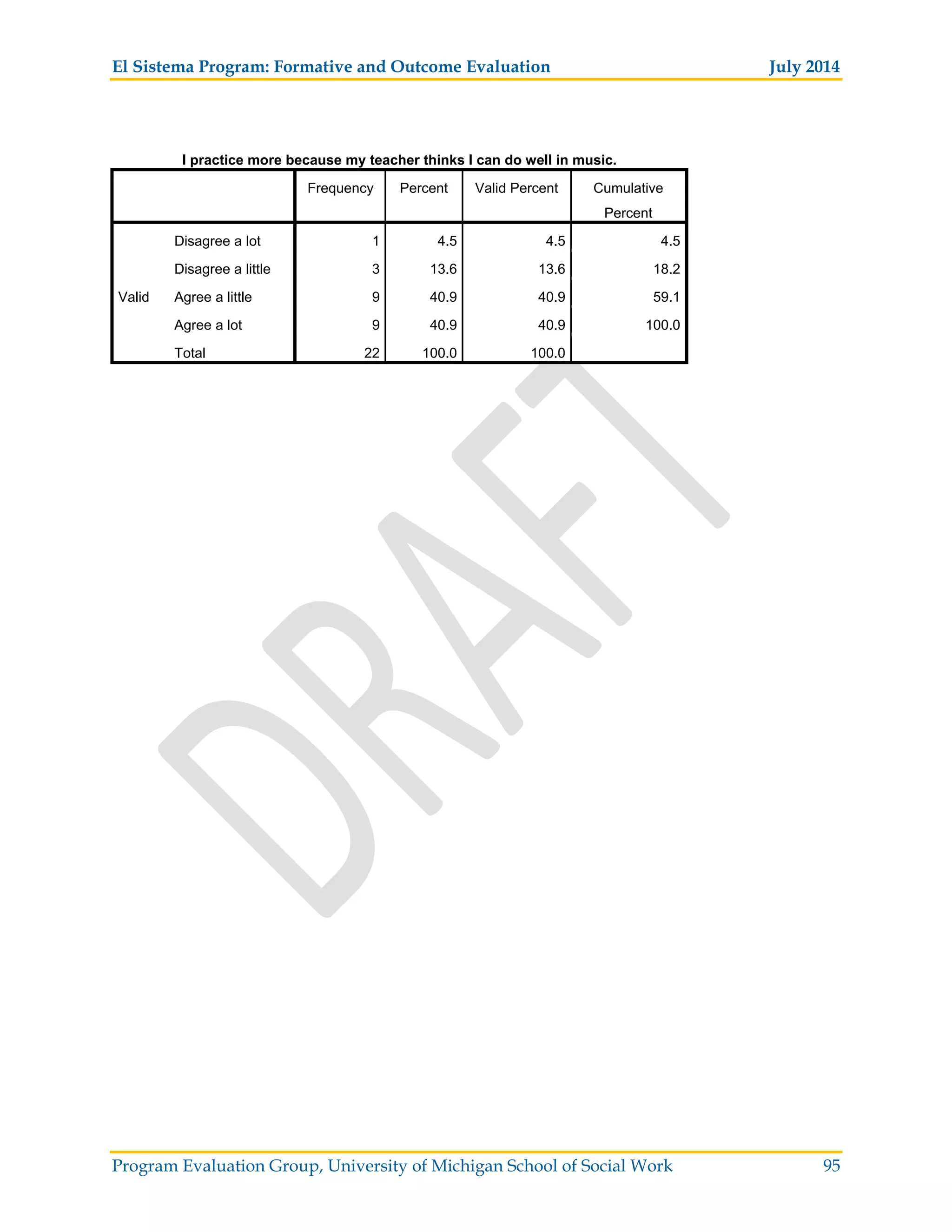

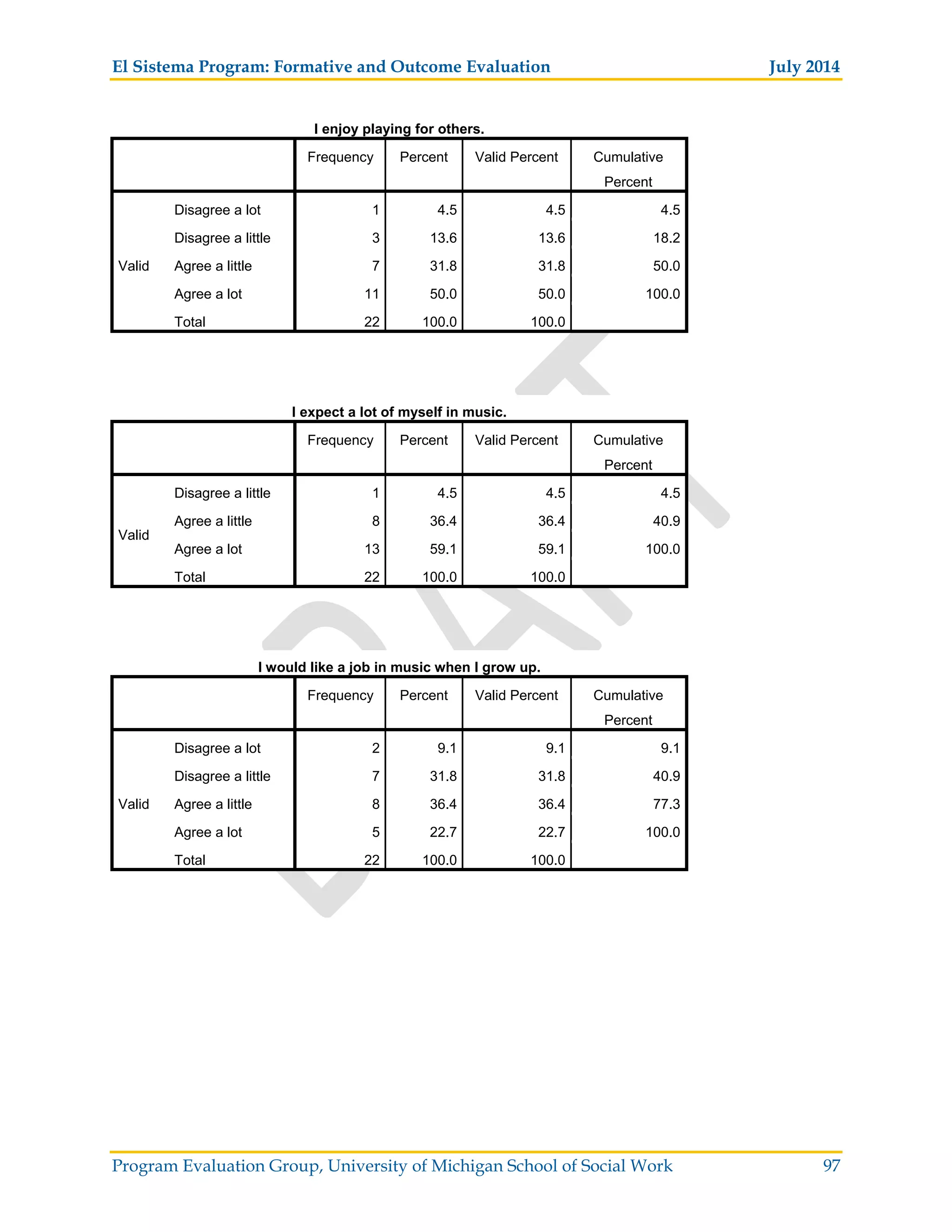
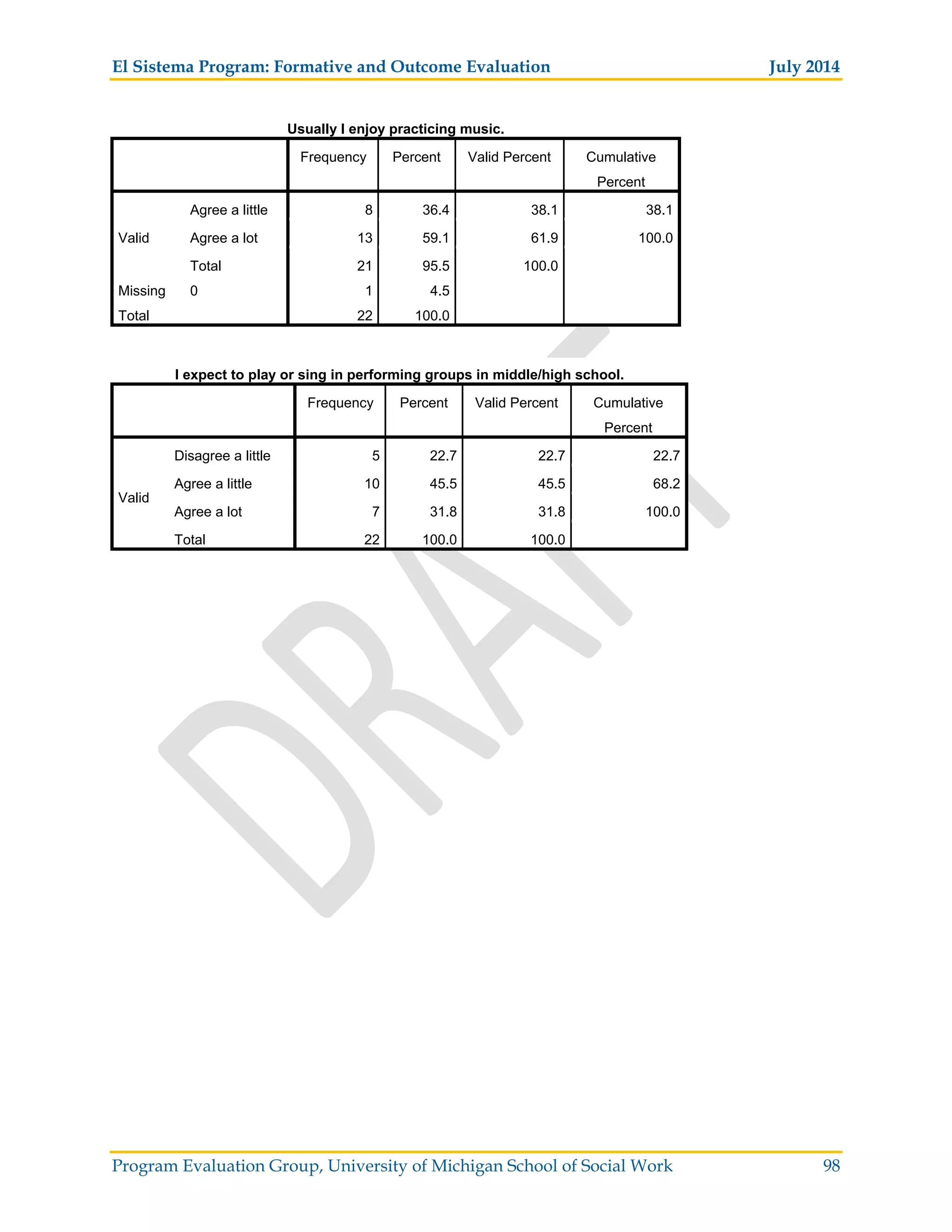
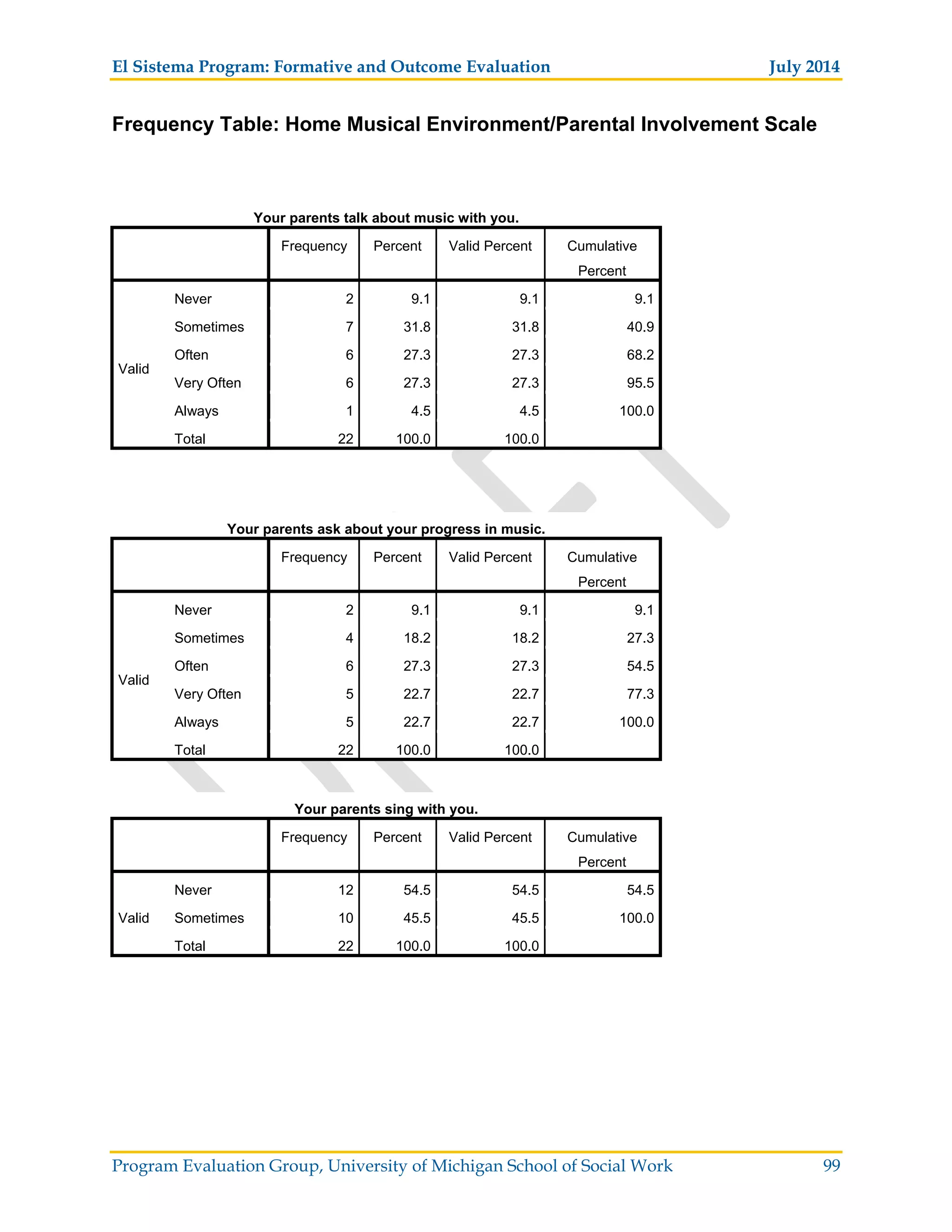
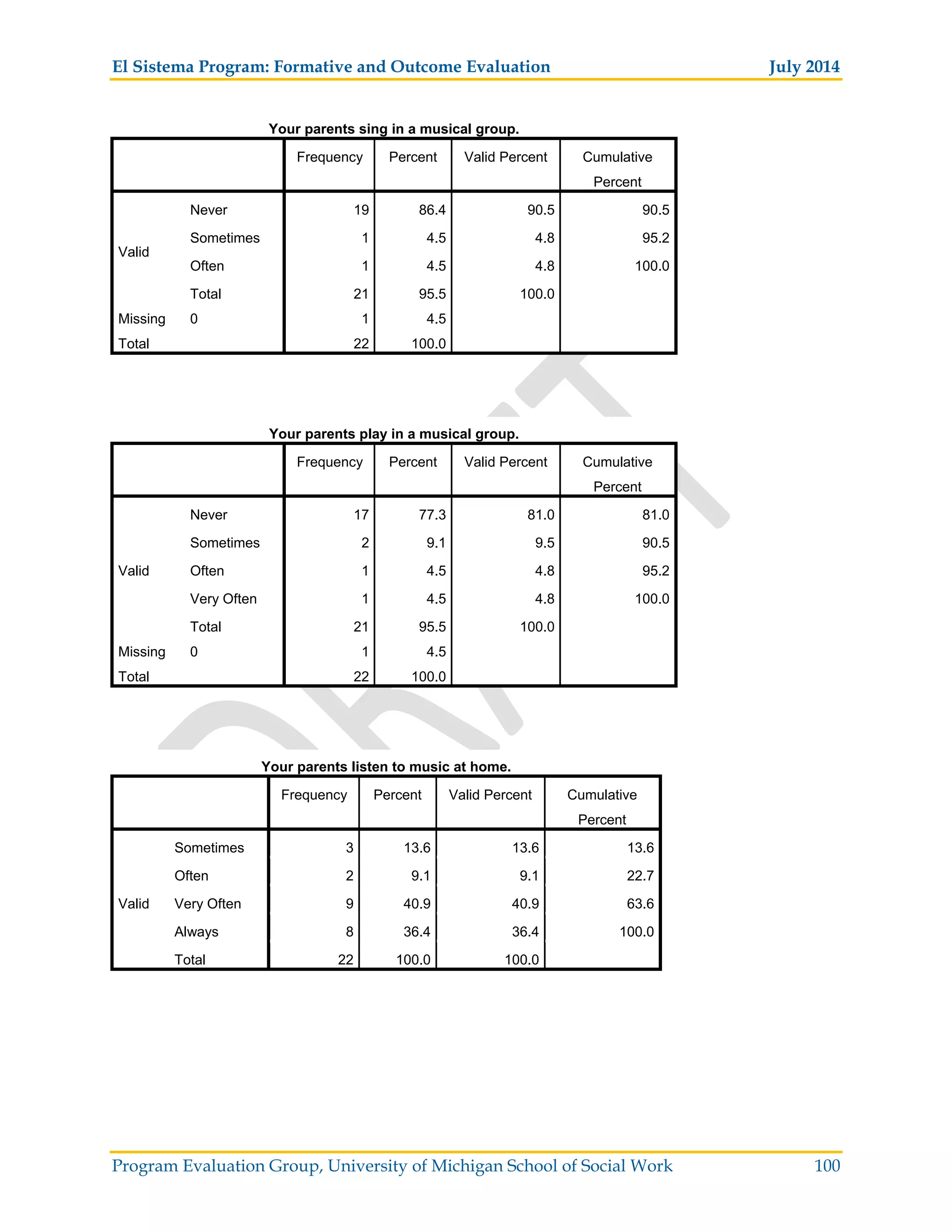
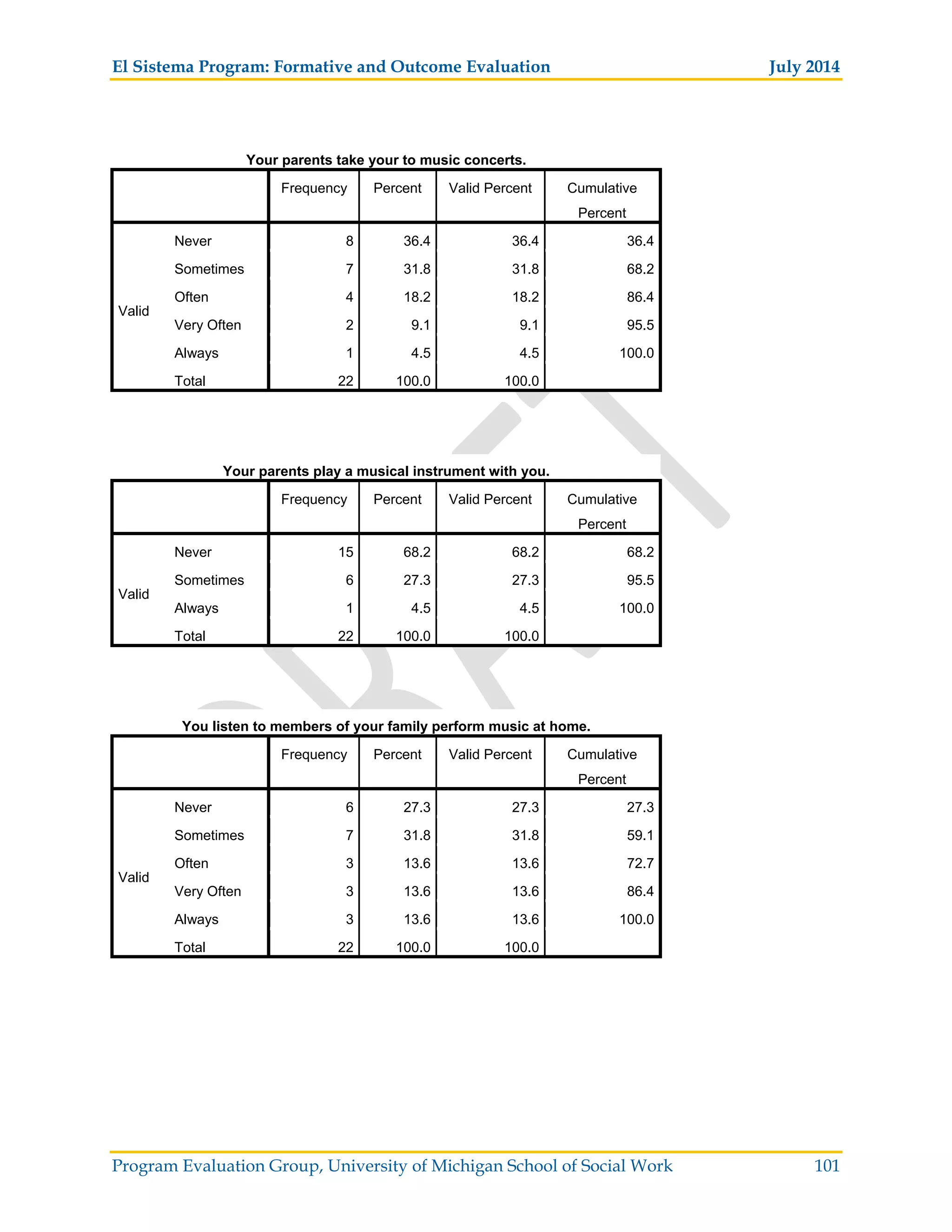
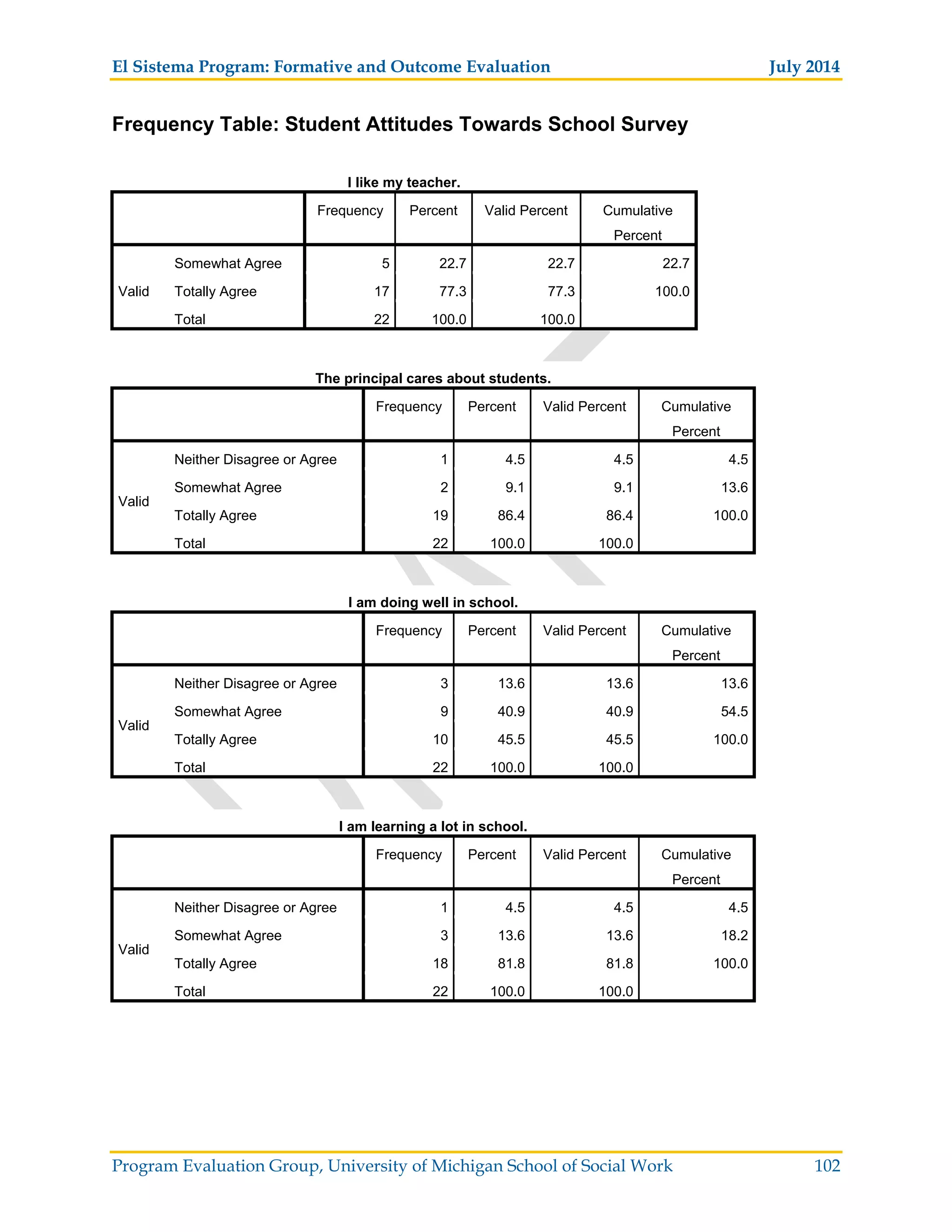
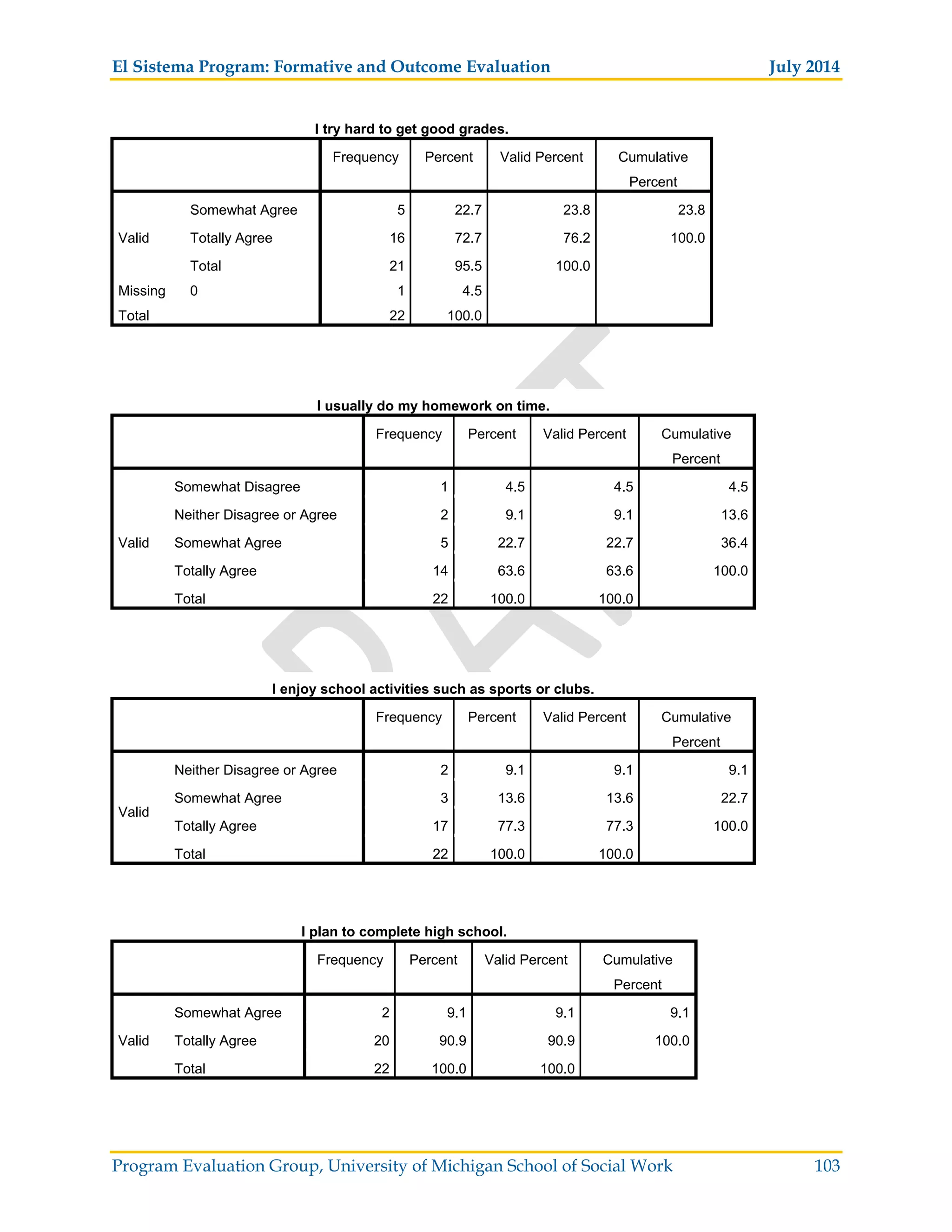
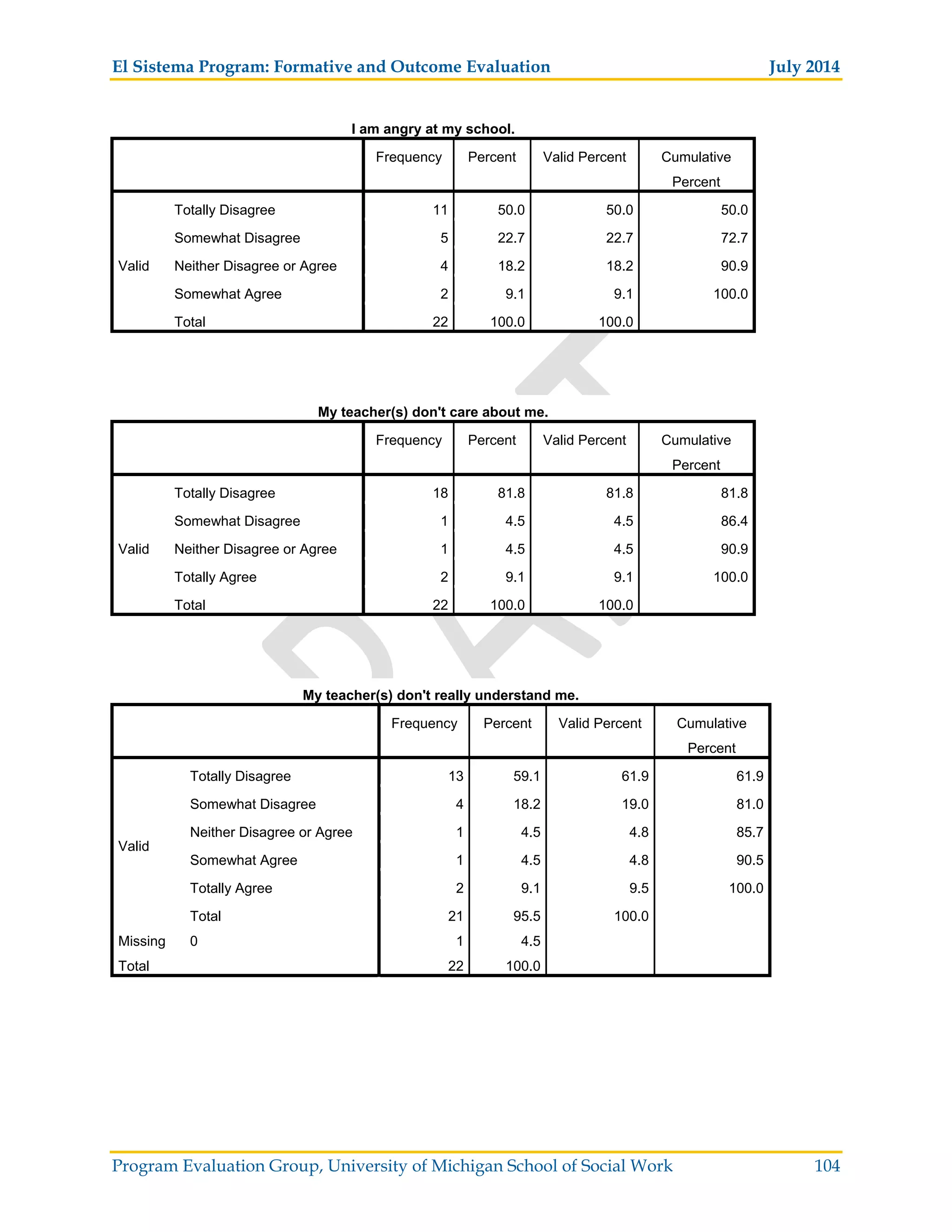
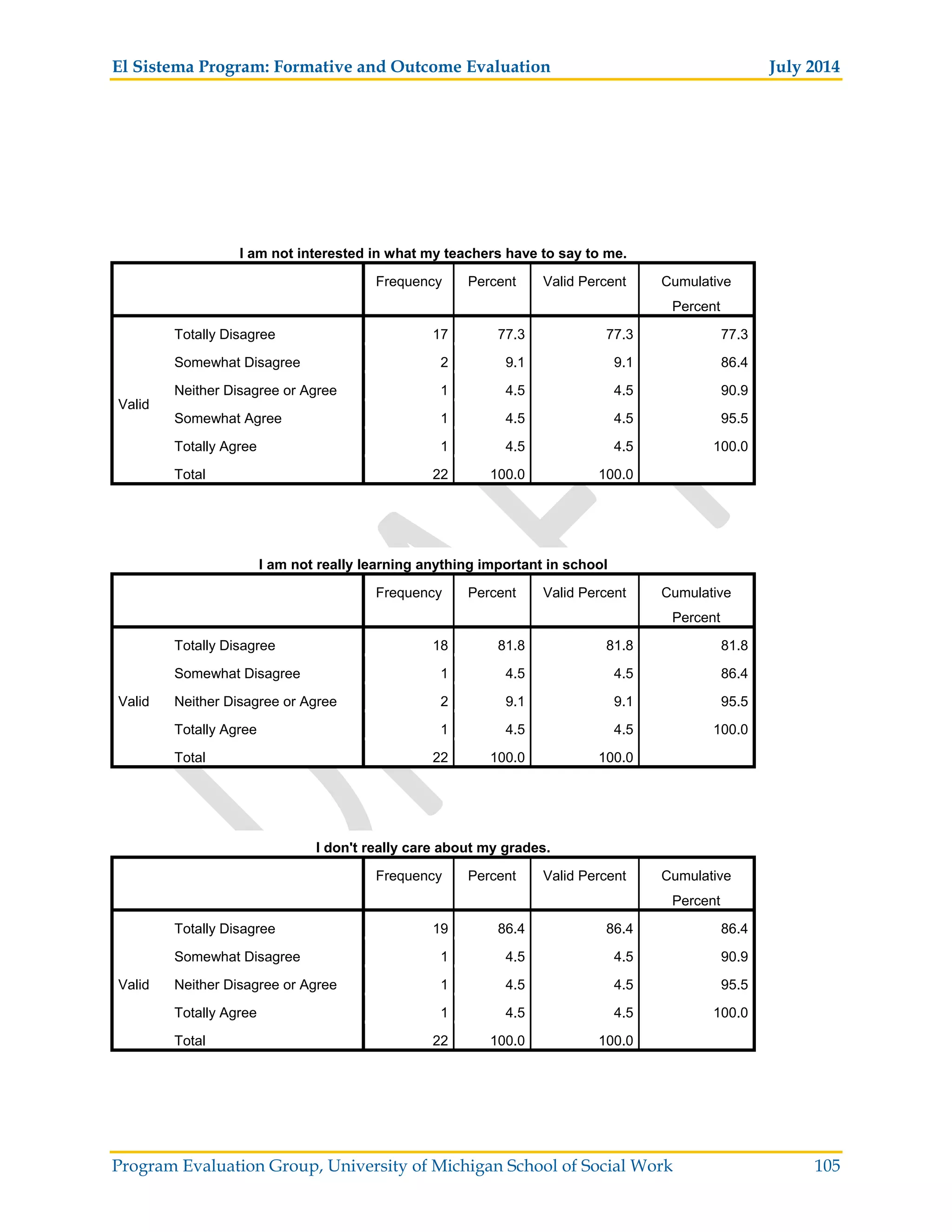

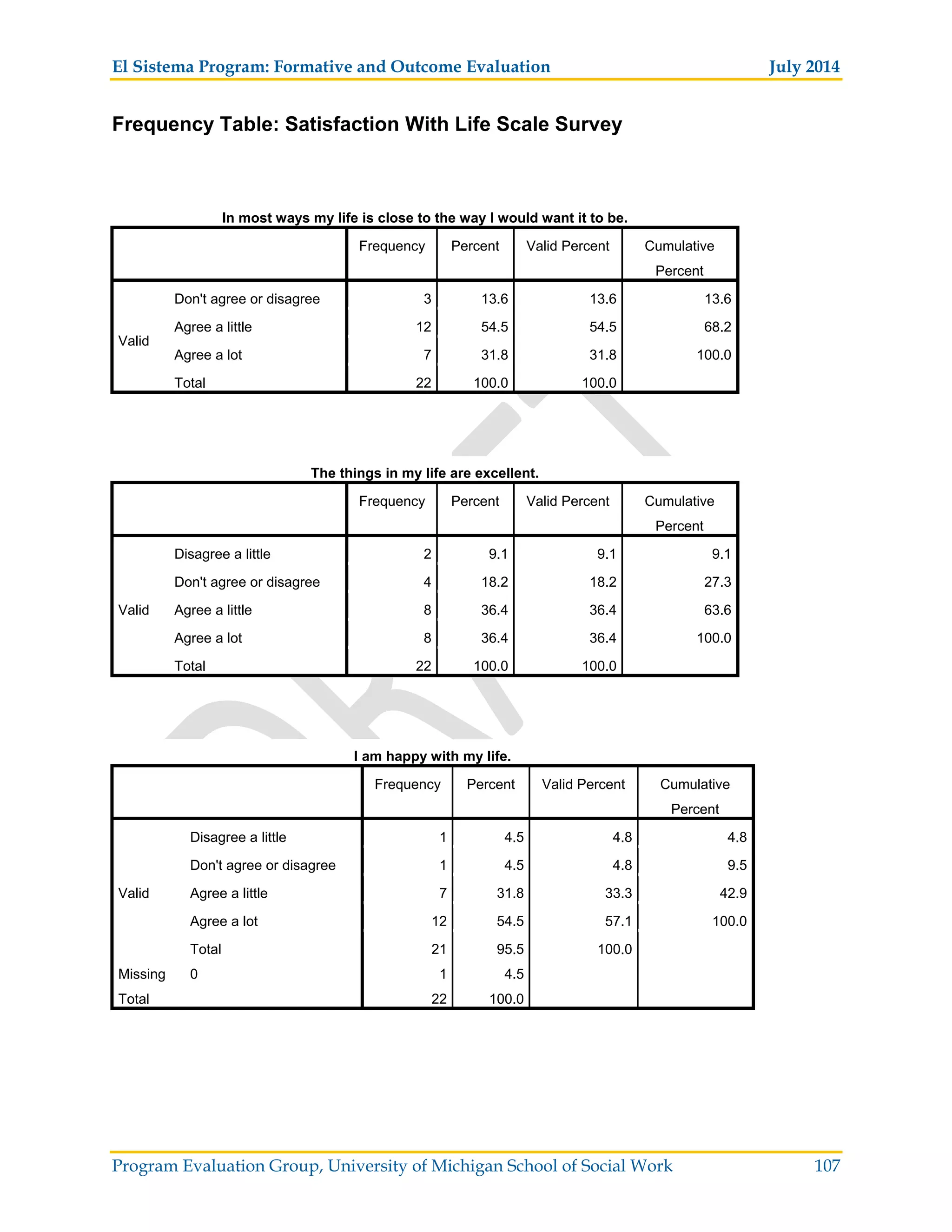
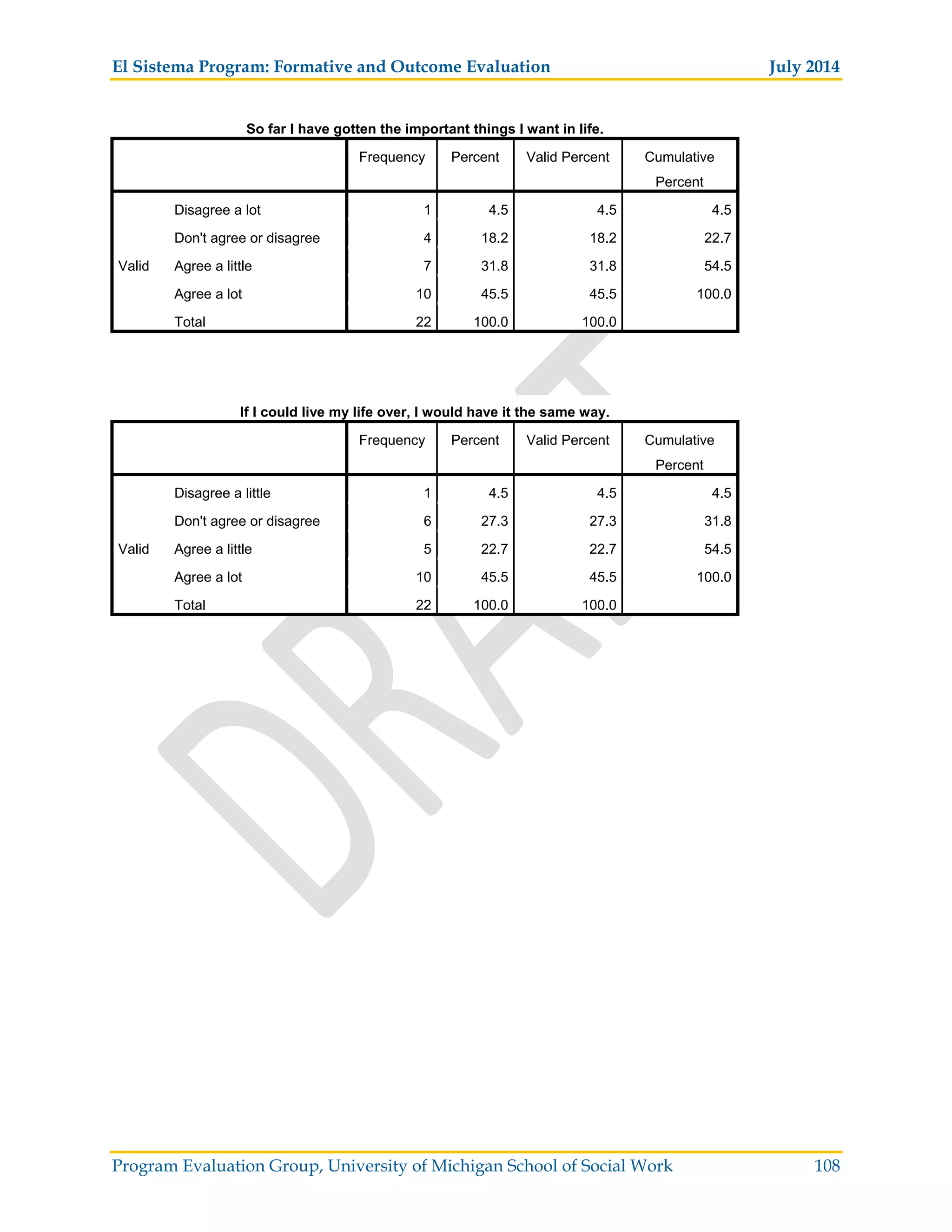
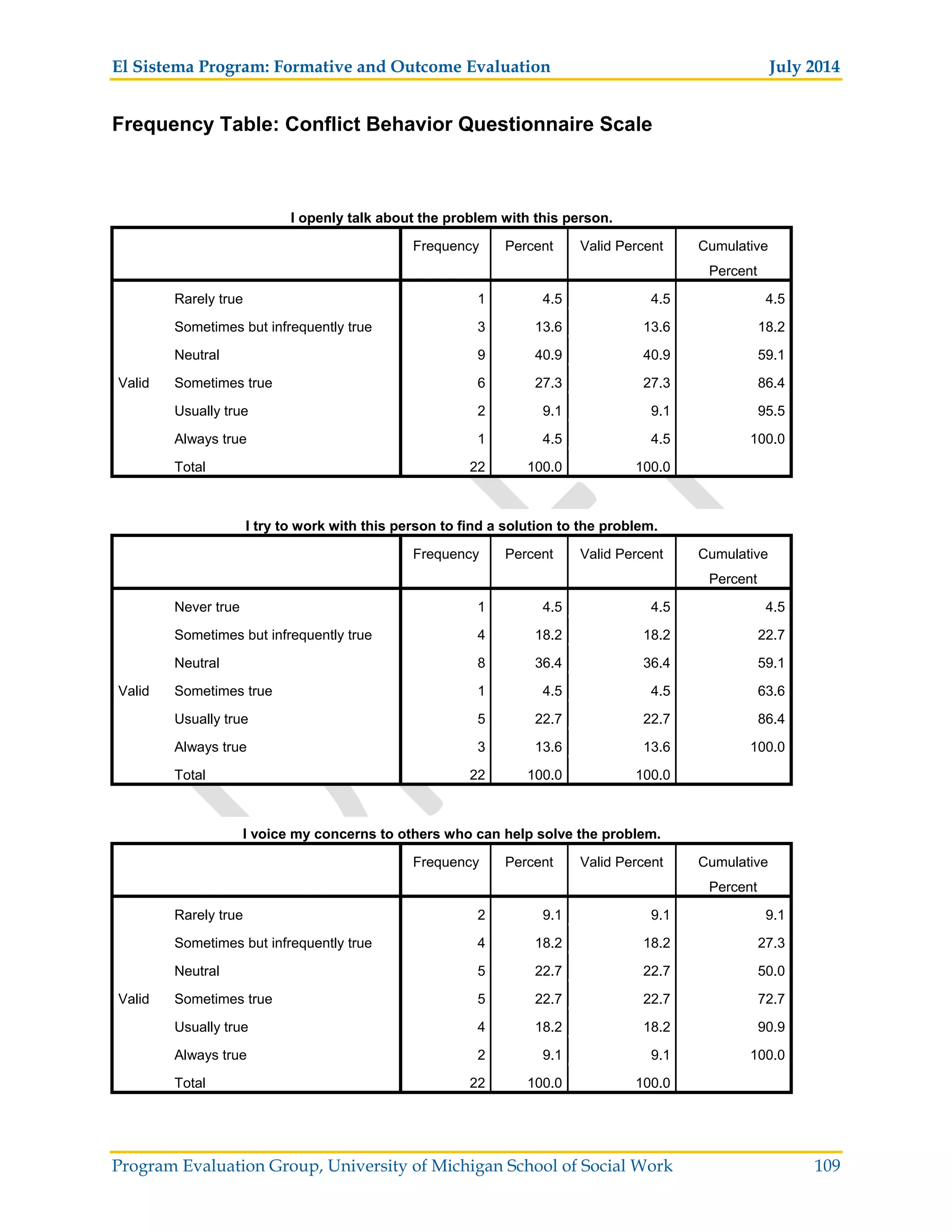
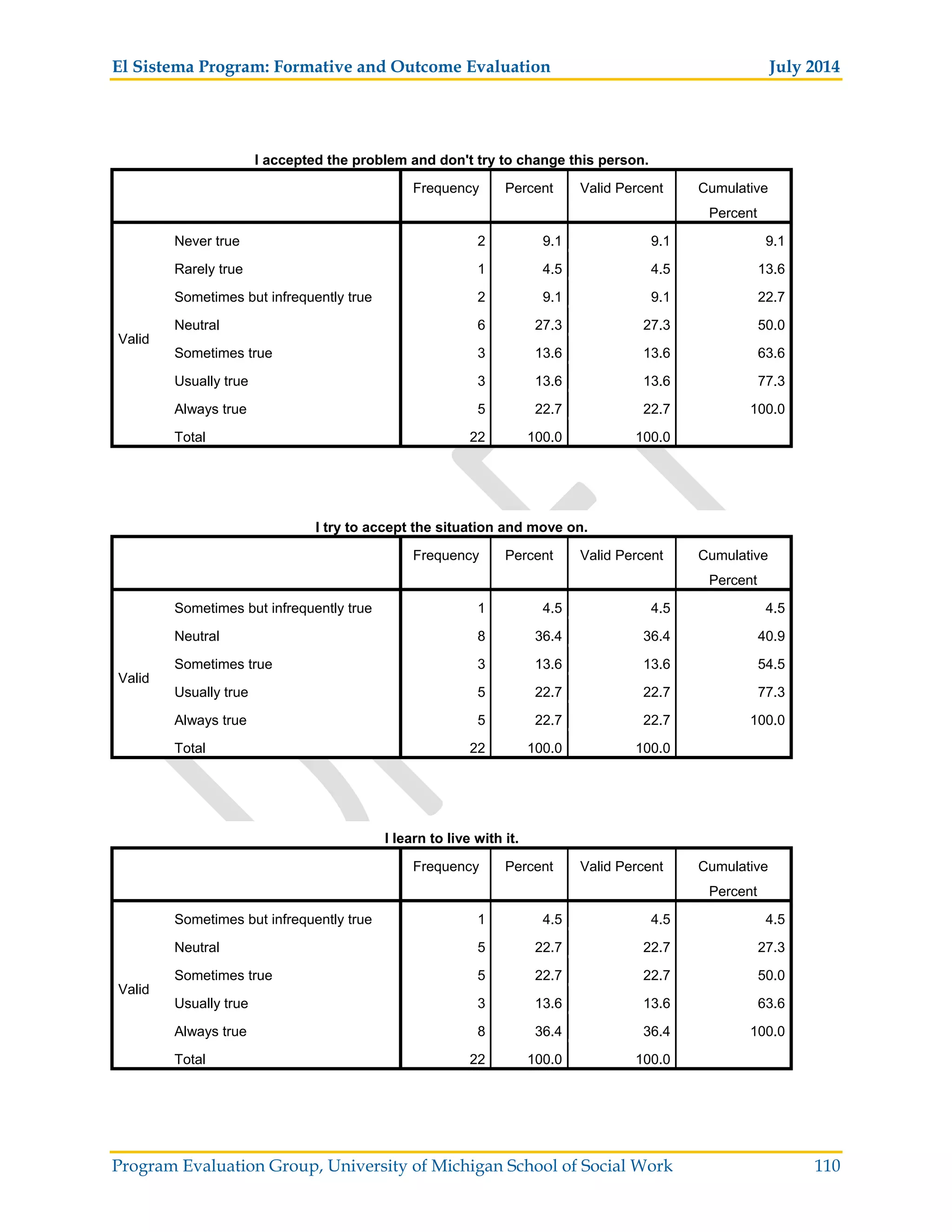
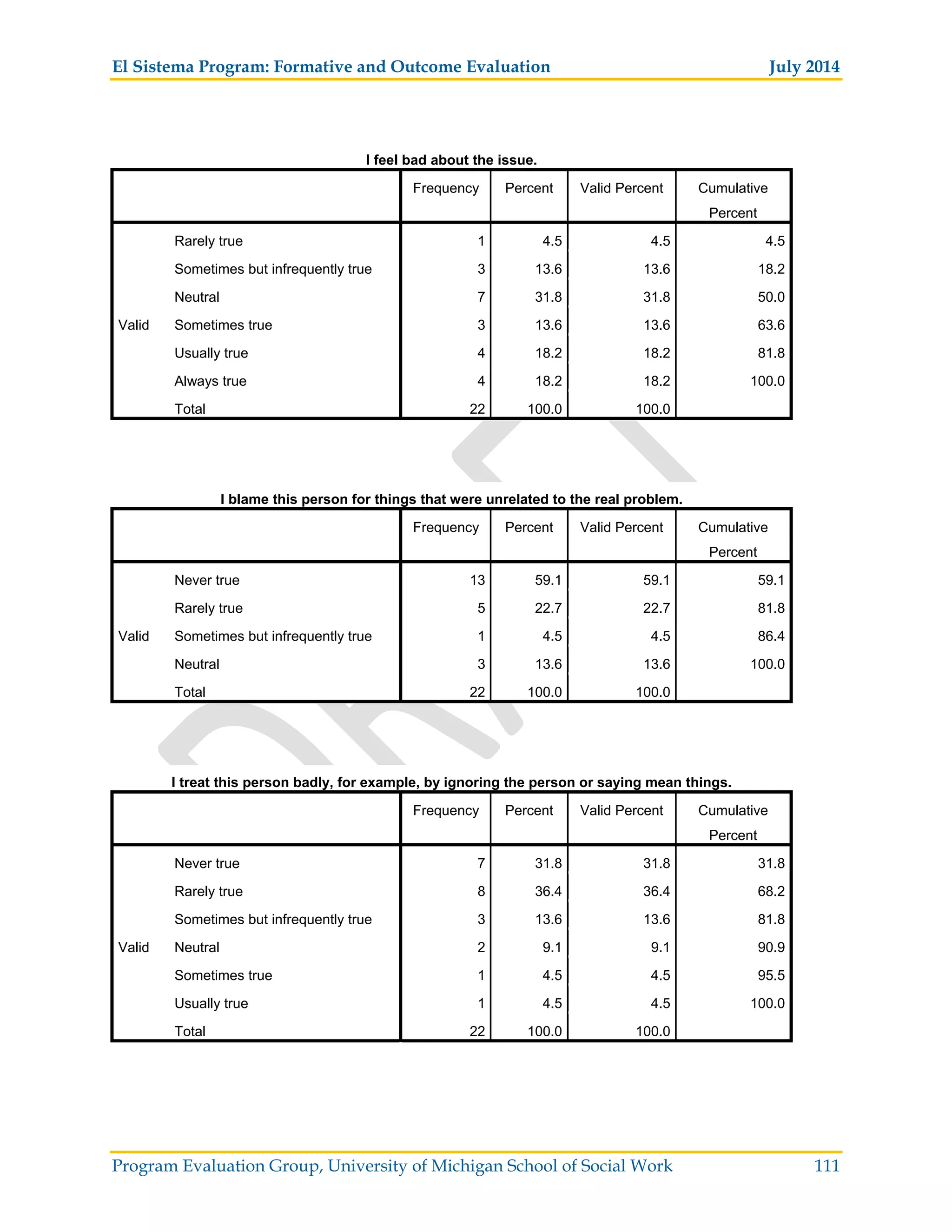
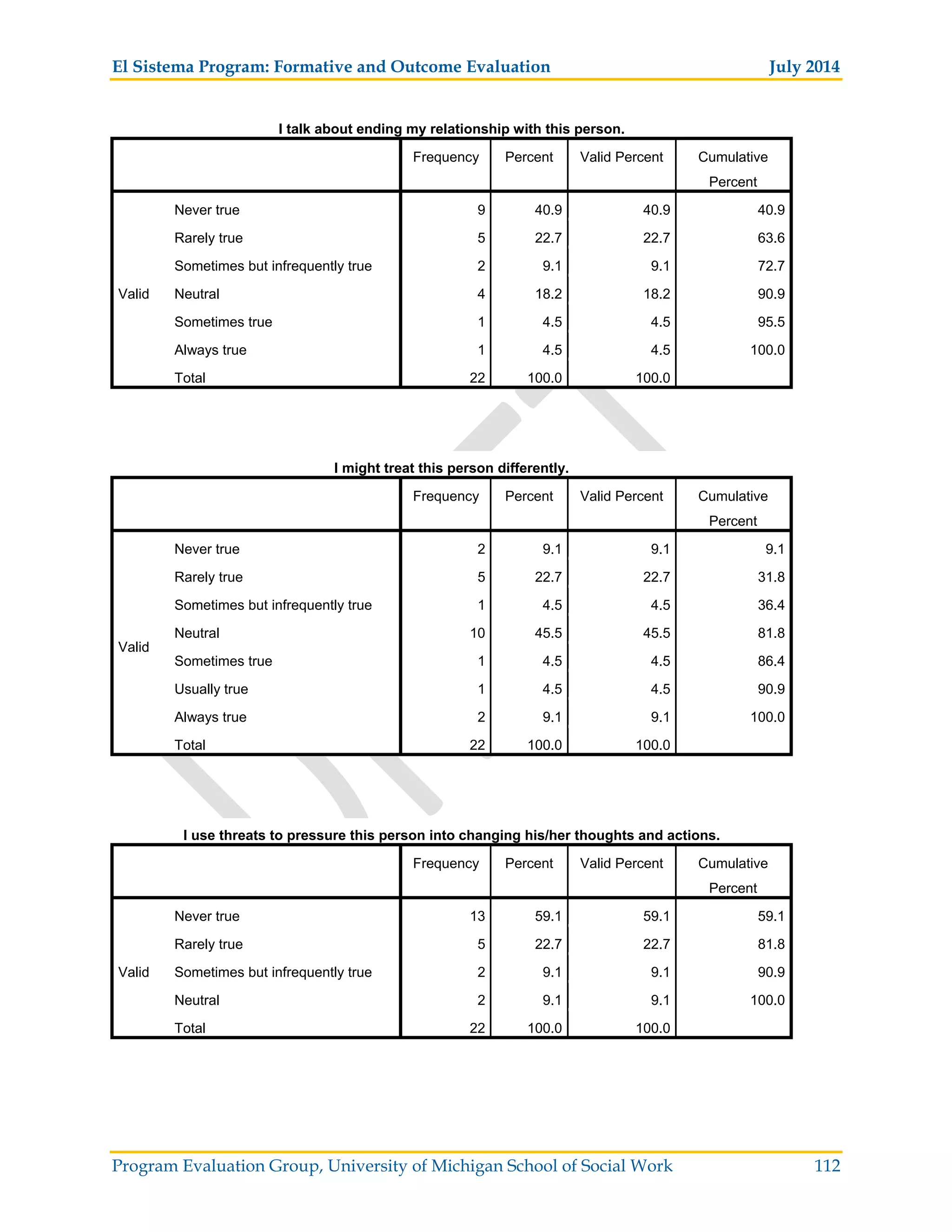
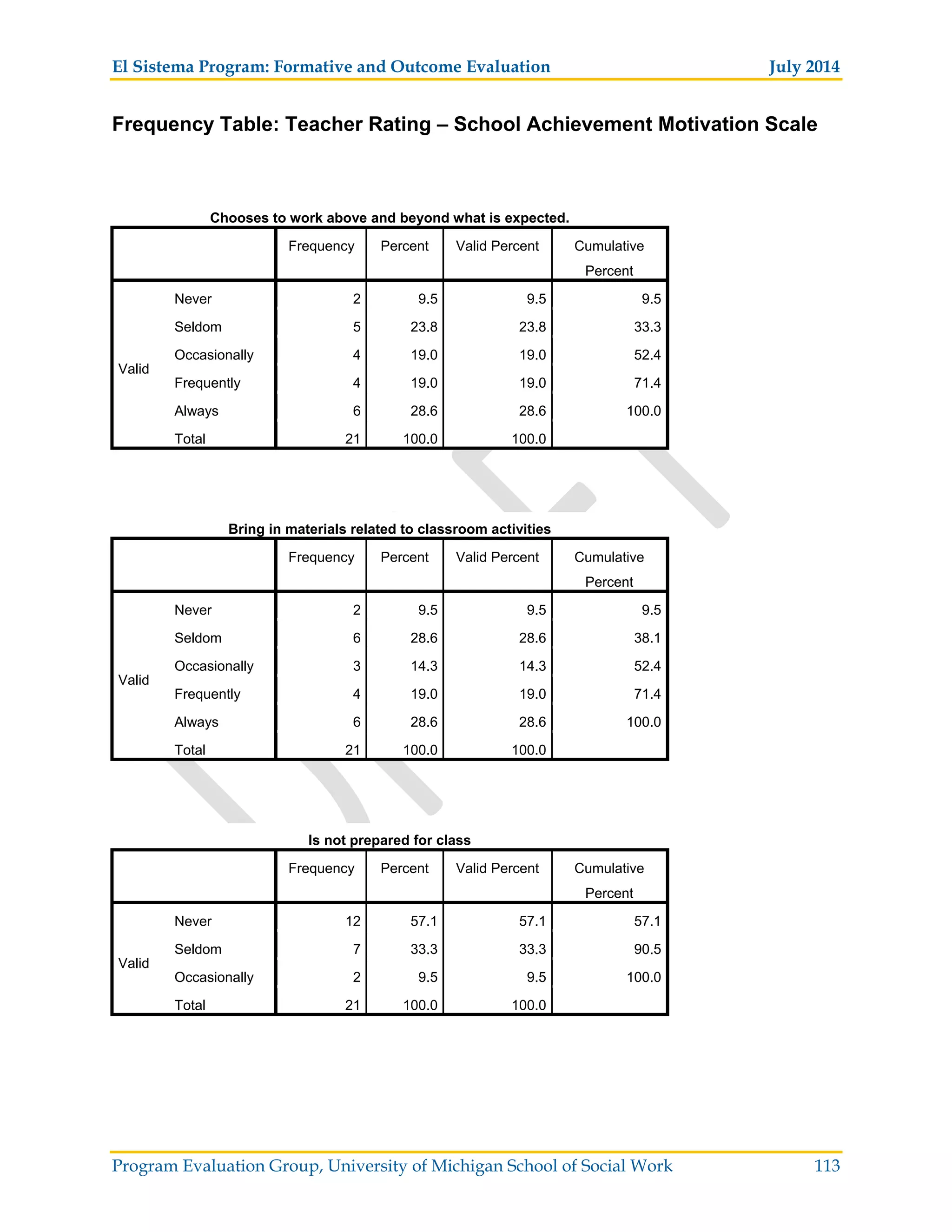
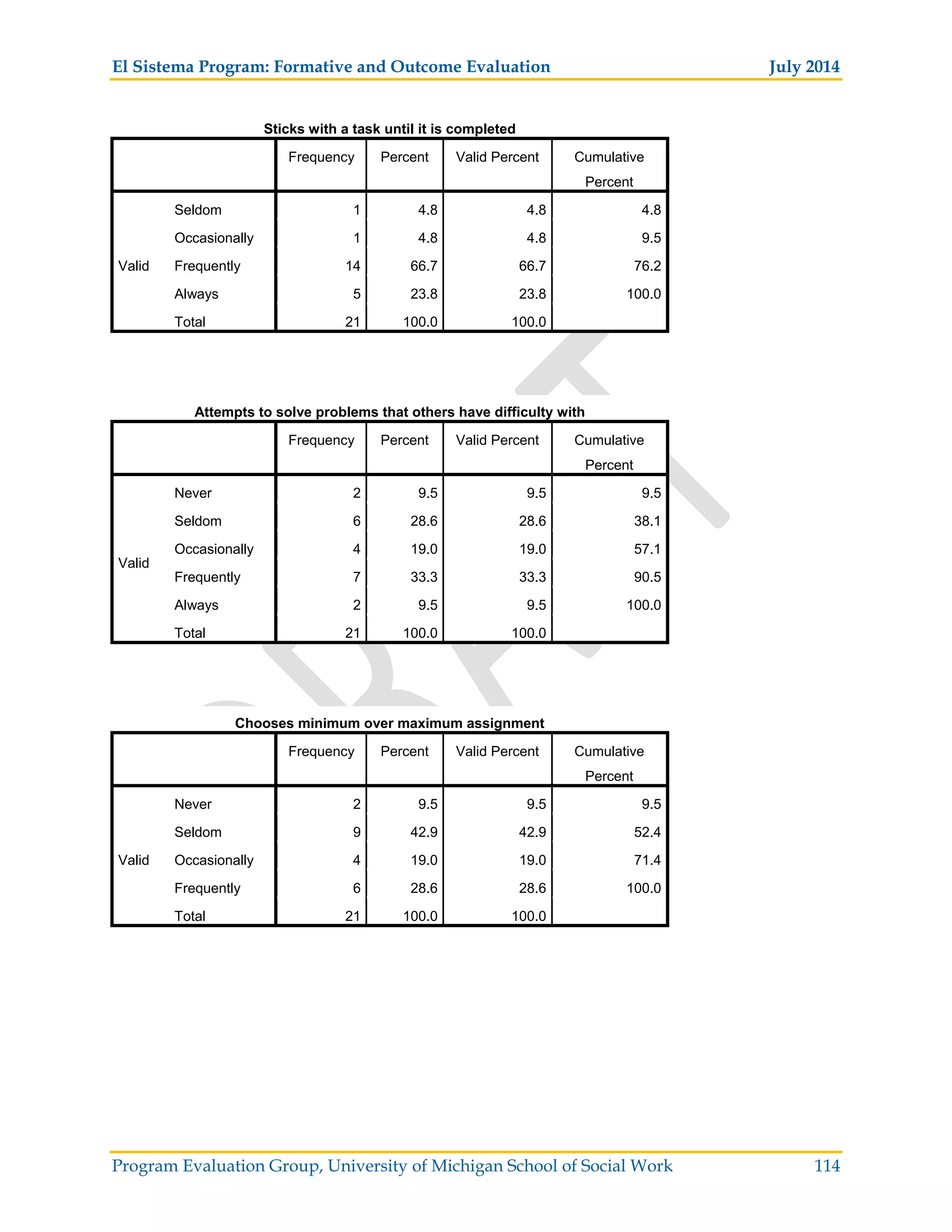
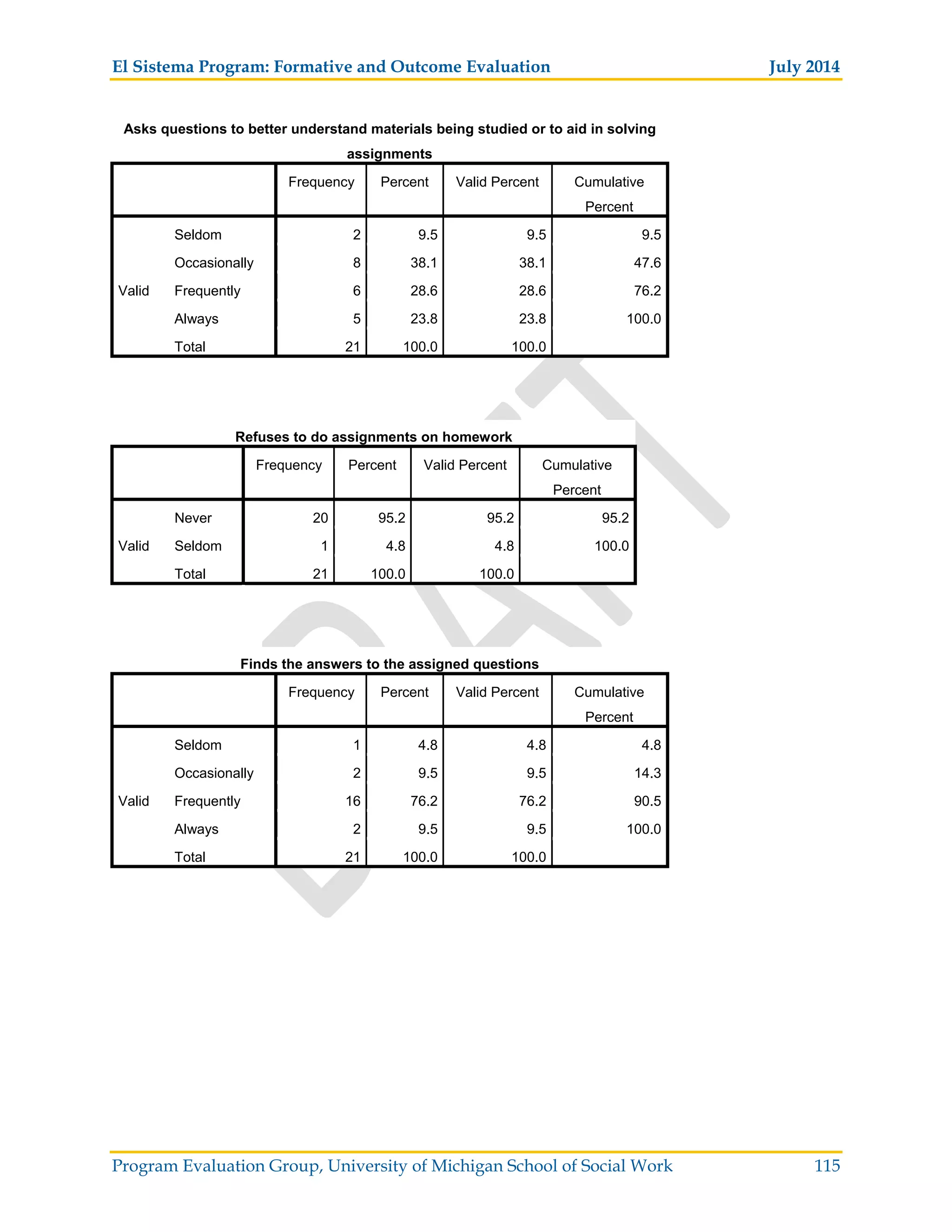
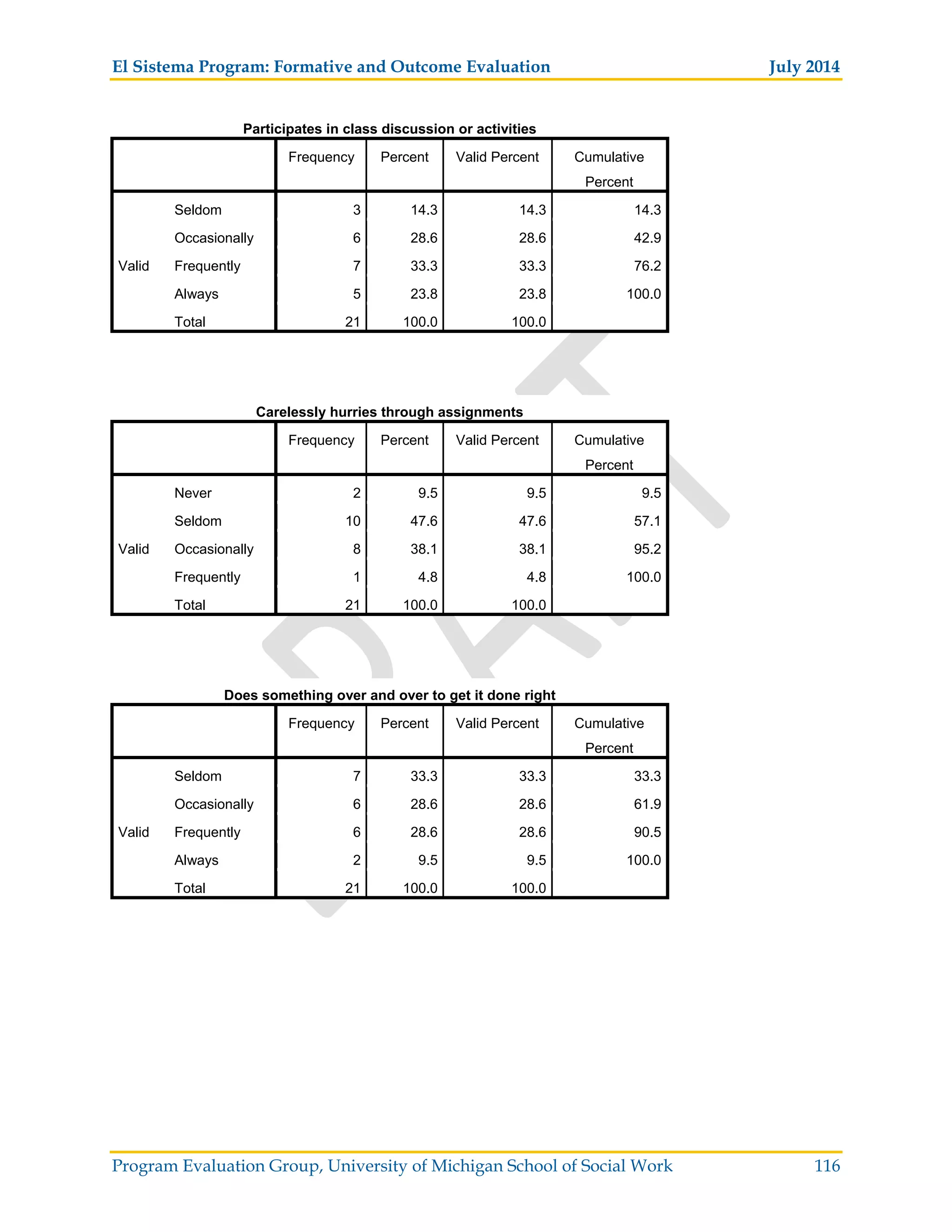
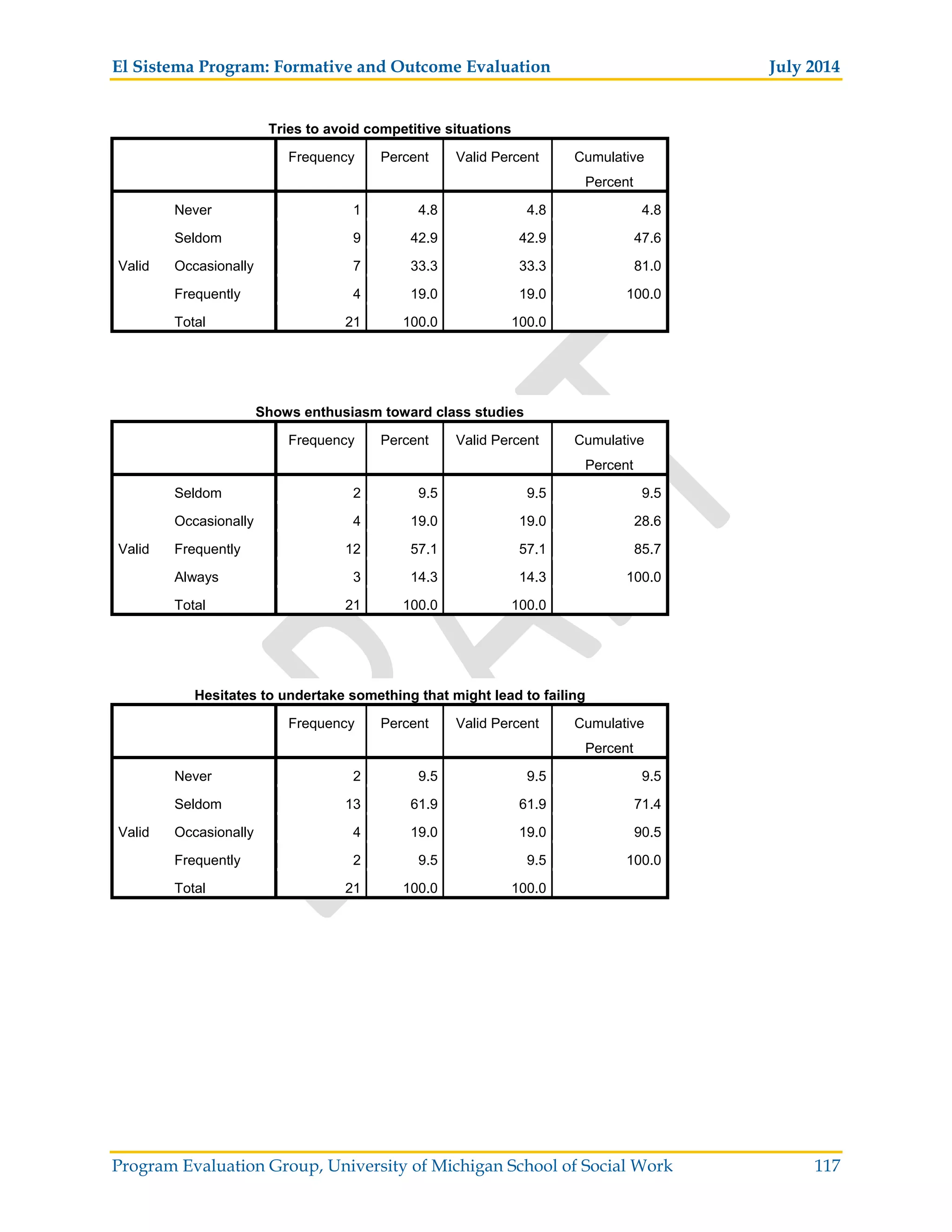
![El Sistema Program: Formative and Outcome Evaluation July 2014
Program Evaluation Group, University of Michigan School of Social Work 118
EL SISTEMA PARENT QUESTIONNAIRE
PRE-TEST RESPONSES
1. Learn and enjoy music
2. I hope he get better at playing the violin
3. It is very important that my child learn to play an instrument. I want her to be a
very smart student in music and other instruments.
4. A understanding and appreciation of various types of music from around the
world. To excel at playing the cello and to perform his instrument live in front of
an audience at a concert.
5. A more hands-on teaching experience for my daughter with the viola. I believe
this experience will lead to a greater knowledge and skill than she would get
otherwise.
6. A different experience…. More passion for music.
7. Encouragement to continue to learn music
8. I hope my child likes this program. I hope this program is just right for her and
teach her the viola. So that she can play like a Pro!
9. Able to play the violin;
Able to read notes;
Able to listen to notes and play back;
Able to use what she has learned and apply to viola and guitar, and mostly to
her life; Use music to connect with others.
10. An appreciation of music along with skills.
11. I hope [my child] learns to be more self-disciplined, and that she will develop a
more optimistic outlook on things.
12. The ability to learn and love music
13. Learn how to play viola;
Having the experience;
The commitment / Discipline
14. I want my daughter to appreciate better things in life – concerts, good music, etc.
Things beside the stupid things she watches on the TV/computer.
15. Confidence in music and herself. Love of music – classical, jazz, etc.
16. Learn to new music. Learn respect and patience for herself and the instrument.
17. I think that this program is good for the performance of my daughter as well as
for her intellectual skills. [English Translation – the response was provided in
Spanish]](https://image.slidesharecdn.com/9fe3a314-f4f1-49b9-be48-11714ceb9433-160508203325/75/El-Sistema-Formative-and-Outcome-Evaluation-Final-Report-DRAFT-071514-118-2048.jpg)
